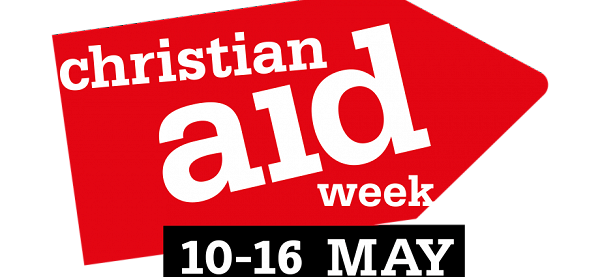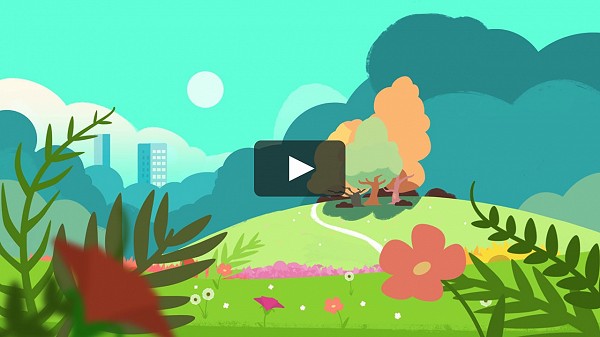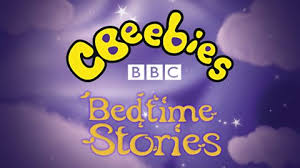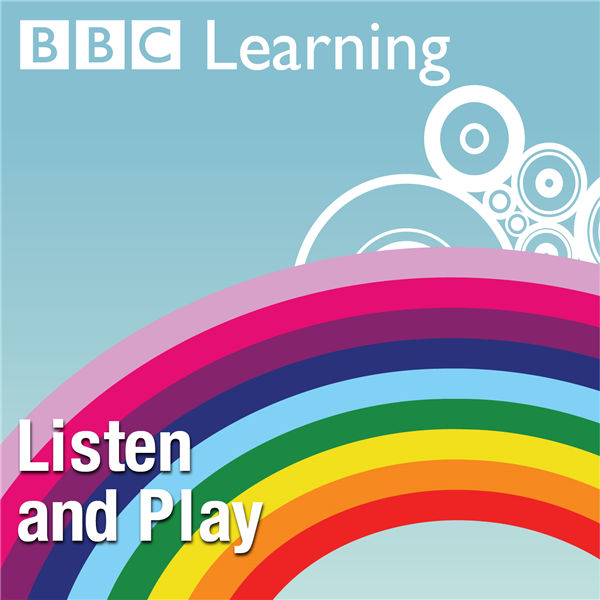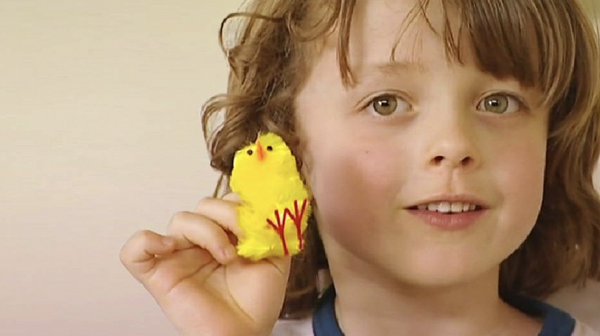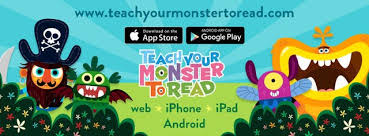Early Years
Google Classroom
From Monday 8th June all of your online learning will be found on Google Classroom. Please refer to the information sheet below to access your account.
Daily Activities
Reception children: Oxford Owl subscription
I have set up a class account for Barn Owls so you can access all the books on there easily. The books link to our phonics learning. Click on the My Class login icon which you can find on the top of the page:
class login: scsjbarnowls
password: letsread
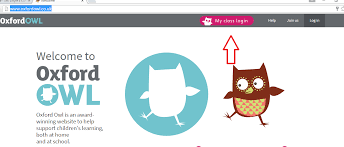
Reception children - support for writing
The powerpoint document below has lots of very useful information to help you to support your child with their writing. Please remember, drawing is really important, confident drawers become confident writers. Encourage your child to draw as much as they can, both small and large scale.
Reception children: Online phonics learning
We really encourage you to keep up some phonics and maths learning to help prepare for our return to school so Reception children can now take part in daily phonics sessions on youtube starting on Monday 27th April. These lessons are approved by the Department for Education and follow Letters and Sounds which we use at St Clement and St James.
The explanatory letter for parent/carers is included here
and this button should take you to the online lessons. Most children in Reception should be doing the daily Reception Summer Term online lessons which will be uploaded daily at 10am. Don't worry if you can't catch it live as lessons will stay up on youtube throughout the summer term, but do try to do them in order.
I will contact parent/carers of children who would benefit from focusing first on the Learning to Blend lessons which are live at 11am (and will again stay online all term).
Hope you enjoy them!
love Mrs Moran.x
Here is Luka, hard at work doing his daily phonics lesson. Keep it up Luka!
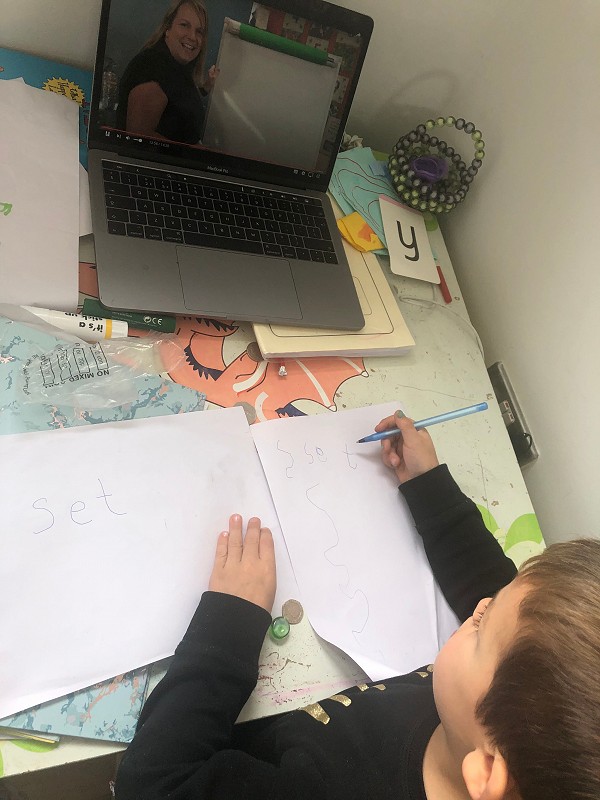
Daily activities for nursery and reception
Parent/carers: we know that these are very strange times and everyone is still finding their way.
Young children thrive on routine so it is important to try and create your own routines at home. We don't expect you to replicate our school day and it's much more important to keep you child happy, safe and loved. We would encourage you to play as much as possible with your children and to support them to be imaginative and create the world outside within your home.
Please read every day, try to keep active and encourage as much drawing as possible and writing for a purpose - name writing in Nursery and shopping lists and letters/cards for loved ones in Reception. Sing songs together and cook with your children. All of these activities help to develop physical, phonics and maths skills in young children.
In Nursery, you can explore Phase 1 phonics if you would like to. All of this learning is best done as part of play and games, there are some suggestions of how to do this below.
Reception children, we really encourage you to keep up some phonics and maths learning to help prepare for our return to school. There are daily maths learning routines below which would be good to carry on with every week day and of course Reception children are now able to take part in online phonics lessons on youtube (see above) or you can also use the phonics resources below. We will also upload weekly maths and phonics activities within the 'Week commencing' pages.
For all Early Years children we would like you to continue to complete our 102 indoor challenges. Complete as many as you can. Work your way through the list in any order and cross the box when you have finished it. You can always do it again if you enjoy it! Keep your list safe so you can bring it back to school when we are all back together again.
Parent/carers: remember your job is to encourage your child to be as independent as they can with each activity. You can support them through it and show them how to do it first, but remember we all need to give them the skills to be independent ready for September.
If you're in Reception and you usually wear shoes with laces to school then that challenge is especially important! We are hoping that this challenge sheet will help you all to spend some quality time together during this tricky period. Do let us know how you get on and any photos would be especially enjoyed by all the Early Years team! You can email them to: info@scsj.rbkc.sch.uk
Please remember, even though we can't be together we are still a team. Love to you all.x

Playdough recipe
Best Ever No-Cook Play Dough Recipe
- 2 cups plain flour
- 2 tablespoons vegetable oil (baby oil and coconut oil work too)
- 1/2 cup salt.
- 2 tablespoons cream of tartar.
- 1 to 1.5 cups boiling water (adding in a bit at a time until it feels just right)
- gel food colouring (optional)
Add all the dry ingredients to a bowl with the vegetable oil. Gradually mix in the water and food colouring. If you think the mixture is too sloppy you can add more flour, and if it seems too dry add more water. Once all the ingredients have mixed together knead for a couple of minutes. Now your play dough is ready to use. What will you make?
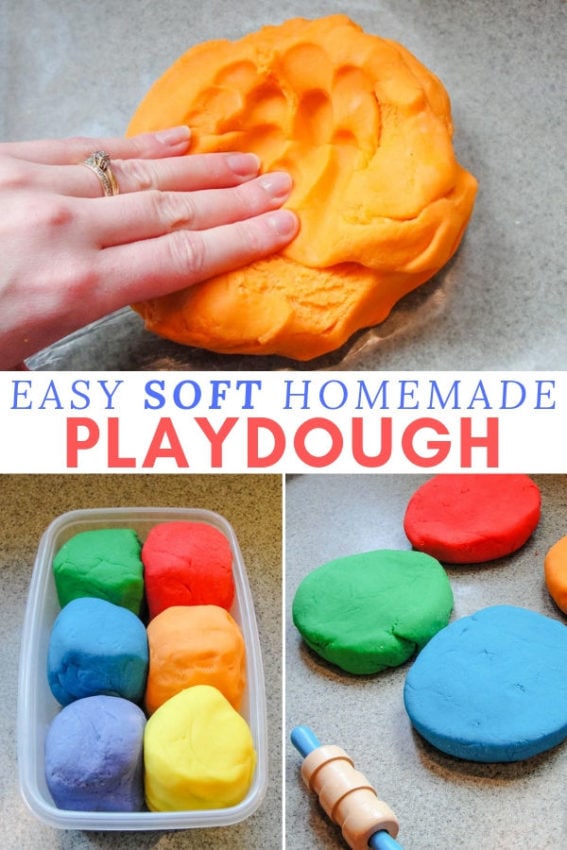
Brain Break
Please take some time each day for a brain break to help you calm and relax ready for learning. Ideally this should be first thing in the morning, after lunch and at about 3 o'clock just like we do in school. You can practise along with Ms Afzal (Uz) by using this link:
Communication and Language (listening, understanding and speaking)
I CAN (the Communication Charity) has some brilliant play ideas to help develop listening, understanding and speaking skills in young children. They are brilliant for Little Owls but they also have ideas for Barn Owls.
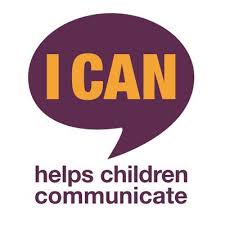
Keeping Active
If you can't get outside because you don't have a balcony or garden please have your windows open to let in some fresh air. It's important to keep moving too. You can go out for short walks as long as you stay close to your parent/carers and away from others. For exercise at home, we highly recommend Cosmic Kids Yoga on youtube:
![]()
Reading for Early Years
Please take the time to share stories together. The more wonderful stories you share, the more you help to develop a lifelong love of reading for pleasure and the better a writer children will become. It's also so important during these stressful times to develop a loving, nurturing reading routine.
You can access books online at Oxford Owl who have free e-books which link to our phonics learning. I have set up a school account which you can access by clicking on the link below. Then click on the My Class login icon which you can find on the top of the page:
class login: scsjbarnowls
password: letsread
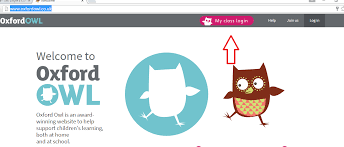
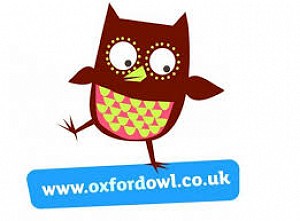
There are some lovely stories on CBeebies:
https://www.bbc.co.uk/iplayer/episodes/b00jdlm2/cbeebies-bedtime-stories
Amazon is offering free audio books for children:
https://stories.audible.com/di...
Phonics in Nursery
This is the most important stage of your child’s reading journey and supports children in developing their phonological awareness (their awareness of different sounds). During Phase 1, children explore and experiment with sounds and become familiar with rhythm, rhyme, alliteration and learn oral blending and segmenting.
Phase 1 is broken down into 7 different aspects which you should go through in order from 1 to 7, making sure that your child is secure in each aspect before you move on to the next:
Aspect 1: Environmental Sounds
The aim of this aspect is to raise children’s awareness of the sounds around them and to develop their listening skills. Talking about the sounds they can hear out of the window (eg: a bird tweeting, car driving) are ways you can support your child with this.
Aspect 2: Instrumental Sounds
During this aspect, children are encouraged to explore and play with a range of different instruments to compare and match the different sounds that they make. You can play games involving loud and quiet instruments and ask your child to identify which particular instrument is being played.
Aspect 3: Body Percussion
In aspect 3, children are encouraged to explore the different sounds that they can make with their body. You can support your child by playing games with lots of stamping, copying clapping patterns and patting different body parts!
Aspect 4: Rhythm and Rhyme
This aspect aims to develop children’s appreciation of rhythm and rhyme in speech. You can support your child with this by engaging in silly rhyming activities, making up rhymes and reading plenty of stories at home (particularly Julia Donaldson or Dr Seuss).
Aspect 5: Alliteration
This aspect focuses on the initial sound of words (such as in your child's name). Activities such as phoneme I-Spy (using sound rather than letter to identify an object) are great for supporting your child with this as home.
Aspect 6: Voice Sounds
Here the children are encouraged to distinguish between different vocal sounds and begin oral blending and segmenting. Children are encouraged to make silly noises and sounds in a range of different ways and pitches (eg: can you say your name really high, or can you whisper it).
Aspect 7: Oral Blending and Segmenting
This is a vital final step for Phase 1 and prepares children for phonics learning in Reception. To support your child with this, you might ask them to pass you a c-u-p (cup). Children who are then able to blend these sounds together and know you are asking for a cup are in a really great position to begin matching sounds to their written representation in order to being to read and write.
Daily Phonics for Reception
Daily phonics practice. Please keep practising your sounds daily. A pdf of our sounds is below but remember you can sing to help you to remember.
You can sing along with our phonics songs here:
https://www.bing.com/videos/se...
If you're not sure how to pronounce each sound, the Lady with the Lips is a fantastic guide:
Here is a powerpoint of all of our sounds. Please go through all of the sounds, making sure you say the sounds clearly and use your actions.
It's also important to keep practising our high frequency (or tricky) words. Here is a pdf of all the words you need to know in reception:
Please practise blending words daily. You can make your own CVC (consonant vowel consonant) words on card for example: cat c-a-t, remembering to put sound buttons underneath each individual sound.
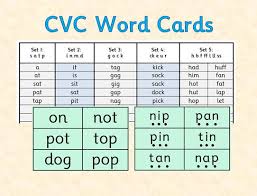
Here is a bank of suggested words for you to practise blending.
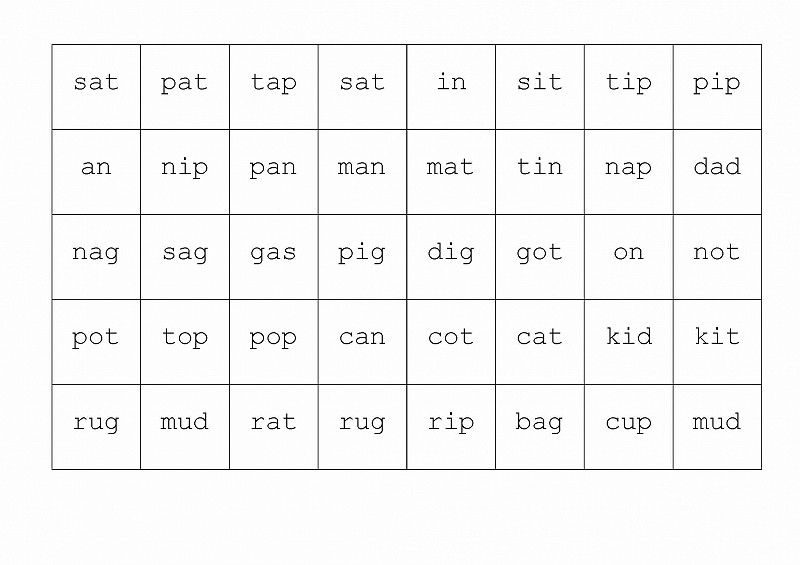
You can also practise your blending on ictgames.com
Forest Phonics, Help a Hedgehog and Poop Deck Pirates
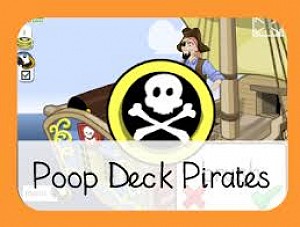
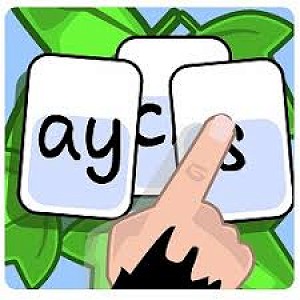
Writing in Reception
When you're ready to write, please use our sound mats and high frequency words mat to help you. To check how to form your letters correctly, use our letter formation rhymes.
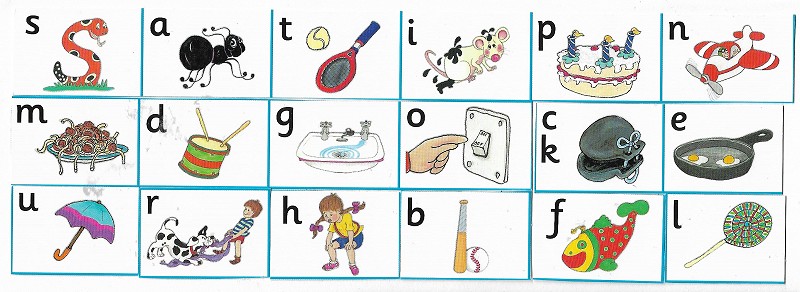
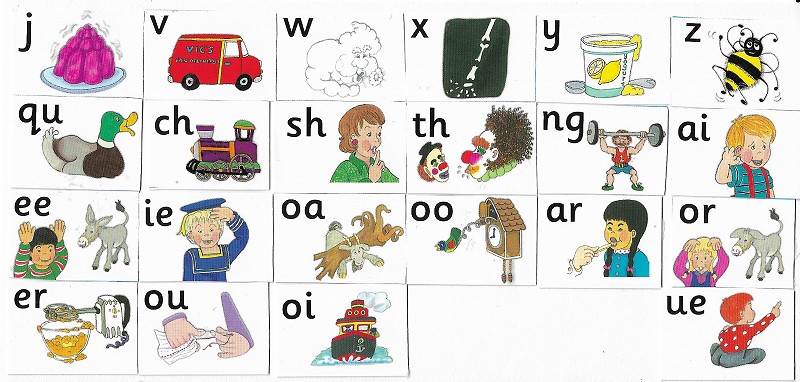
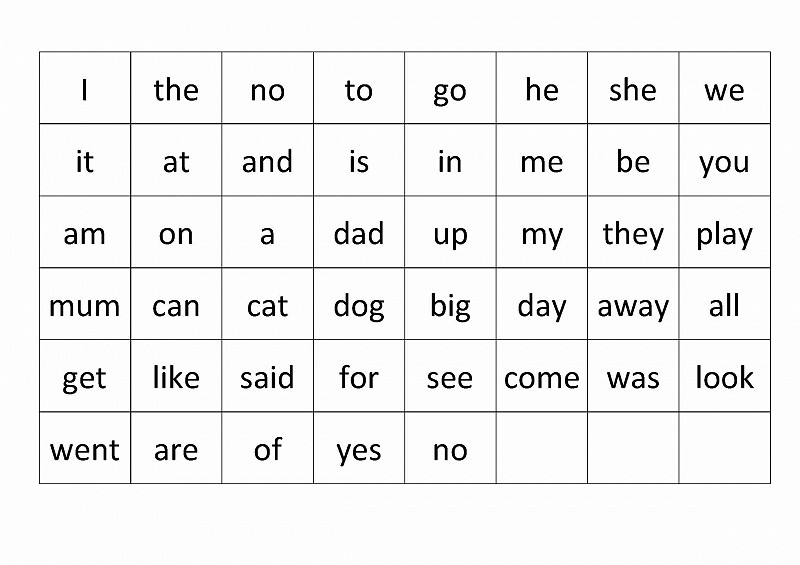
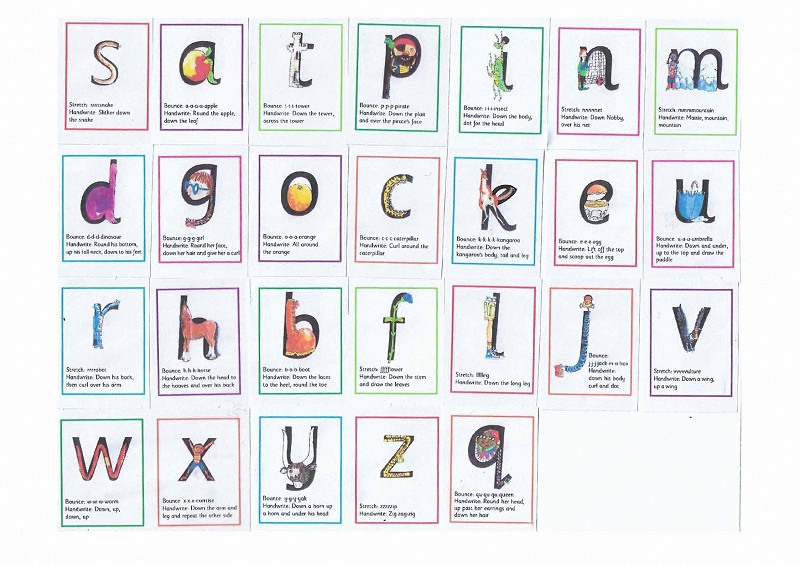
Daily Maths for Nursery
Use the date chart daily, singing the days of the week. Can you find the word that shows the day today?
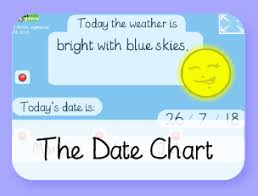
Sing along daily with Zero Superhero. Can you use your fingers to count up to 10 and back down to zero?
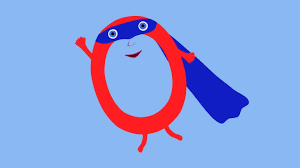
Watch an episode from Series 1 of Numberblocks a day. Can you then make a collection of 1,2,3,4 or 5 objects? Can you show that number on your fingers?
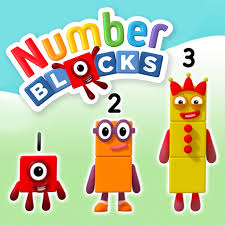
Daily Maths for Reception
Use the Date Chart daily, singing out the days of the week and months of the year.
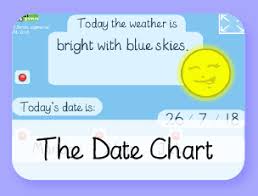
Sing along with our Counting to 20 song.
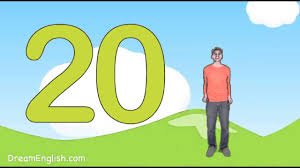
Recite number names from 0 to 20 and back again, using a number line to point to. You can also start at any point on the number line and count back to any number.

After you have done this introduction you can go on to undertake our weekly Maths challenge in the Week Commencing section.
Our school prayers
Before lunch, can you sing our lunchtime prayer?
Lunchtime Prayer
Thank you for the world so sweet,
Thank you for the food we eat,
Thank you for the birds that sing,
Thank you God for everything.
Amen.
And at the end of the day, please keep saying our School Prayer:
Our School Prayer
Lord of the loving heart,
May ours be loving too.
Lord of the gentle hands,
May ours be gentle too.
Lord of the willing feet,
May ours be willing too.
So may we grow more like you,
in all we say and do.
Amen
Week Commencing 8th June 2020
Week Commencing 1st June 2020
Thursday 4th June
Hello parent/carers. Hope you're all doing well. You should have received an email invitation to Google Classroom yesterday (Wednesday). It's our new online learning platform and from next week we will be sharing learning there rather than on the class page.
Please click on the invitation to access the SCSJ Nursery/Reception classroom for your child. Just like this page, learning will be for both classes. Miss Prideaux (the year 6 teacher) has kindly made a guide to Google Classrooms for you. Please do have a watch, but remember that learning on our classroom will be a bit different to the learning in the classroom Miss Prideaux is showing you but we WILL be uploading new learning every day.
Welcome back!
Welcome back Barn Owls and Little Owls. We hope you had a good half-term with your family. It's a new month! But what else has changed? Watch this to find out.
This week's news
Jayden has been having lots of fun finding dandelion clocks by the canal. Did you blow your clock Jayden? What time did your clock say it was?
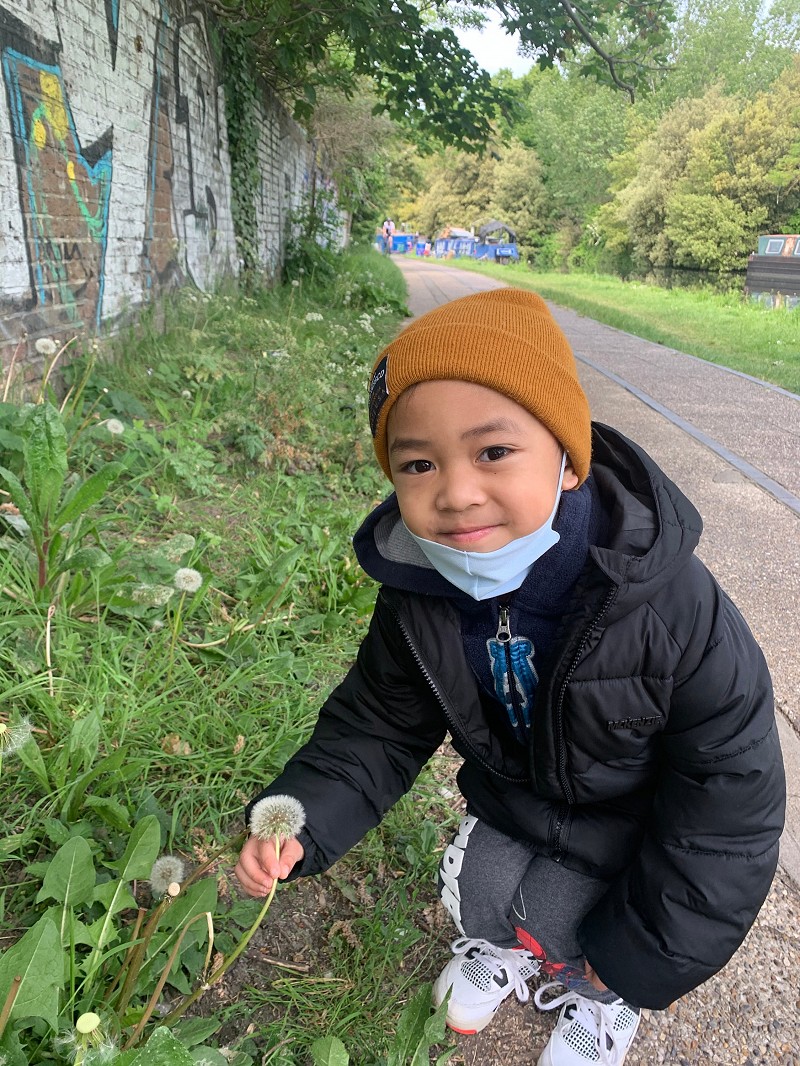
Lovely Learning
Bertie has been extra busy experimenting with different cameras. The first photo was taken with an old 1950s camera and the second shows Bertie about to take a shot with a 1980s camera that uses proper film and you have to focus yourself so it's not blurry. Well done Bertie, can't wait to see how it turns out!
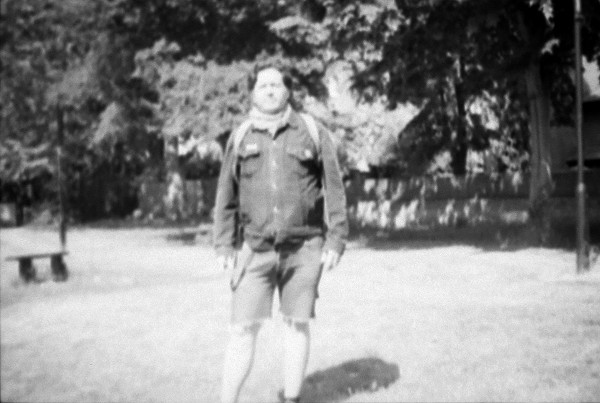
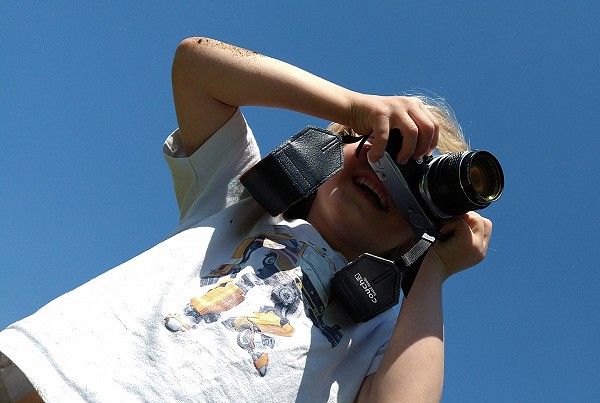
Core Text: The Growing Story by Ruth Krauss and Helen Oxenbury
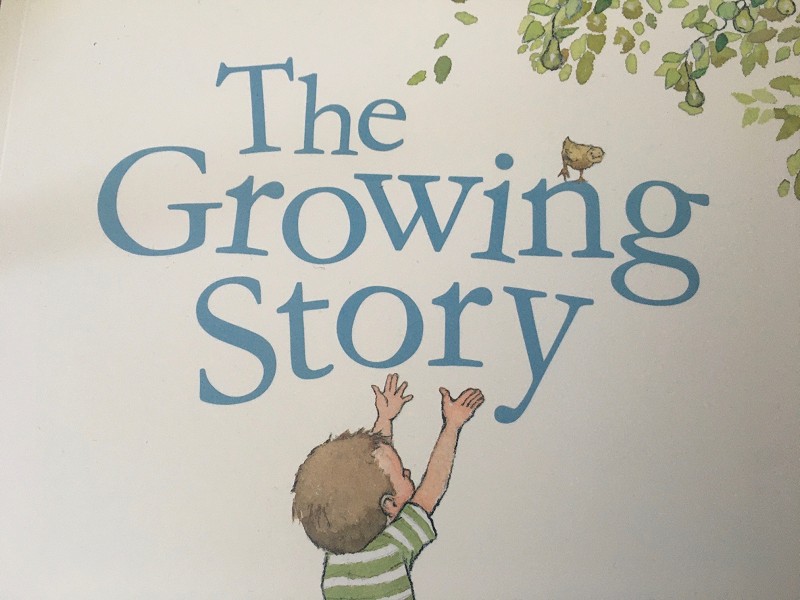
Do you know that you grow a little bit every single day?
Our core text this week is The Growing Story by Ruth Krauss and Helen Oxenbury.
Please watch and then do some of the activities below:
- Have a sort through your clothes. Are some of them too little, too tight or too short? That means you've grown! Do you have a younger brother/sister or cousin or little friend you can give them to? Put them in a box or a bag until you can see them again. (Barn Owls: can you write a note to say what's inside?)
- See if you can find some photos of you when you were a baby. What could you do when you were very little?
- Draw you when you were a baby and you now. What can you do now you are big?
- Make a time-line for you. Find a photo from when you were a baby and then one for each year: 1,2,3 (and 4 and 5 if that's how old you are). Stick them onto paper in order and then have a think about what you could do when you were each age. Ask your mummy/daddy or whoever looks after you to write exactly what you say. We'd love to see your finished time-line! There's a template to help you below.
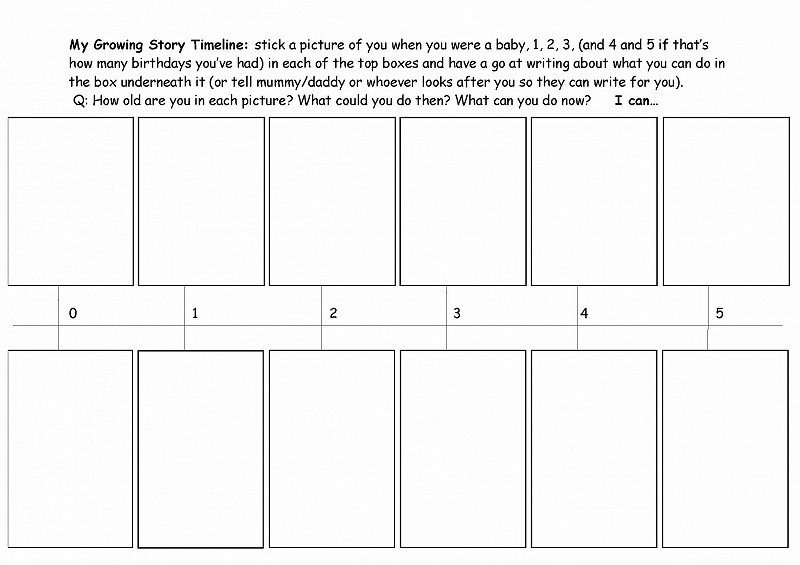
- Can you do a somersault or cartwheel like the boy in the story? Find a big space to do it in, outdoors is best. Keep practising, because the more you try, the better you get!
- Look at the pictures of the boy, puppy and chicks. Can you see how they have grown? What is different about them?
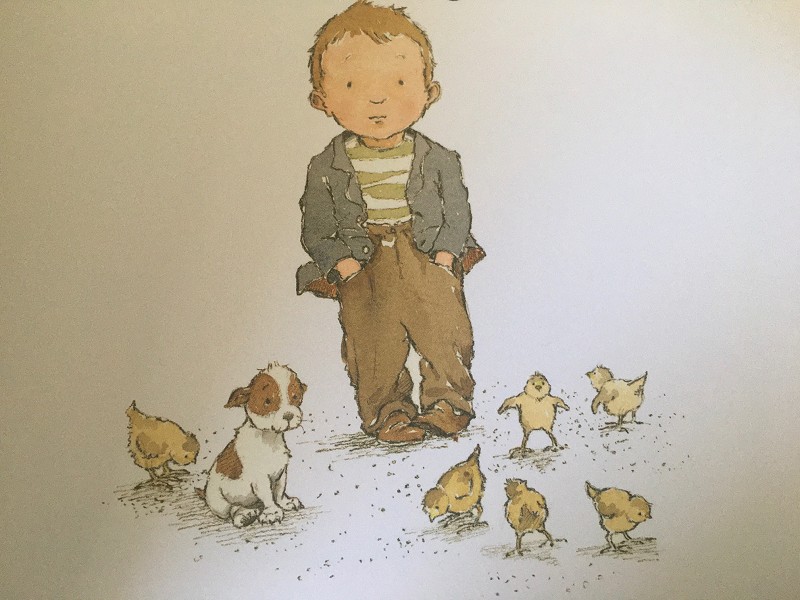
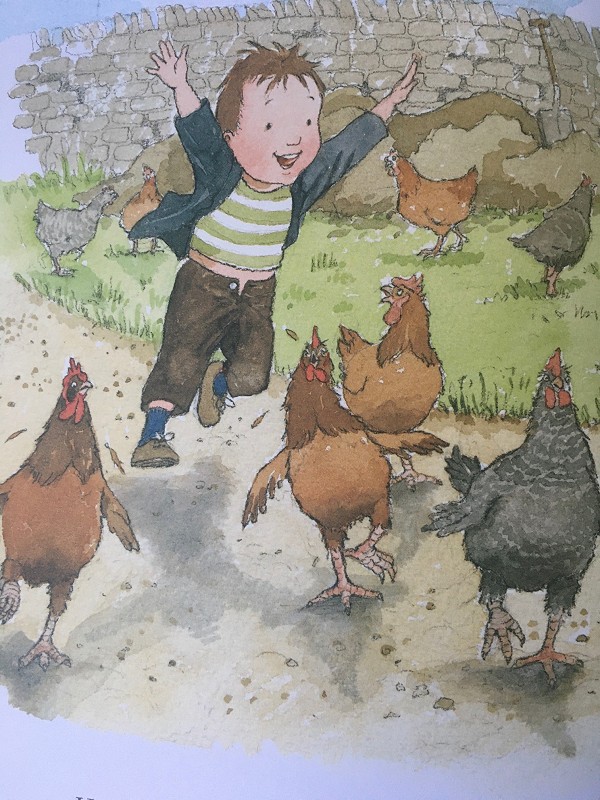
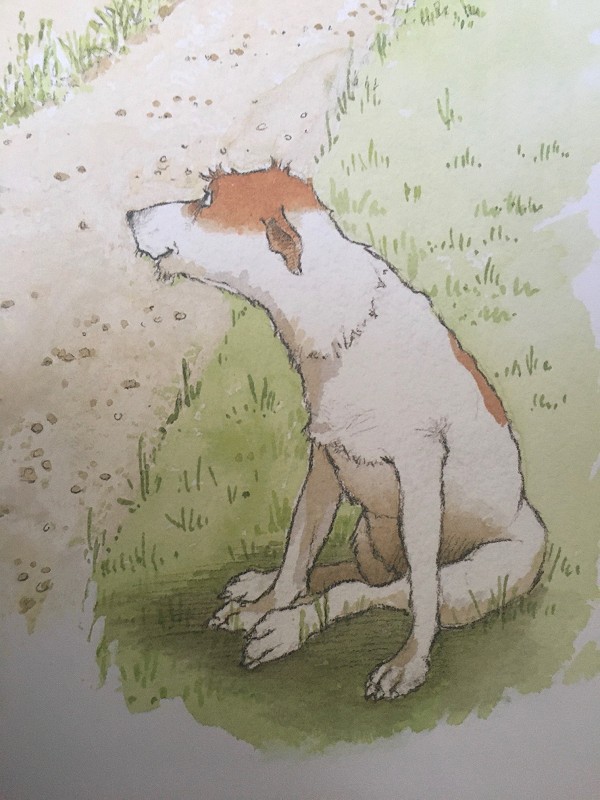
Phonics for Reception
Practise writing these words from the story using your sounds:
- boy
- puppy
- dog
- chick
- chicken
- box
- day
- night
- little
- big
- chair
- grow
Parent/carers, please don't worry if your child writes some words differently. This is ok! Pupee for puppy, groa for grow and litl for little are all fine for Reception because your child is using their sounds to write. Remember to give lots of praise when your child tries their best!
Maths Learning
There's a lovely NRich activity which you can do to explore length: it's called How Long Are You? and there's a pdf of it below. We hope you have lots of fun measuring yourself in lots of different ways.
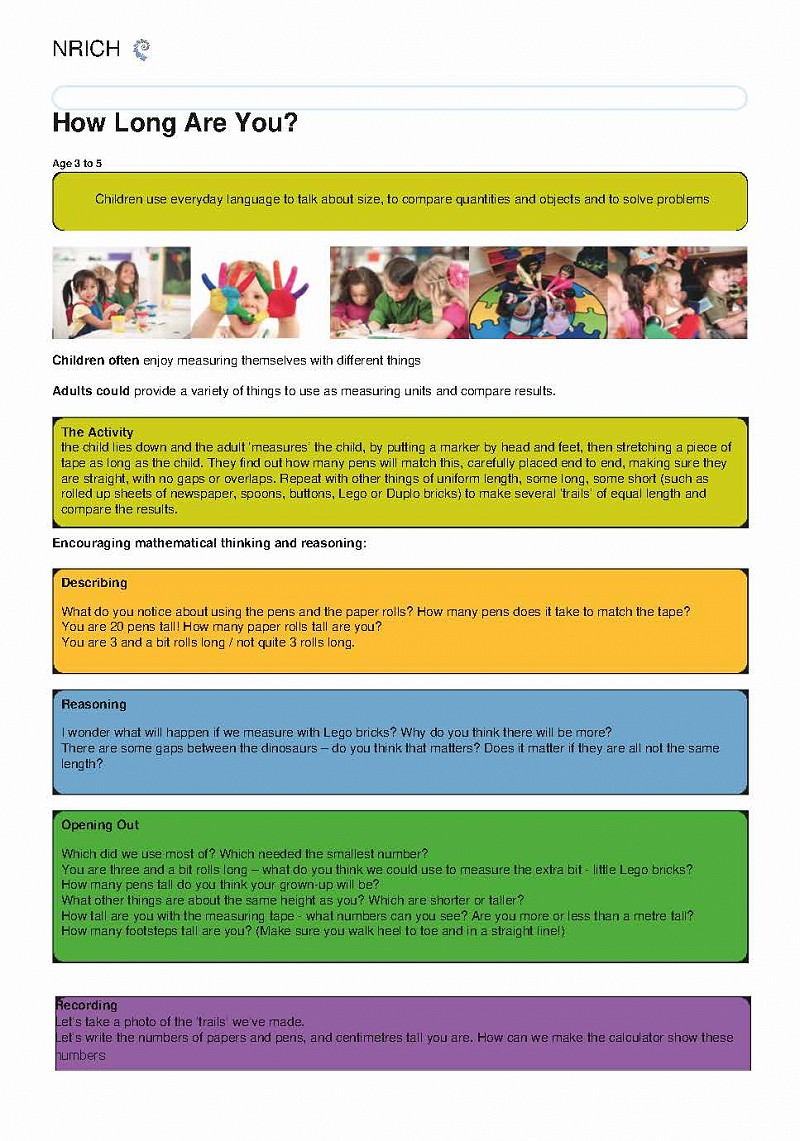
Just like the boy in The Growing Story, you've been growing too! We bet you've grown so much since we last saw you!
This half-term is seven weeks long. How much do you think you will grow in seven weeks? Let's find out! Your challenge is to get your mummy or daddy or whoever looks after you to mark how tall you are in a line against a door or wall. They can do this by putting a big book on top of your head and drawing the line where the book meets the door or wall!
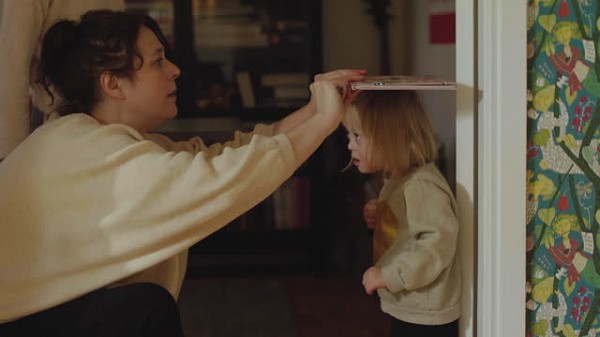
If you have a tape measure in your house, measure from the bottom of the door or wall straight up to the line to see how tall you are. Can you read the numbers on the tape measure? What do you think they mean?
We're going to play an estimating game: how much do you think you will grow by the big summer holiday? Ask you mummy, daddy or whoever looks after you to mark on the door or wall where you think you'll be up to. We're going to measure again at the end of term!
Barn Owls Challenge: See if you can write your name, the date and how tall you are like this:
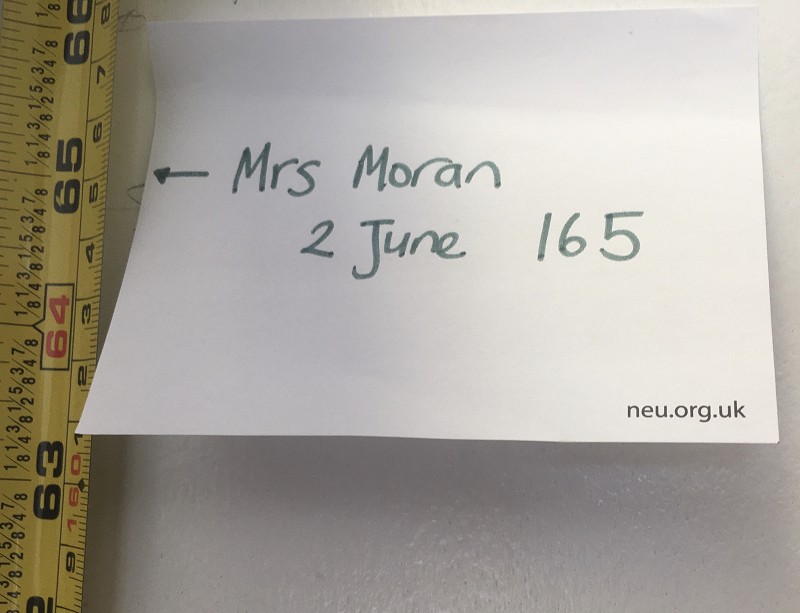
Keep your writing somewhere safe - you're going to need it again when you measure to see how you've grown!
Week Commencing 18th May 2020
Eid Celebrations

All of the Early Years team would like to wish 'Eid Mubarak' (Blessed or Happy Eid) to all of our Muslim families.
Eid-al-Fitr is happening on the first weekend of the half-term holiday (Saturday 23rd-Sunday 24th May) when the new (or crescent) moon is in the sky and is a special celebration (or party) to mark the end of Ramadan. We hope you all enjoy your celebration and would love to hear about how you have celebrated with your families.
CBeebies Let's Celebrate explains more about the Eid celebration and shows how Amirah gets ready - but it is a little different this year because of the Coronavirus so families won't be able to attend their mosque at this very special time and will pray at home instead. Eid is a little like Christmas, Diwali, Hanukkah or Chinese New Year - people wear special new clothes, give presents and share food with their families. Find out more by clicking on the link below.
For half term
We won't be putting any new learning up on our class page over half term but below is a home learning challenge for you.
We know it's still very difficult for everyone and you are all missing your friends and adults at the school so here is a story for you. It's about how we can still show love even when we can't hug. Hope you love it as much as we all do
Wishing you a restful half-term break
Love the Early Years Team.x
News
Look at Wilf's amazing bean plant. It’s now growing a fourth stem, more like a bean bush! Hasn’t grown any taller than 33cm. It is growing 8 lovely bean pods than are nice and thick. Some are still small but the largest one is 4cm long.
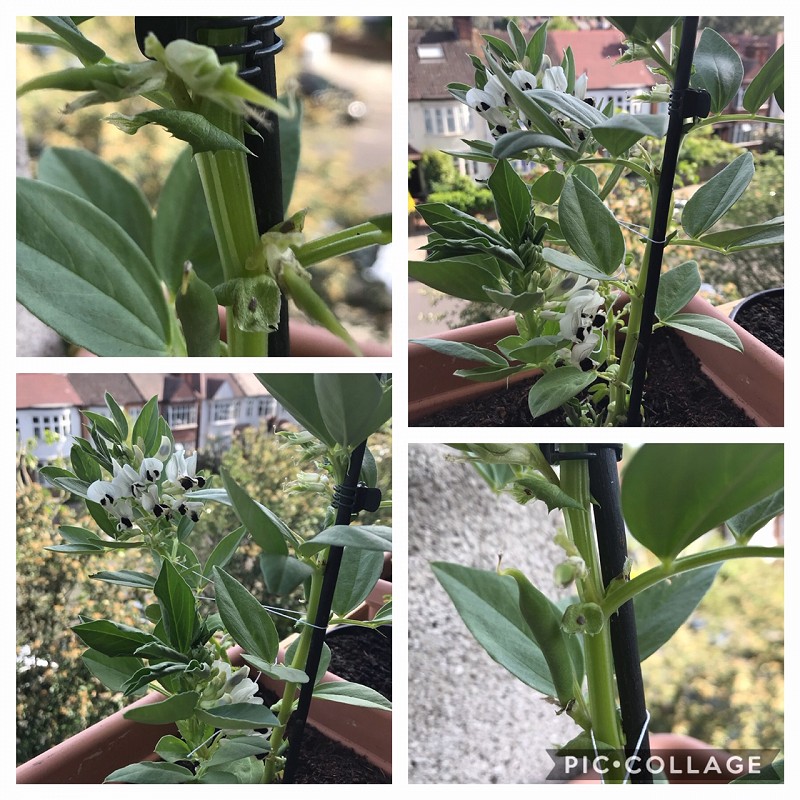
Story for Friday
This story is a 2 for 1! It's all about plants that explode (!) and plants that are helped by humans. Please watch.
Friday challenge:
Have a think about how we helped our beans to grow into bean plants.
What were the steps we took - what did we do first, then, last? Draw what we did and for a challenge use your sounds to label your drawing.
Lovely Learning
Shyla-Rae has been busy making Paw Patrol cupcakes. Wow Shyla-Rae! Those look delicious. What fabulous egg-cracking, whisking, icing action. And so independent! Keep up your lovely learning!
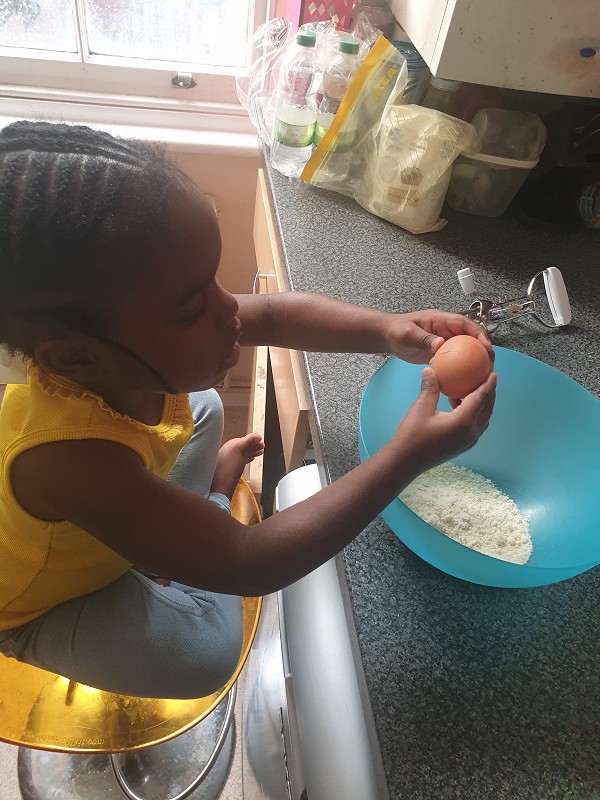
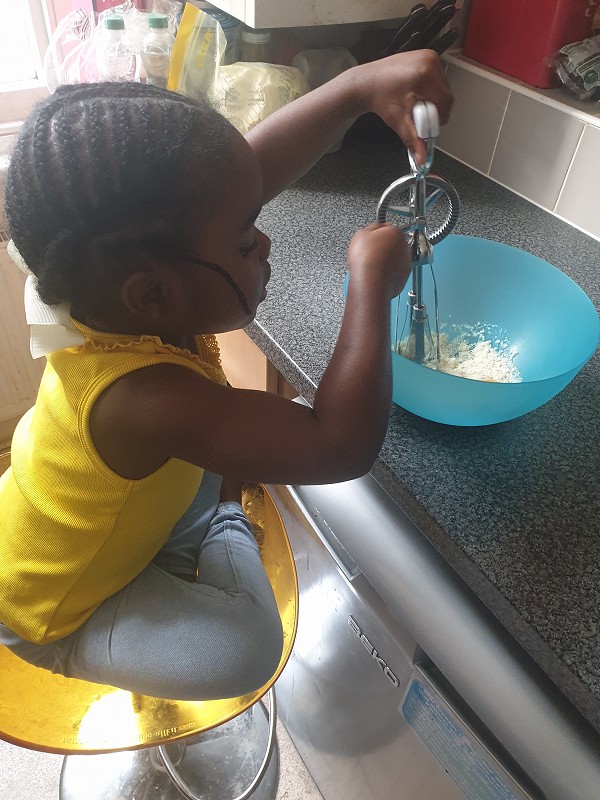
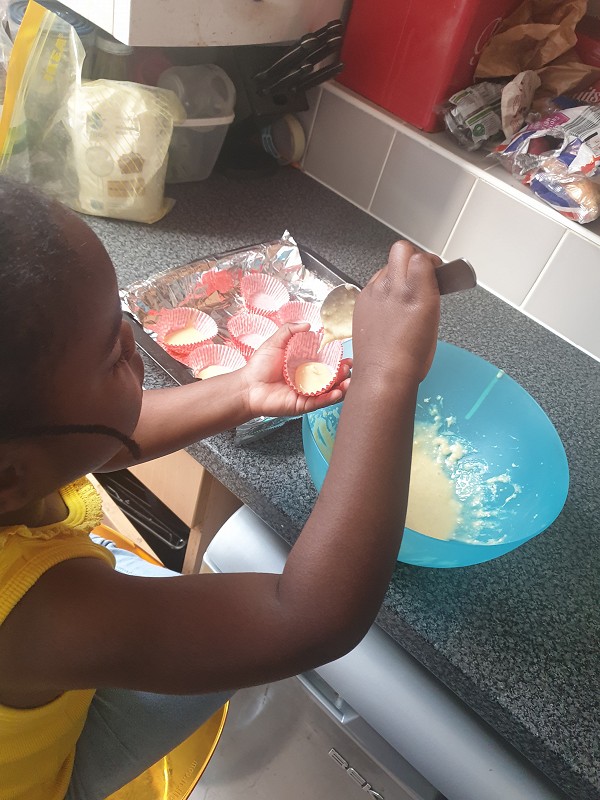

(Parents/carers: Shyla-Rae is using a rotary whisk to whisk up her cupcake batter. If you have one of these, please let your children use them - they help to build up muscles in the arm, wrist, hand and fingers that children need for drawing and writing. For another great activity using whisks click on the button below).
sensory soap with a rotary whisk
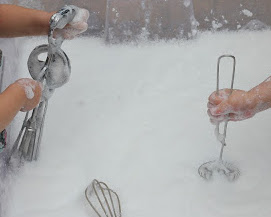
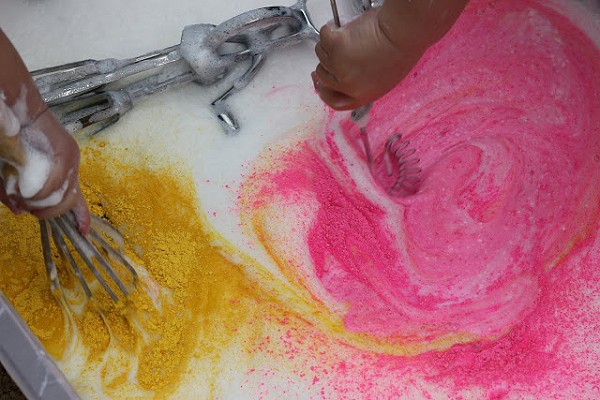
Meanwhile, Jayden has been baking 14 rolls to share with his friend Gekko. Did you share fairly though Jayden? Early Years, what do you think? How can Jayden share his rolls fairly so both friends have the same?
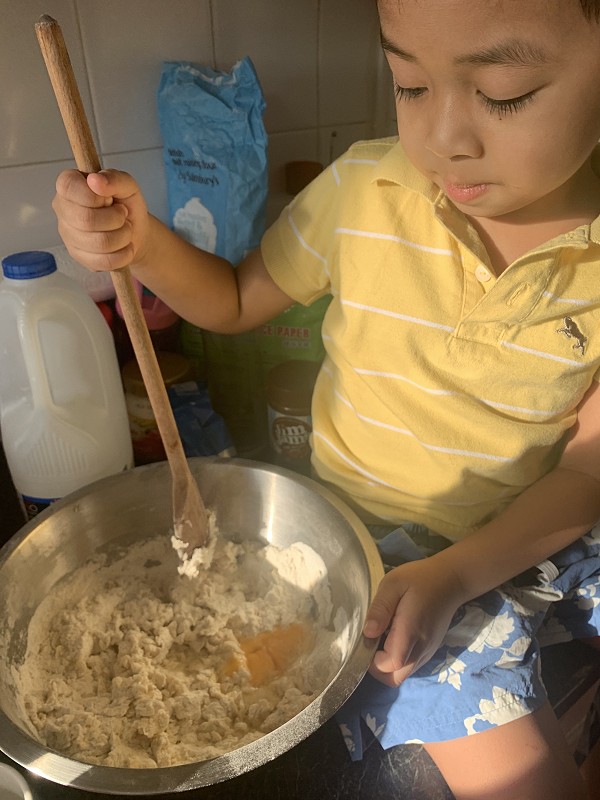
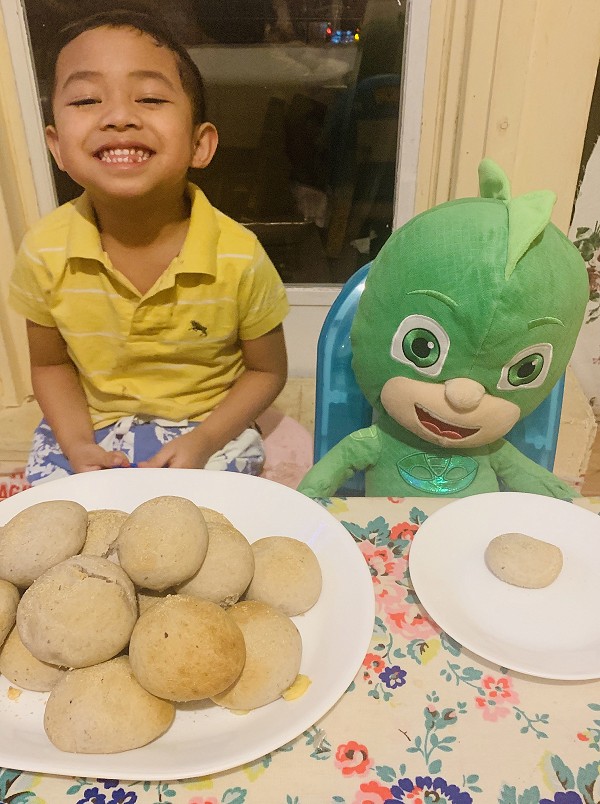
Barn Owls Maths Challenge: find 14 objects and pretend they are Jayden's rolls. Share them between two plates. How many will Jayden and his friend have each? What if Jayden's mummy is a bit hungry too?
Core Text: From Tiny Seeds...The Amazing Story of How Plants Travel
Our core text this week is a non-fiction book - that means it is a story, but it is a real story. I will be reading a section (a little bit) every day. It's a very beautiful book, and is extra special because the author (the person who writes all the words) is also the illustrator (the person who draws all of the pictures). Hope you like it!
Here is the front cover and the back cover with all the blurb (the writing that tells you what the book is about):
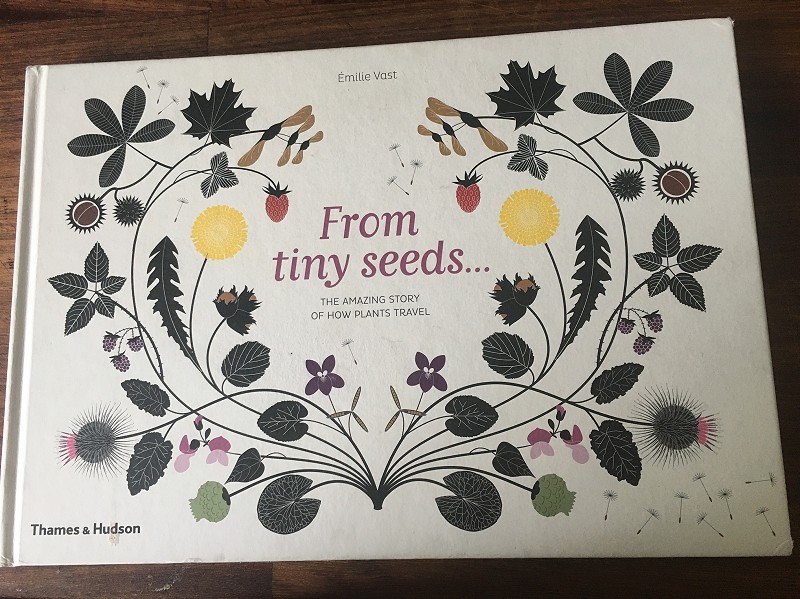
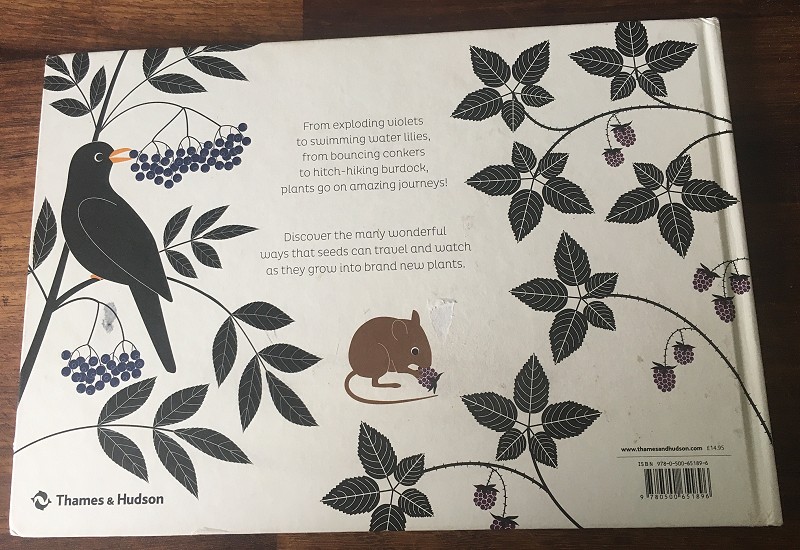
Story for Monday
Flying: an amazing travelling seed
This is a time lapse (lots of photos taken over a long time and joined together so what happens seems like it's very fast) of a dandelion plant growing and turning into a dandelion clock. It doesn't happen this quickly so if you do have any dandelions be patient!
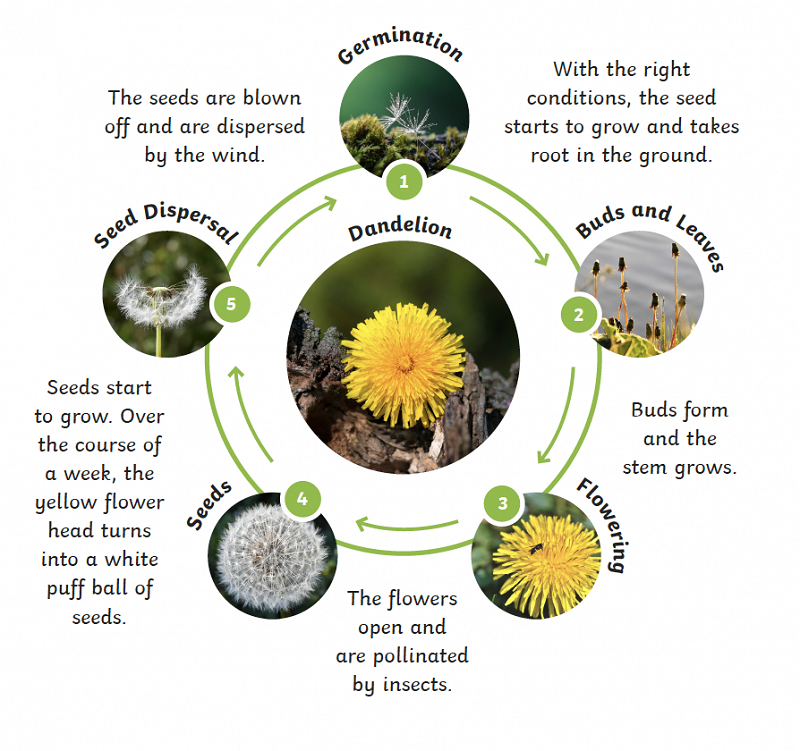
Niamh and Hugo (Mrs Moran's children) found these beautiful dandelions when they were out for a walk
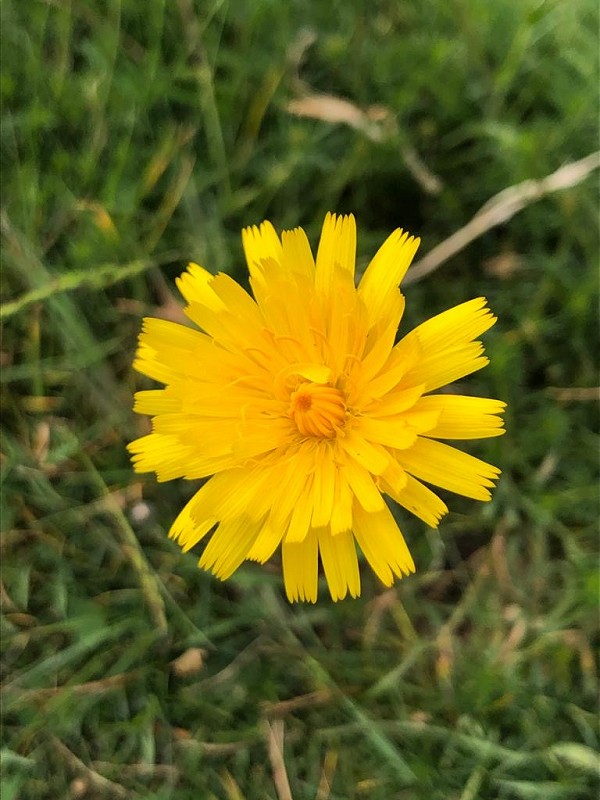
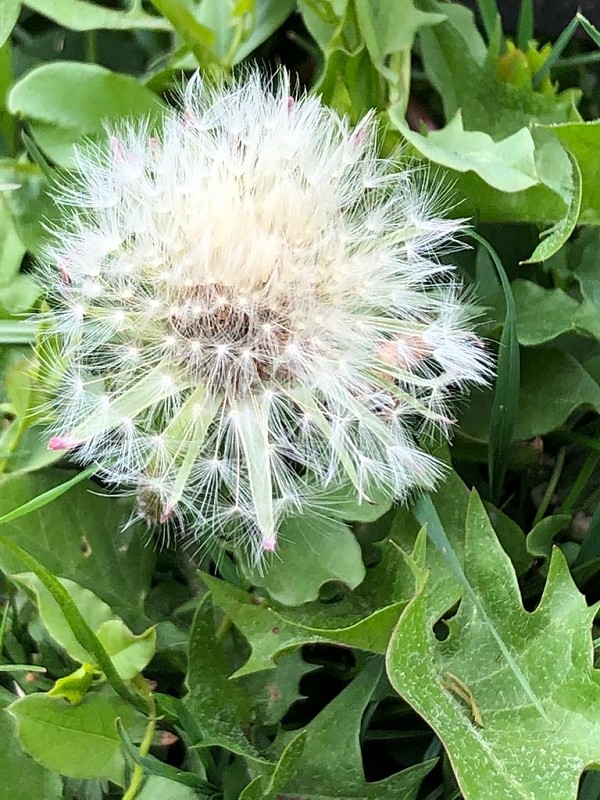
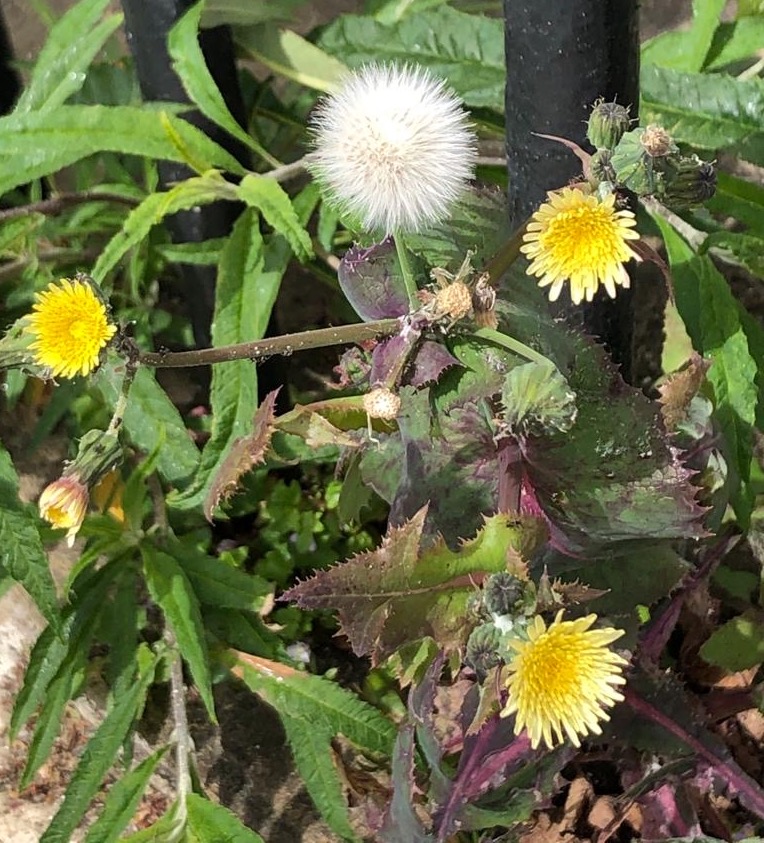
If you're able to get out on a daily walk, see if you can find any dandelions growing. Dandelion clocks happen when the seeds are getting ready to fly away. You can play a game where you tell the time using a dandelion clock by blowing the seeds so they all fly away. If it takes 1 blow it's 1 o'clock, 2 blows for 2 o'clock and so on. Niamh said it was absolutely definitely 4 o'clock!
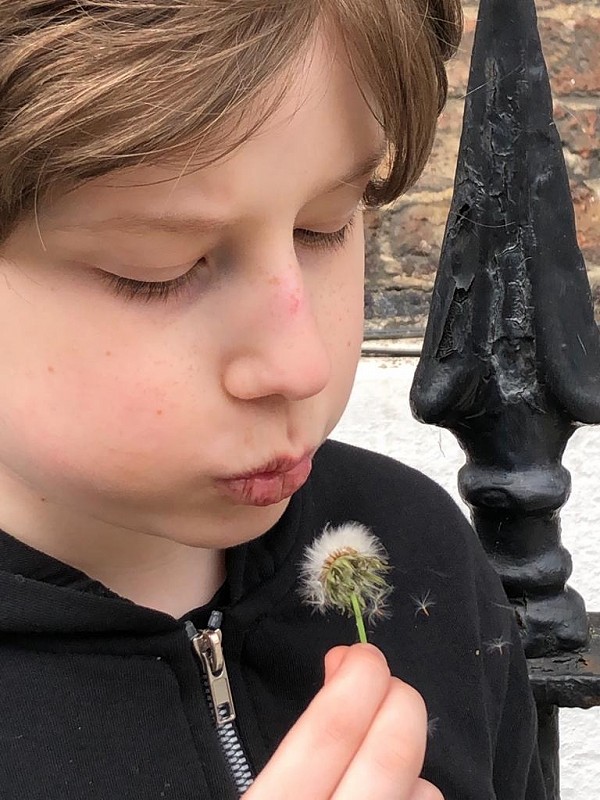
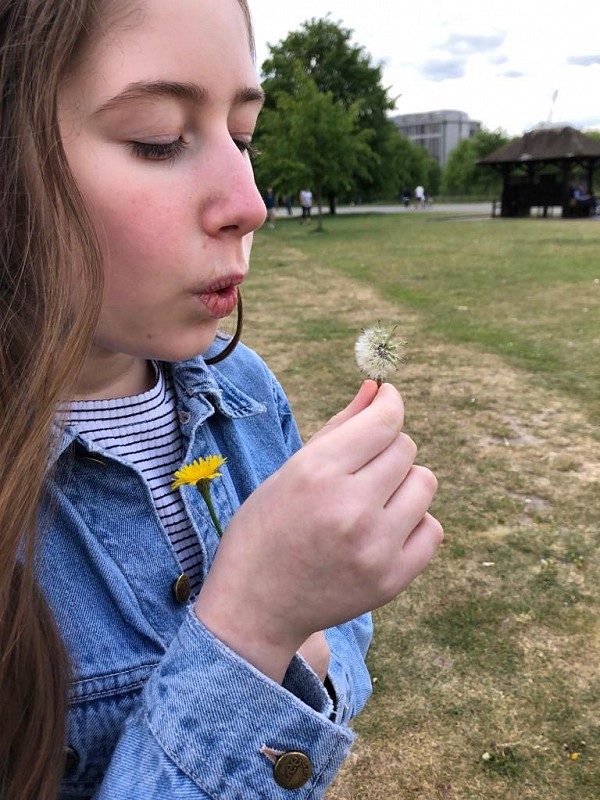
Have a go and maybe send us a photo to: info@scsj.rbkc.sch.uk
Luka L. and Lana have been out blowing dandelion clocks: What's the time Luka?
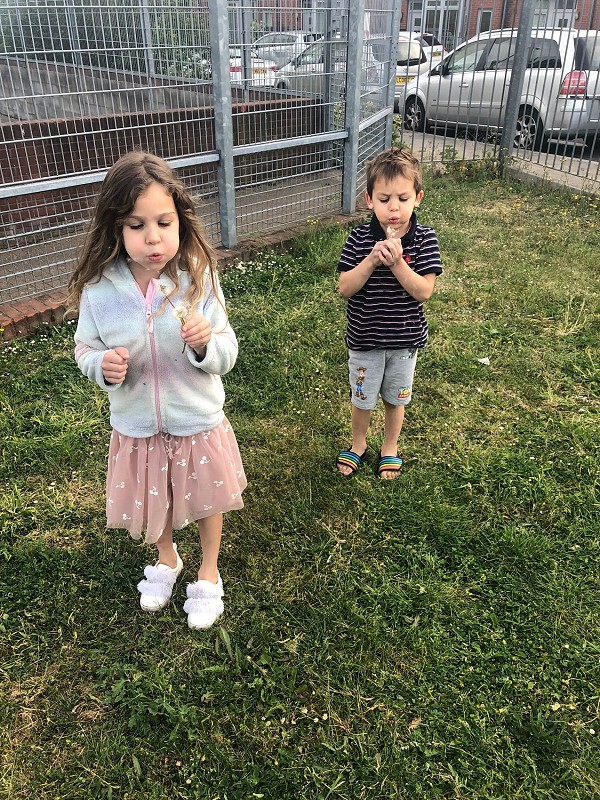
Dandelions are very important for our planet. They are only little flowers but they help other animals to do important jobs and to keep us fed. Did you know that bees love dandelions? And honey bees make delicious honey for us to eat on porridge and toast when we have nurture groups at school. Yum!
Watch this video to see bees pollinating dandelion flowers. Pollen sticks on their feet and they carry it to the next flower which pollinates it (making it change into a dandelion clock). Bees take nectar and pollen from the dandelion back to their bee hive (their home) to make honey with:
Do you feel like getting creative?
Here's a dandelion painting challenge for you - but mummies, daddies and people who look after you may have to help a little bit!
You will need:
- toilet roll
- scissors
- white paint
- black paper
- cotton buds tied with an elastic band
I think the lady has a bit of a cough - but that's ok because she's looking after herself and will get better soon (maybe she needs some honey and lemon tea!)
Story for Tuesday
Today's story is all about creeping plants:
Here's what a strawberry looks like as it grows:
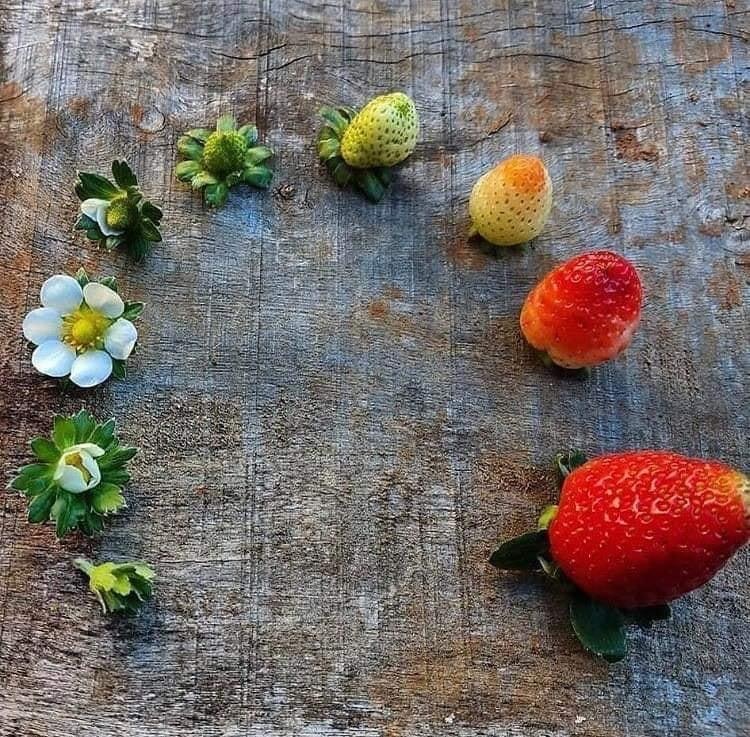
I've got a creeping plant growing in my garden - it's a raspberry plant - well actually lots of raspberry plants because they're creeping across my garden! My plants are just starting to get flowers, look! What do you think will happen to the plant next? (have a think about the life cycle that happens again and again - what happens after flowers begin to grow?)
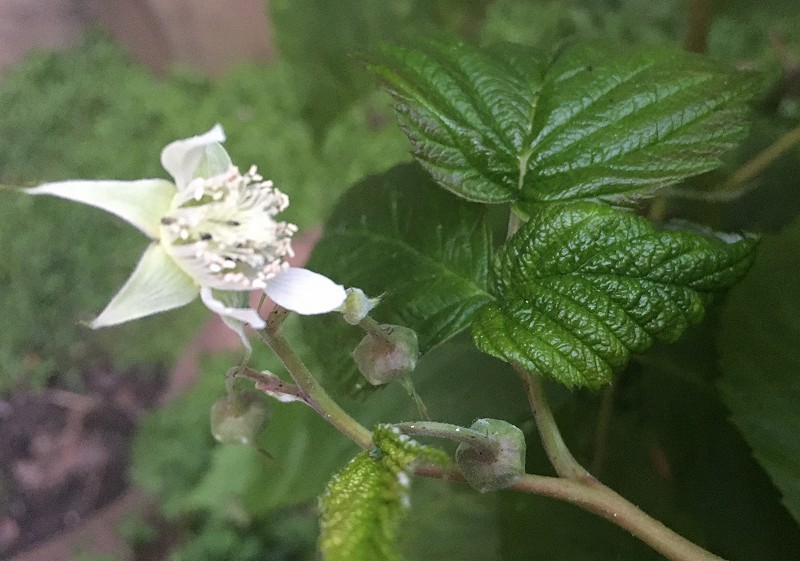
Story for Wednesday
Today's story is all about falling, spinning and bouncing seeds:
Here are some acorns and conkers. Do you remember seeing them in our classroom in our Autumn basket?
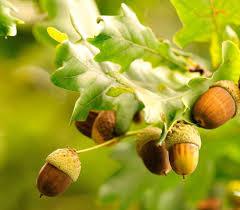
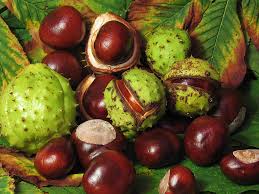
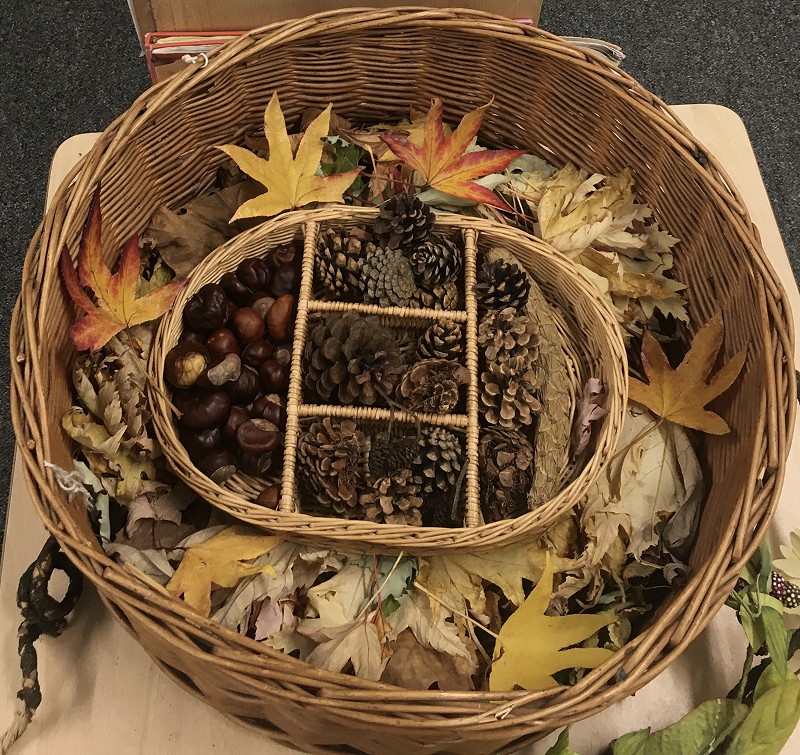
Watch these videos about a year in the life of sycamore, oak and horse chestnut trees:
Story for Thursday
Today's story is all about seeds that are spread by being eaten:
Watch Lyra from Bath going blackberry picking with her mum:
How do you think all of those blackberry plants got there? Can you remember what happened in the story and how the seeds are spread? Tell your mummy, daddy or whoever looks after you.
Maths Learning
Dandelion clocks are lots of fun but not very good for telling the time. When you get big, you'll learn how to tell the time using a clock or a watch.
- Play 'What's the Time Mr Wolf?' with your family. You need enough space to do big steps so you might need to do it outdoors. Remember when 'Mr Wolf' says the time you do that many steps towards him. So if he says, '4 o'clock!' you need to do 4 steps. And if he says, 'Dinner time!' then run!
- See if you can find a clock in your house and have a look if you can see any numbers on it. Can you read them?
- Ask an adult to read the time for you and show you what the clock says.
- Can you draw a clock? Remember to put the numbers on it if it has them.
- Does your clock have hands and a face or does it just have numbers?
Clocks and watches are everywhere and can look very different. Here are some clocks and watches in Mrs Moran's house.
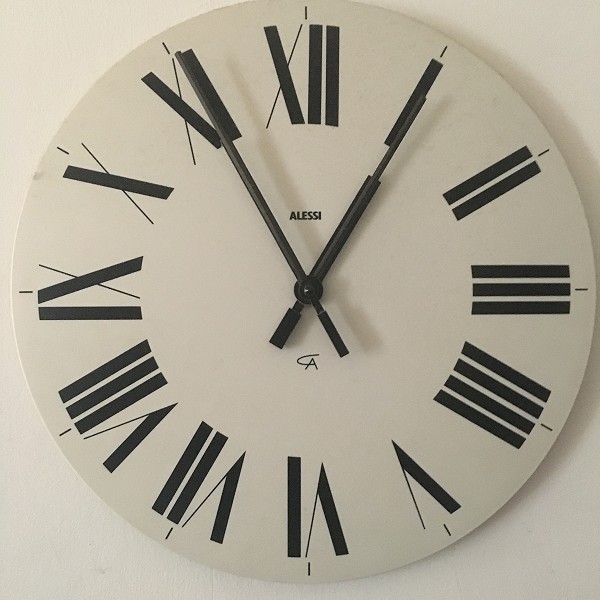
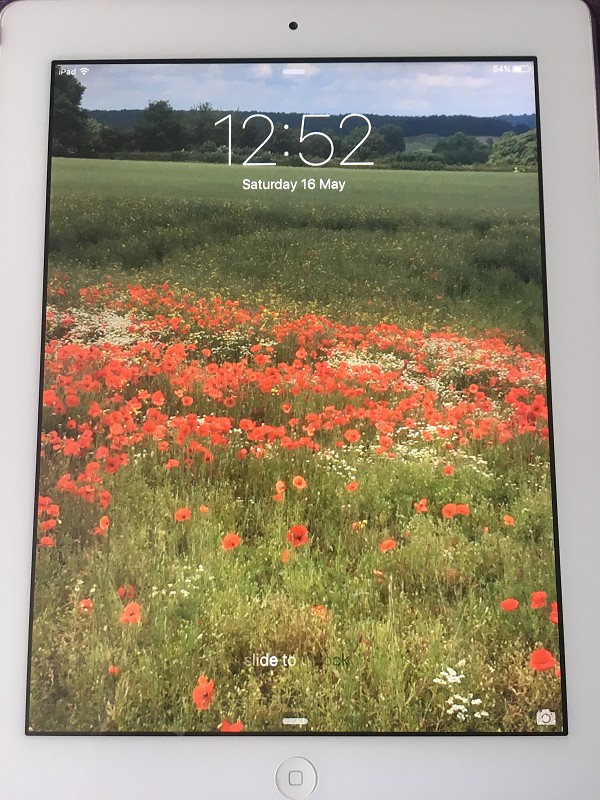
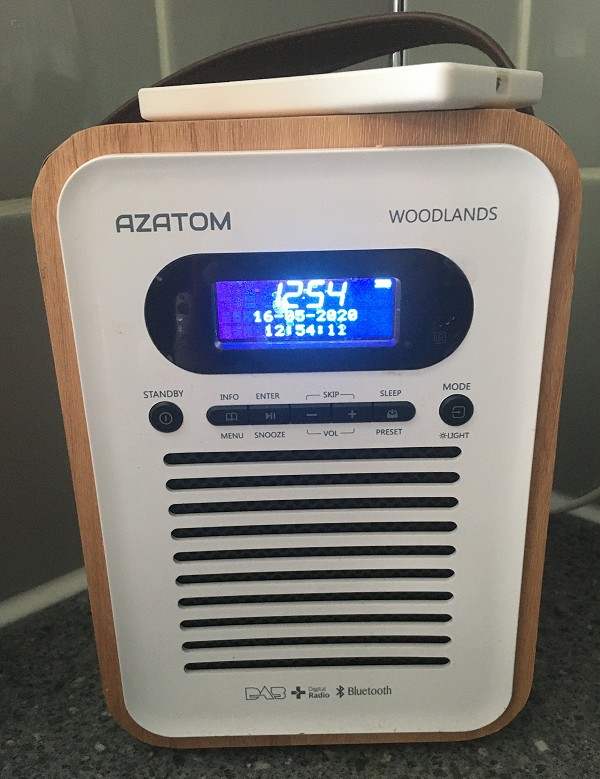

- Go on a clock hunt in your house. How many clocks and watches can you find? Are they easy or tricky to read? Which is your favourite?
Here's a lovely time song from kidstv123:
- Can you think about all the important times in your house? Ask an adult to help you take some photos. Can you put them in order from the first thing you do in the morning to the last thing you do at night? Now you have your own visual timetable just like we do in school! Put it up somewhere everyone can see it. Check in every so often to see what is finished and what comes next.
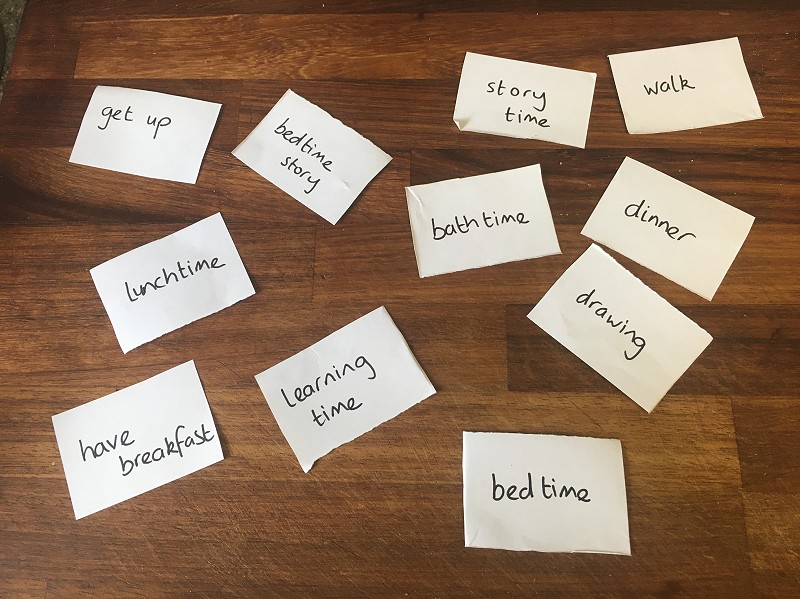
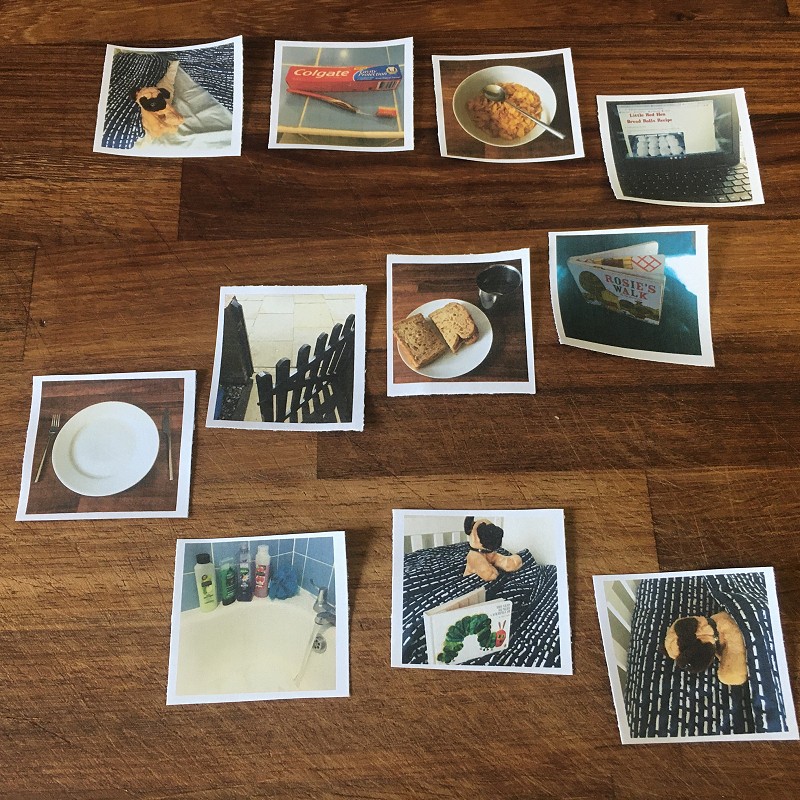
Phonics for Reception
Use your sounds to help you write some of these words:
- seed
- tiny
- bee
- bud
- root
- fly
- land
- flower
- little
- yellow
- grow
- wind
Parent/carers: don't worry if your child uses their sounds and some of the words aren't spelt correctly. This is absolutely ok: they may write 'f-l-igh' for fly or 't-igh-n-ee' for tiny for example. And it's ok for them to write f-ow-er for flower because it's tricky to hear the 'f' and the 'l' in flower (they're called adjacent consonants and we didn't learn about them in class yet). Give lots of praise if your child has a go and tries their best because that's how we learn.
Now can you use some of these words to write about what you can see happening in the dandelion life cycle?
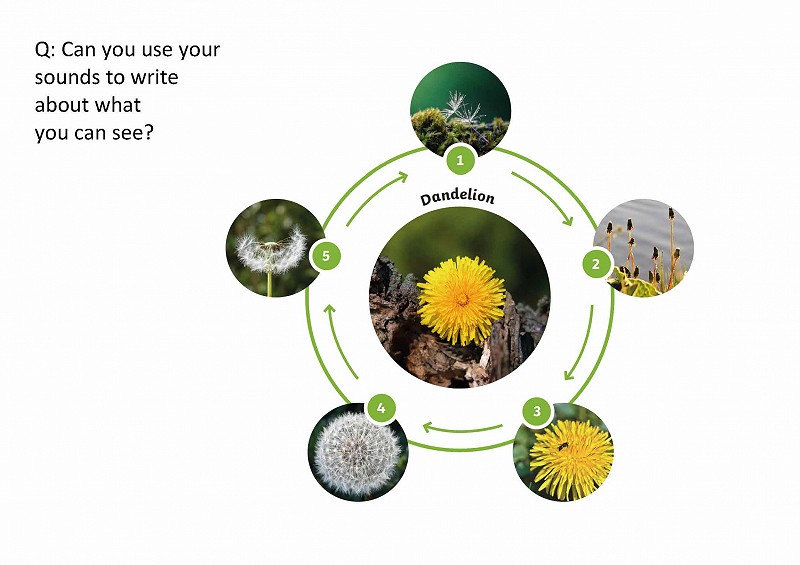
Bean Update
Tuesday 19th of May. Giselle's bean plant is continuing to grow and Mrs Moran has re-potted it (given it a new home) as the roots were sticking out of the bottom of the pot so it couldn't get the nutrients (this means the food) it needs from the soil and was all squished (a bit like you when you need new shoes!) It's 53cm tall and has two huge bean pods and three tiny ones. The bean plant is now living outside all the time because the weather is warm and has its own terracotta (clay) pot to keep it safe. Mrs Moran's garden has quite a few snails though so she's going to be keeping an eye out to make sure none of them come up for a sneaky nibble!
How are your bean plants doing? Send us a photo to: info@scsj.rbkc.sch.uk
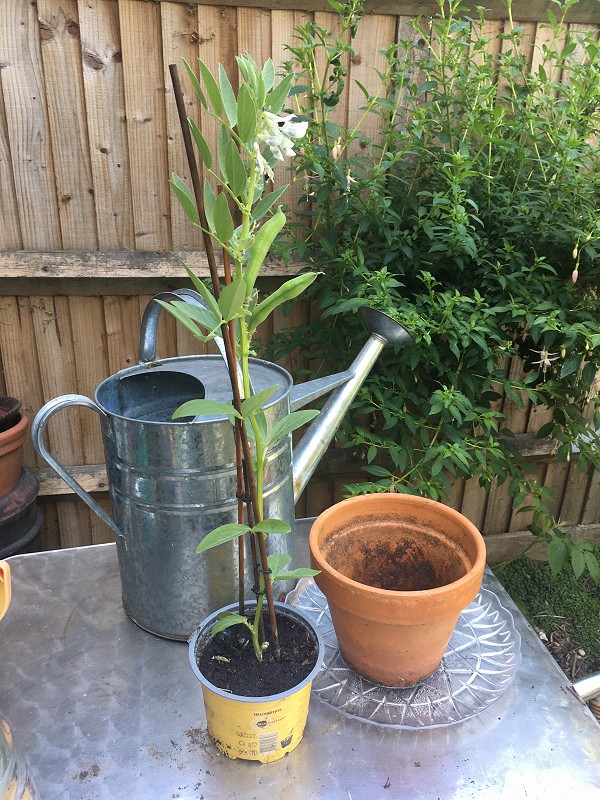
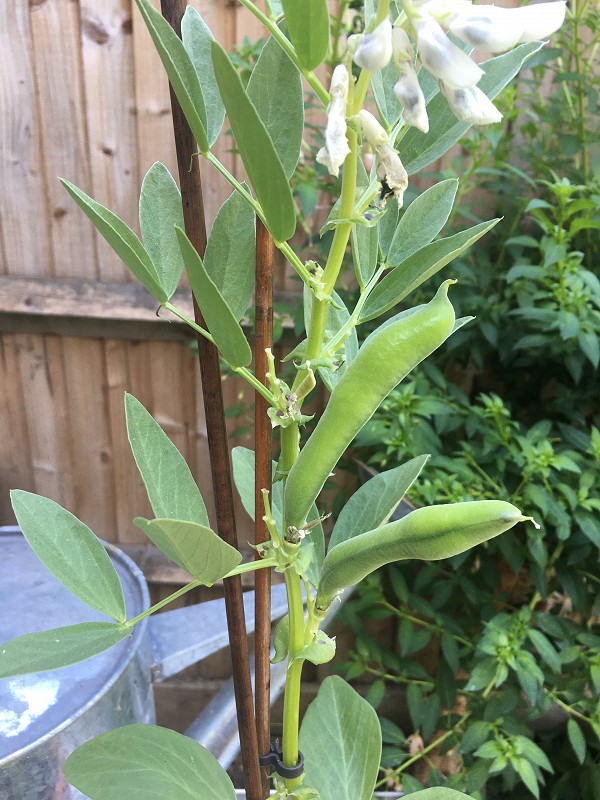
Oh no! After a night outside something has eaten the three tiny bean pods! What should Mrs Moran do? Email us with your ideas at info@scsj.rbkc.sch.uk
Week Commencing 11th May 2020
This Week's News
A new Art Is Where The Home Is activity pack has come out. Click on the link below to download it. We particularly love the den building activity. Have fun creating and then share it with us by sending a photo to: info@scsj.rbkc.sch.uk

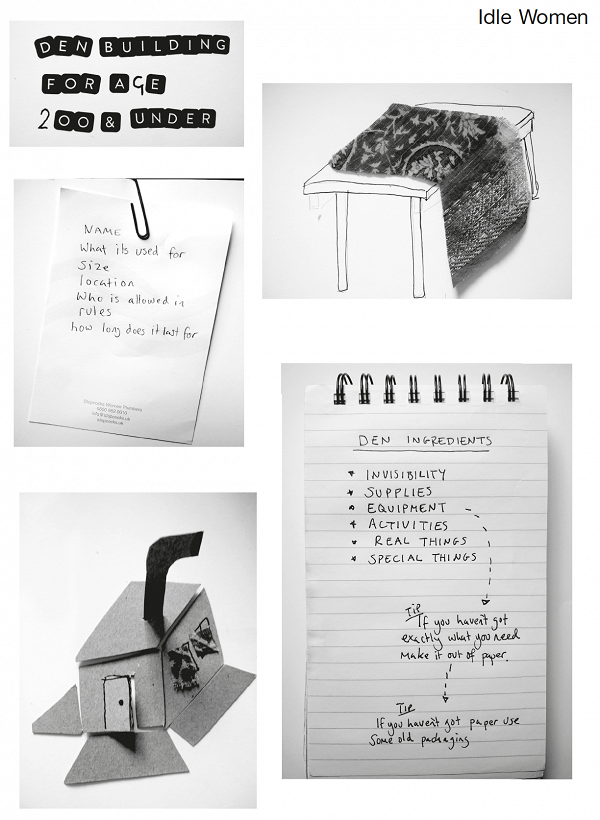
Olivia has been keeping a lockdown journal and wanted to share it with us. Great job Olivia, mummy, Aunty Priscilla and Grandma. Keep us up-to-date with how your plants grow!
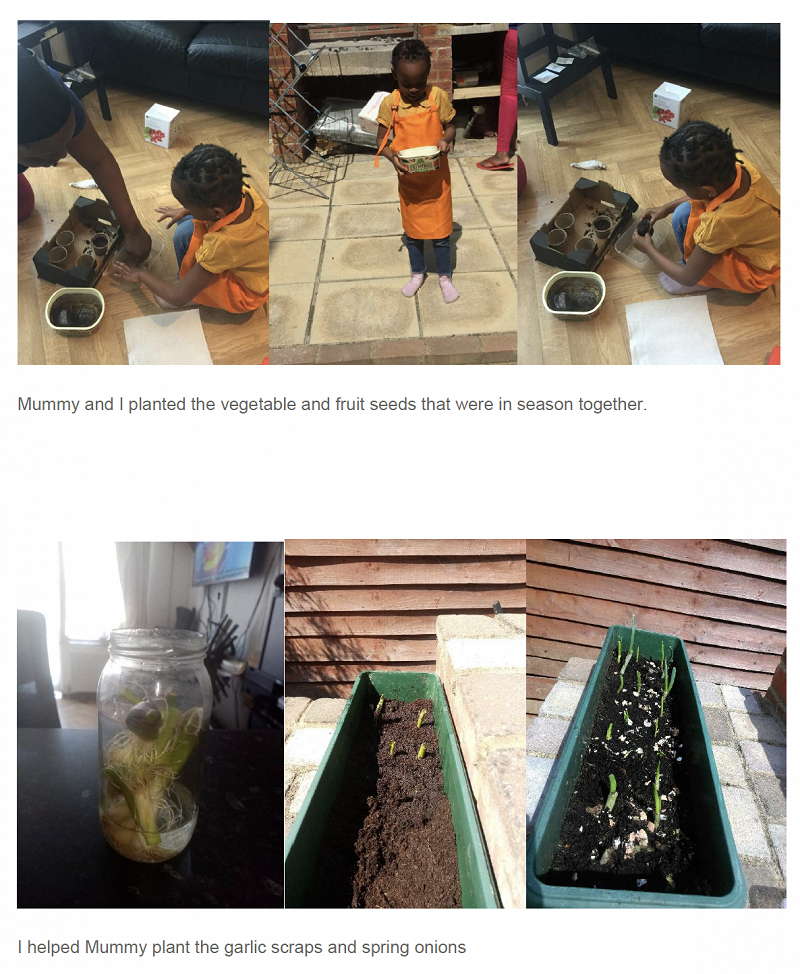
Congratulations to Franz and family who have welcomed a new baby sister for Franz. Her name is Wendy and Franz looks like a very proud big brother.
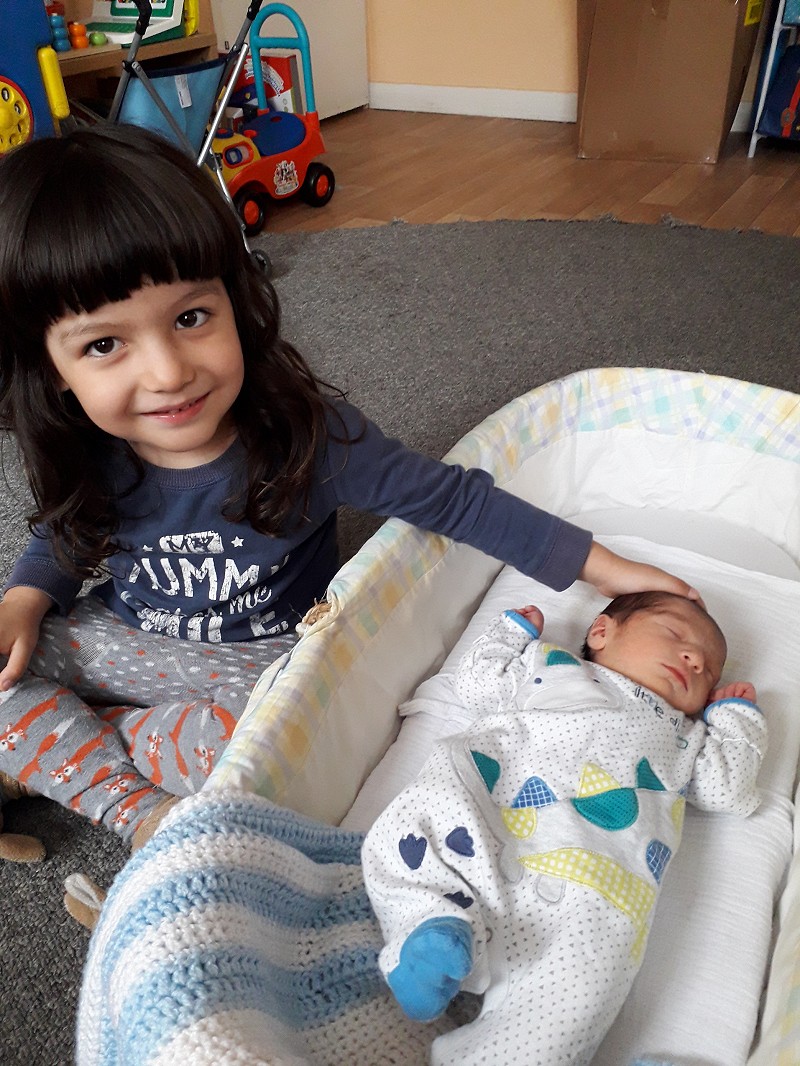
Rocco has been making cookies. That looks like lots of fun Rocco, bet they were delicious!
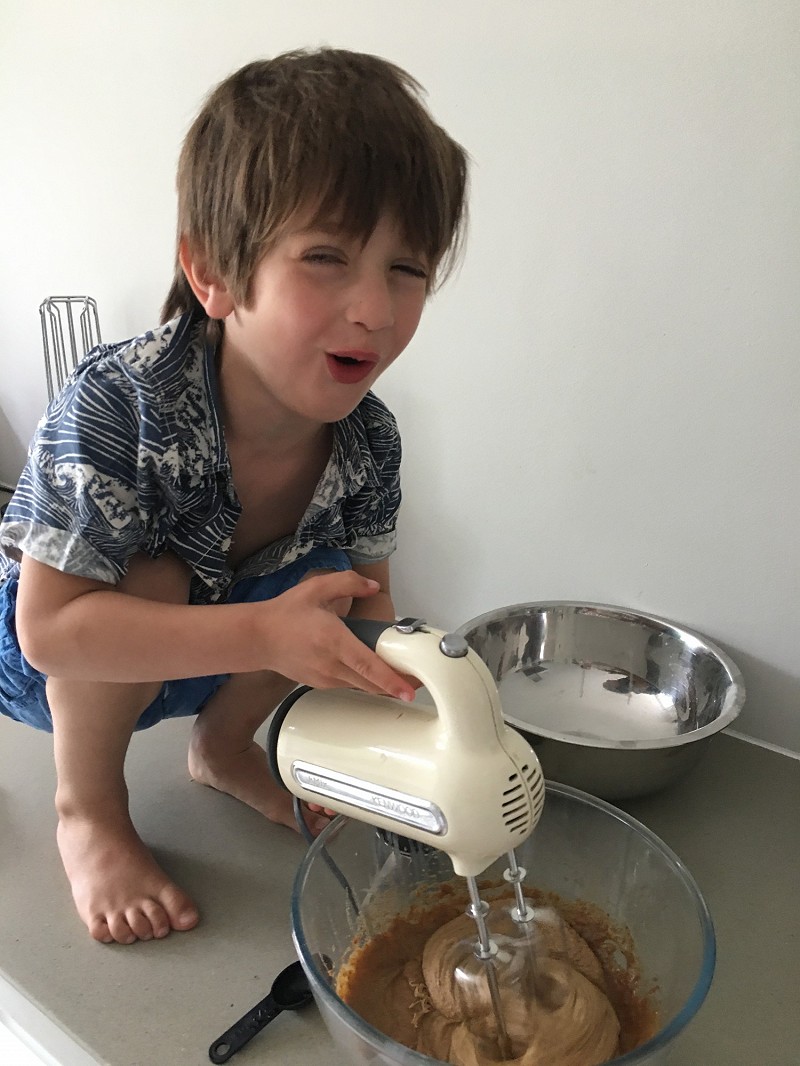
Oskar really enjoyed his VE Day flapjacks. He got VERY sticky mixing up the sugar and butter mixture with the oats though so had to have a bath before he could eat them! Oskar has been missing you all very much but behaving himself at Mrs Moran's house. He has been remembering to brush his teeth and luckily hasn't eaten everything in the fridge - but he HAS been jumping on the bed. Luckily for Oskar, he didn't bump his head (yet!) but Mrs Moran has reminded him what happened to those monkeys and said she really doesn't want to have to call the doctor! We hope you haven't been jumping on the bed either!
Do you have any questions you'd like to ask Oskar? Remember a question could start with: Who? What? Where? When? How? or Why?
You can email him at: info@scsj.rbkc.sch.uk
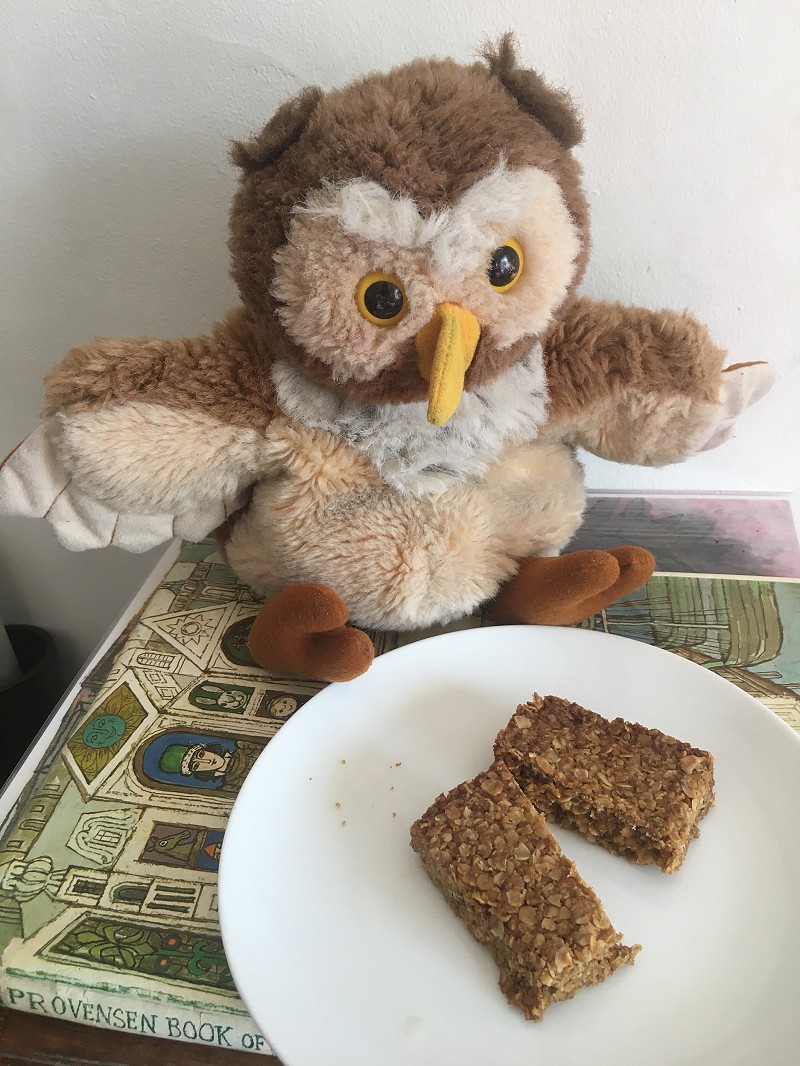
Lovely Learning
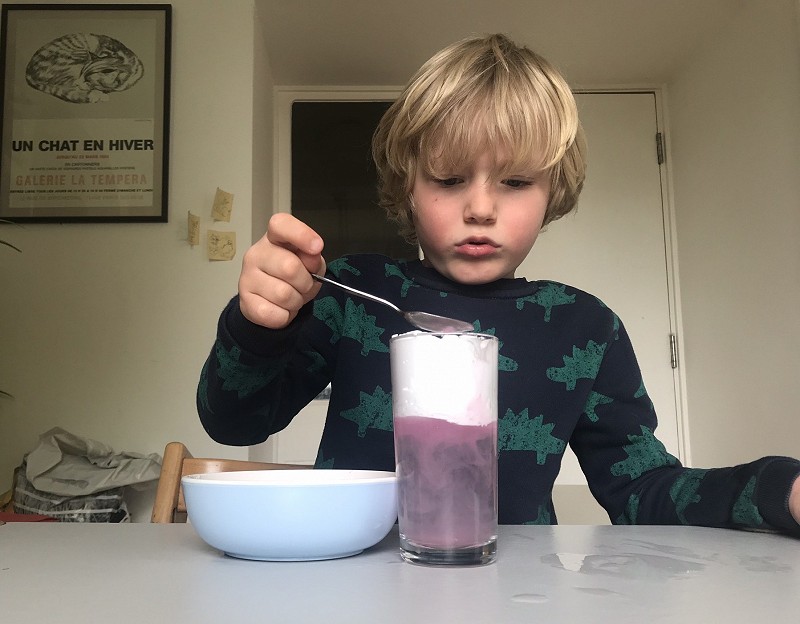
Since making our Balloon Turnip Bertie has been inspired to do lots more science. He has had a go at making a Storm in a Glass with Dale using shaving cream as the cloud, and coloured water as the rain. Wow! This looks like lots of fun Bertie. Keep experimenting!
You can try this and other experiments yourself by following this link:
Wilf and his mummy have been sharing photos and talking about people in their family who helped others during the war. Below are photos of Wilf's great nanas who were both in the Land Army. It was a really important job because 'Land Girls' helped to look after and grow crops to keep the whole country fed during wartime. That must be where Wilf gets his green fingers from (his mummy tells me his bean plant now has pods). You must be very proud of your amazing family Wilf!
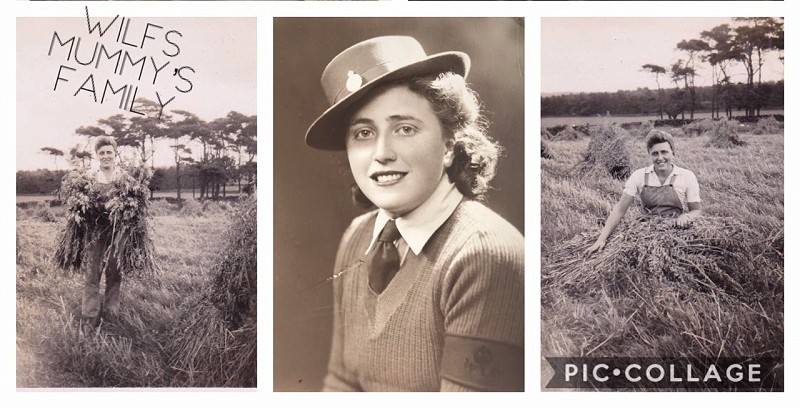
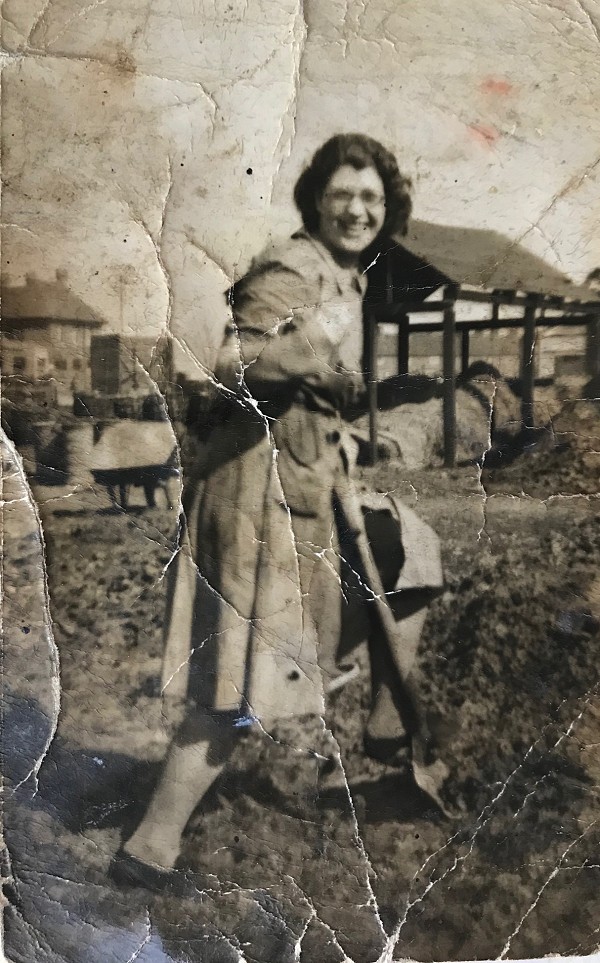
Ardit has made a concertina (this means folding) book all about flowers. He has labelled all of his pictures. Well done for showing us what you know Ardit!
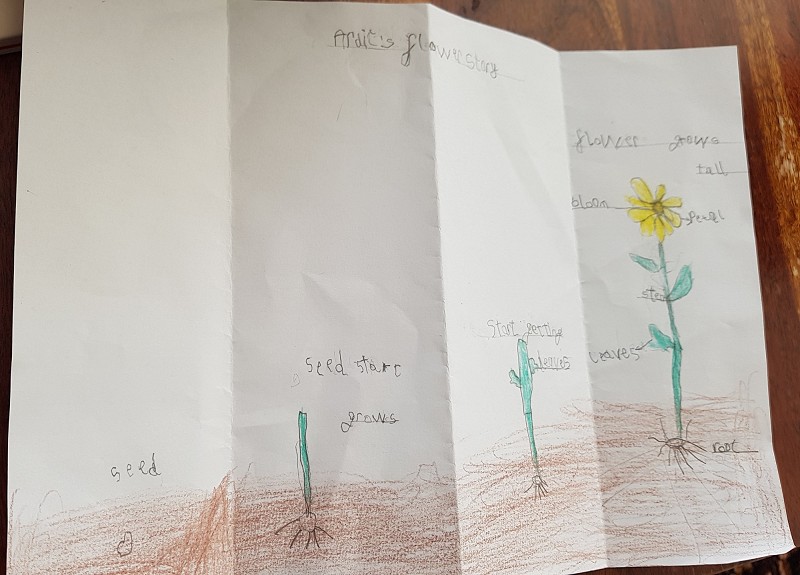
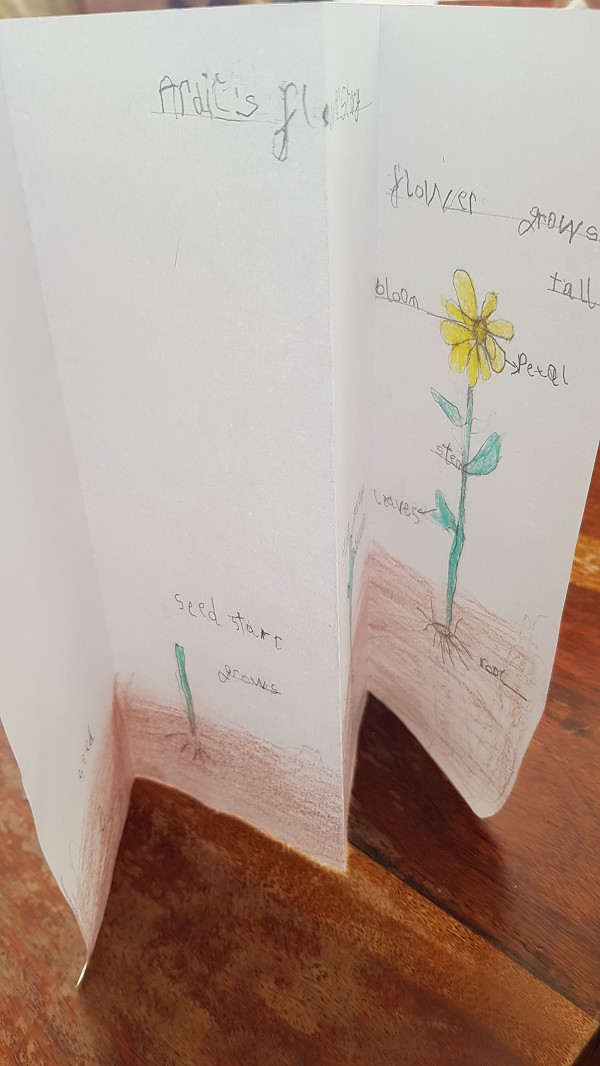
Ramadan
We are now half way through Ramadan. Ramadan is an important spiritual time for Muslims where families pray together and think about and help those less fortunate than themselves. Ramadan lasts for around 30 days and finishes with Eid, which is a special celebration. This year is a very different one for our Muslim families as they are not able to visit family or friends and must pray at home instead of at their Mosque (a very special place like our school church - St Clements).
Helping and thinking about others is an important part of Ramadan. Here are some things you can do to help others:
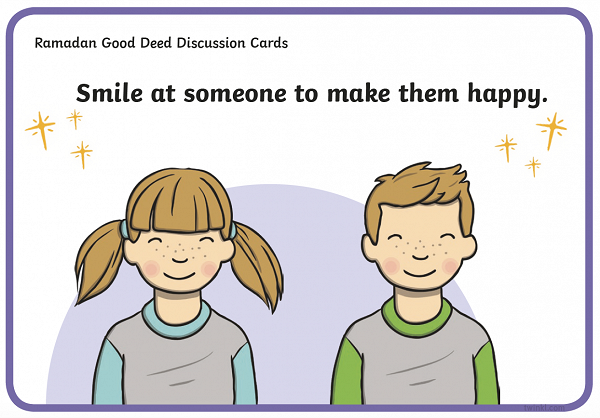
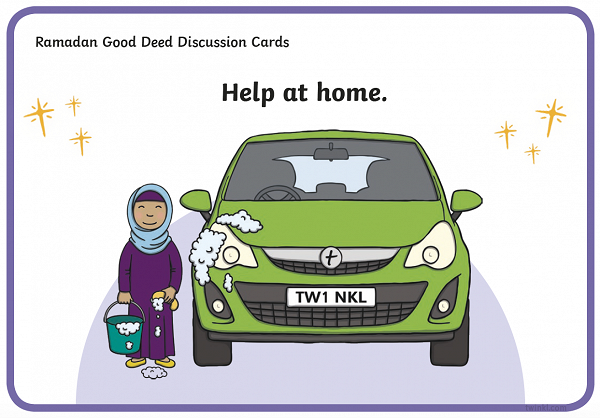
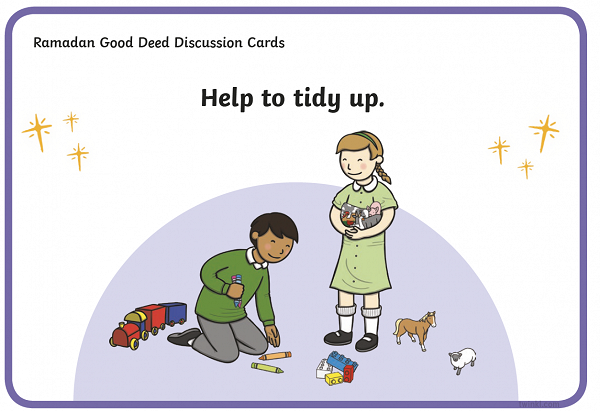
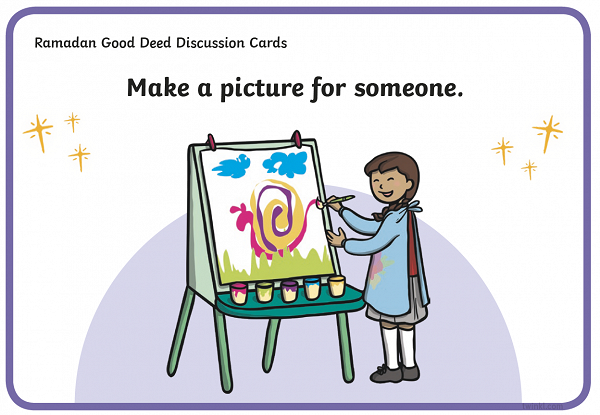
To find out more about Ramadan and Eid, click on the link below to visit the Newsround site and look at the Powerpoint document.
We would like to say, 'Ramadan Mubarak' (Blessed or Happy Ramadan) to all our Muslim families.

Christian Aid Week
This week is also Christian Aid Week - where Christians are asked to donate (give money) to help others. The message of this week is all about love and supporting those around the world who need our help to stay clean and healthy.
If you would like to find out more please visit this website:
Core Text: The Little Red Hen
Our story this week, The Little Red Hen, is all about how important it is to help each other. Just like The Enormous Turnip, this is another Russian folk (or traditional) tale. Watch the story:
then think about, try or watch some of the following:
- How is this story like The Enormous Turnip? How is it different?
- Draw the different characters from the story. Reception - can you label your drawing to name your characters? Use your sounds to help you.
Here is Wilf's picture.
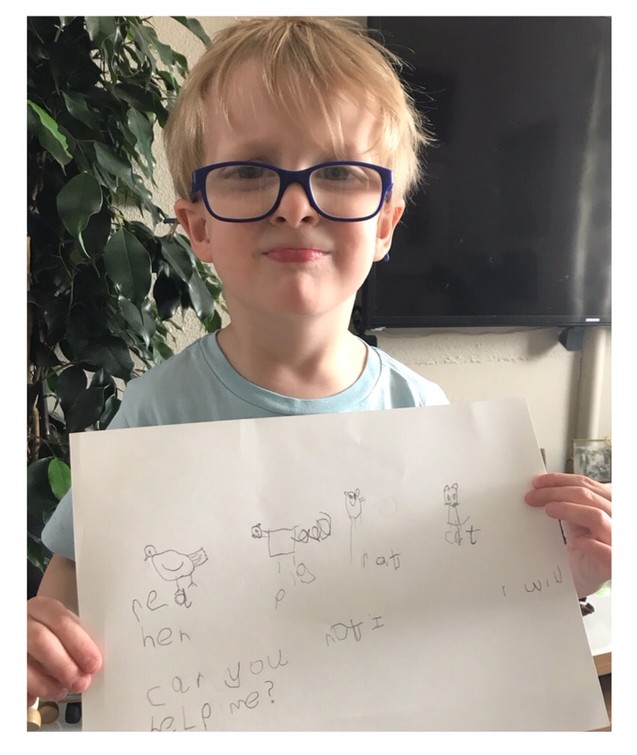
and here is Anass' learning. Well done for using your sounds to name the animals Anass!
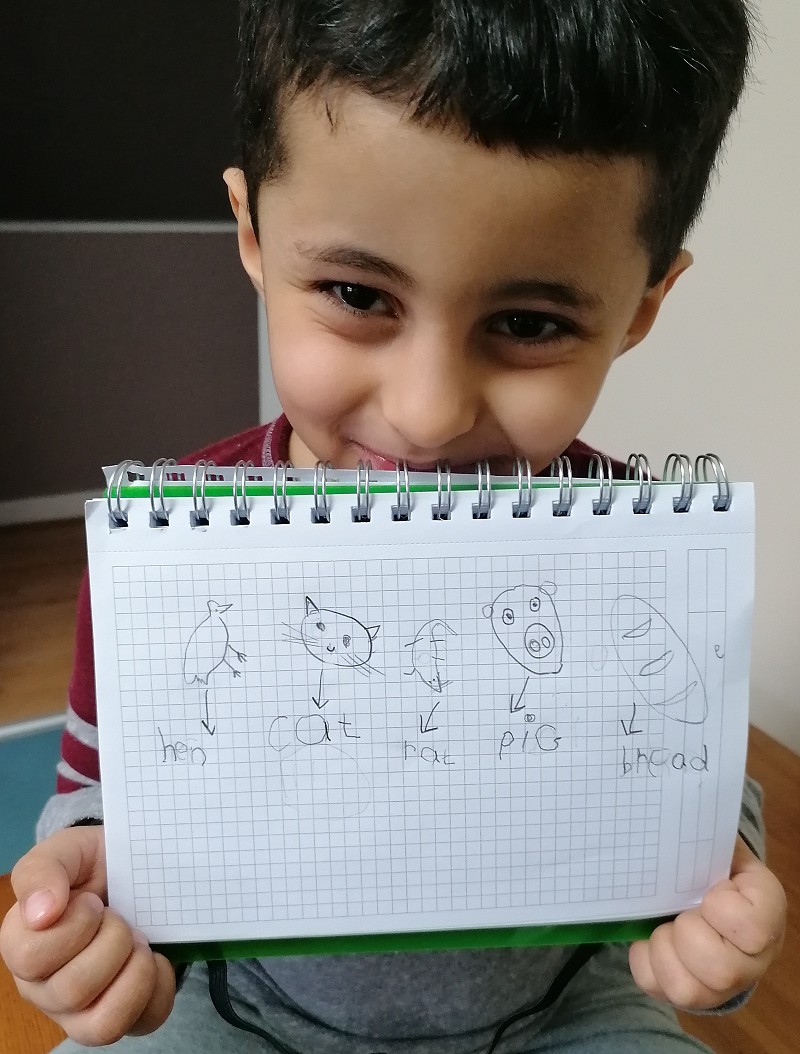
- Think about how the Little Red Hen felt when her friends would not help her. Do you think it's ok for her not to share her bread with them? What would you have done? What do your think her friends should have done instead? How can they make it better?
Wilf thinks the Little Red Hen would feel sad and cross. It's ok for her not to share because they were being lazy. He would not share the bread because they were lazy and did not help. They should have helped. They could make it better by helping next time and they have to say sorry. What do you think?
- Retell the story using this story map.
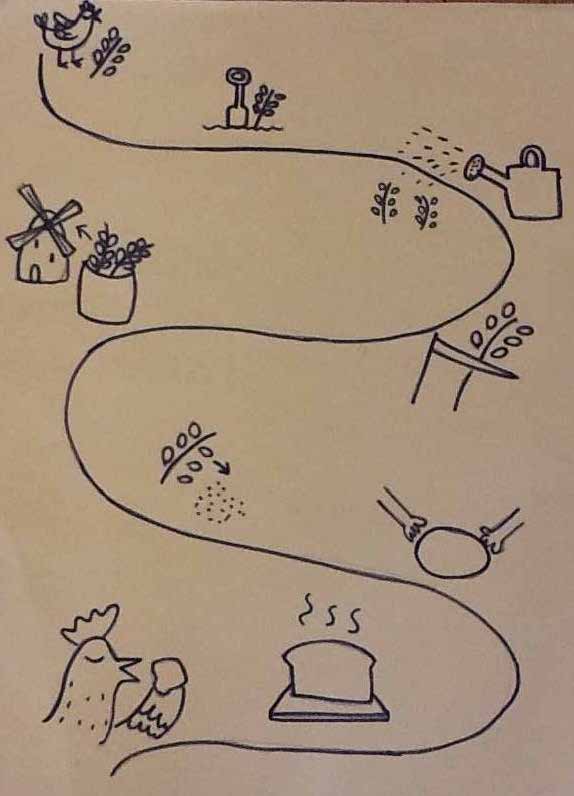
Ardit told his version of the story to his sister Anisa who has written it down. Great job Ardit, and thank you for helping Anisa!
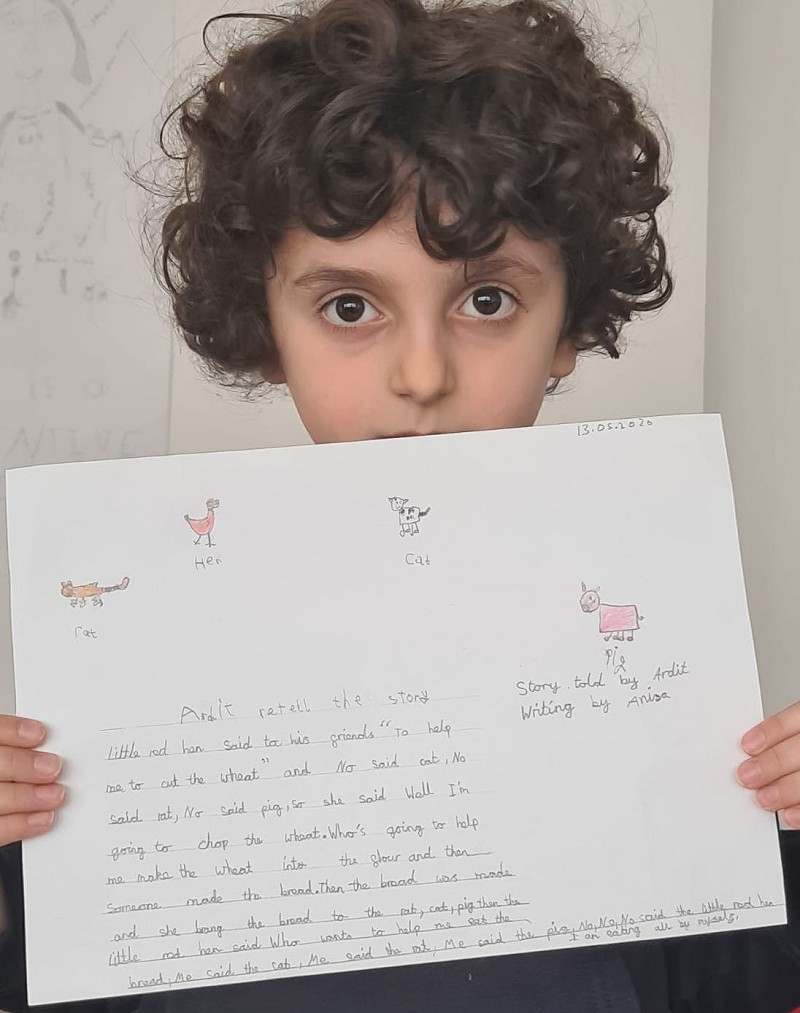
- Do you know how the bread we buy from the supermarket is made? Auntie Mabel and Pippin would like to show you:
- There are lots of different versions of The Little Red Hen, and they often have different animals in them. Choose your own animals (they can be as crazy as you like!) and then tell your mummy, daddy or whoever looks after you your own version of the story. You could also draw your animals with the little red hen. Ask your mummy or daddy or whoever looks after you to write down exactly what you say then send it in to info@scsj.rbkc.sch.uk
- In the story, the little red hen takes her wheat to the miller at his windmill so he can grind the wheat into flour. Do you know what a windmill is? Have a look:
- We know it's a bit tricky to get hold of bread flour at the moment, but if you are able to find some here is a very easy Little Red Hen bread rolls recipe. When the rolls are cooked and cooled can you see if you can share them fairly (so everyone in your family has the same amount)? What can you do if you have some left over? Remember, if you all help then you can all share!

The Little Red Hen has been baking with Oskar. Can you count how many rolls they have made?
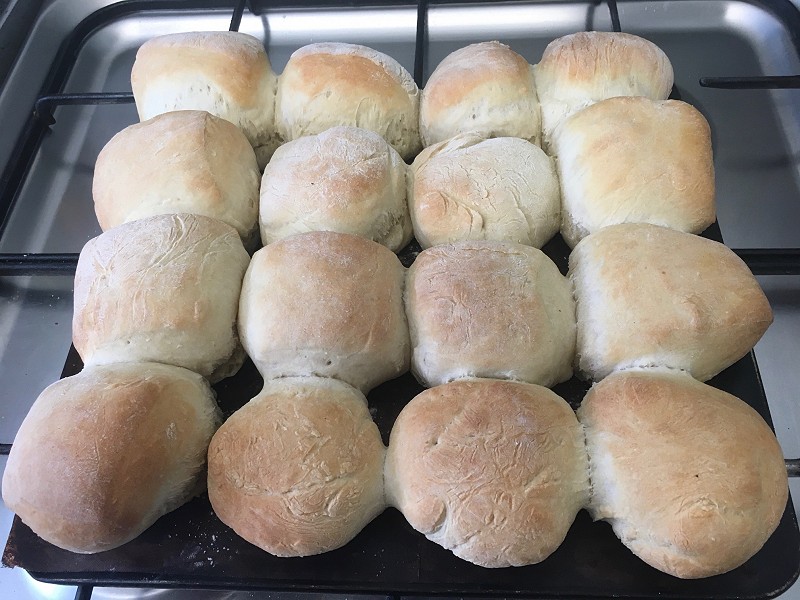
Little Red Hen and Oskar want to share their rolls fairly so they are going to do 'one for me and one for you'.
- Can you find the same number of objects as the rolls and then share them fairly between two plates.
- How many rolls will they have each?
- Are there any rolls left over?
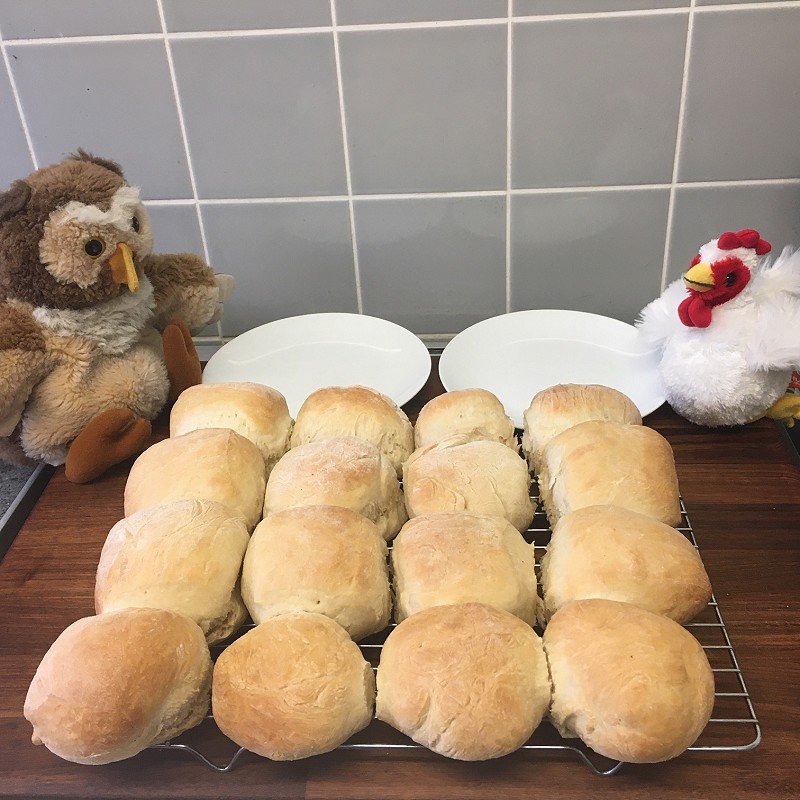
Their friend Fanty has come to see what they've been up to. Little Red Hen wants to share the rolls fairly with her so she has given her a plate.
- Can you work out how many rolls they will have each?
- Are there any rolls left over?
- What can they do to make sure everyone has the same amount?
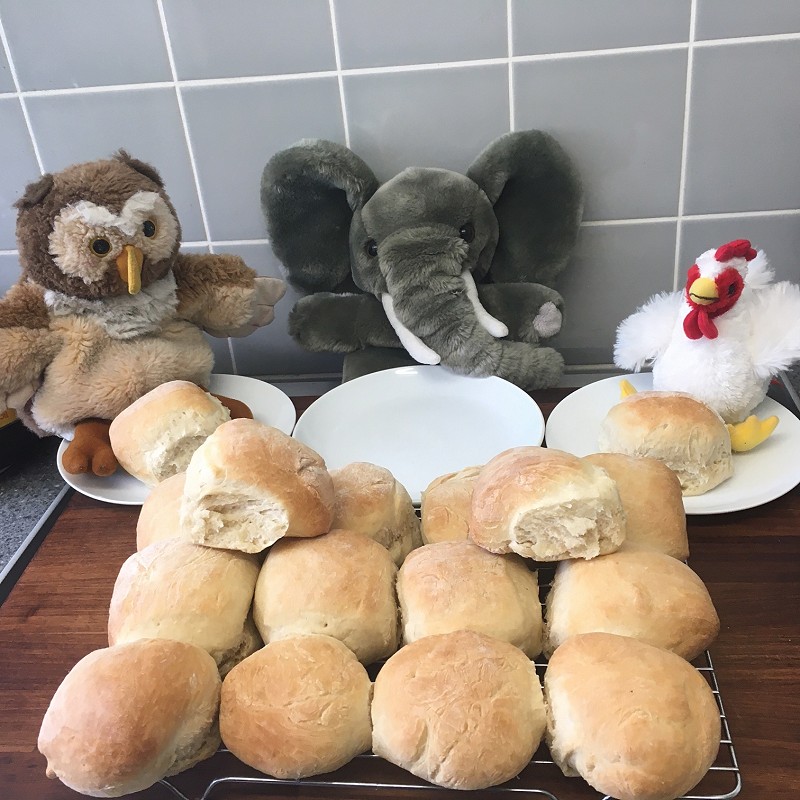
Phonics for Reception
Practise using your sounds to write the following words from the story:
- red
- hen
- cat
- rat
- pig
- farm
- help
- not
- cut
- will
- mill
- did
And then try to write these tricky words from the story:
- grow
- miller
- baker
- eat
Can you write what the little red hen says to the animals, "Can you help me...?" and what the animals say to the little red hen: "Not I!" and "I will!"
Then have a go at writing an apology (saying sorry) letter from one of the other animals to the Little Red Hen. Use some of the words you have been practising, your sound mats to help you write new words and high frequency word mat for words you just know. There is a template below to help you.
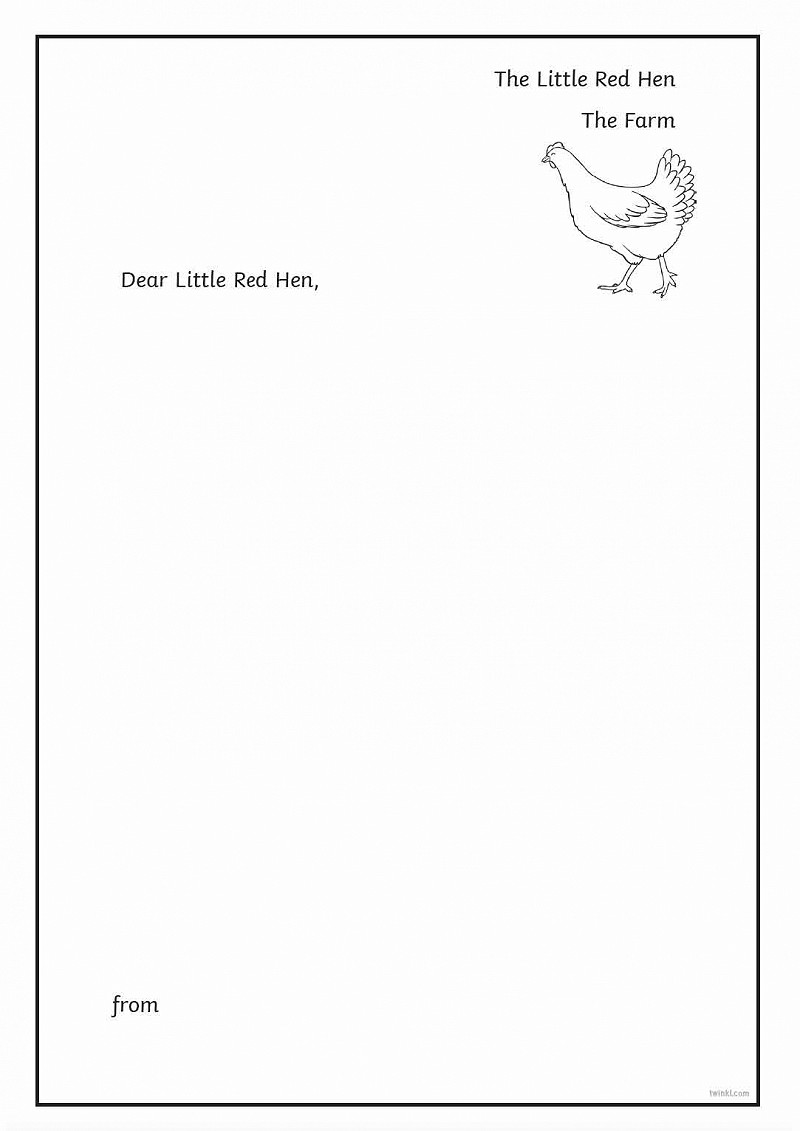
Here is Wilf's letter from the cat, rat and pig. It says, 'I am sorry Little Red Hen. We should have helped.'
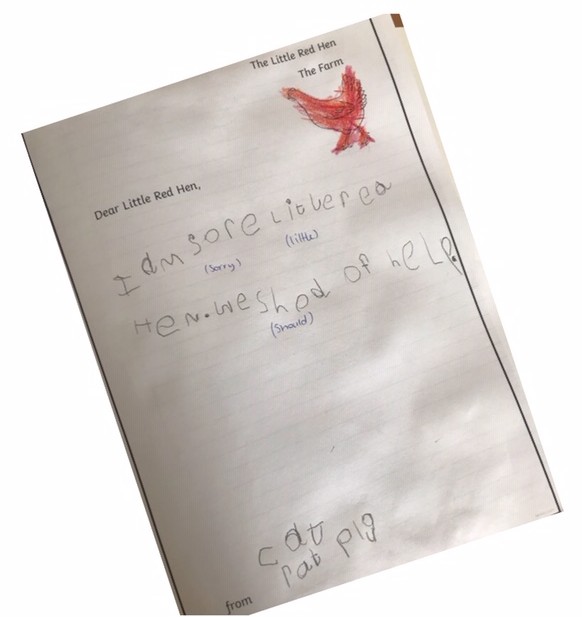
Maths for Reception
This week we are thinking about weight. This means how heavy or how light something is. You can test this by holding a different object in each of your hands and working out if it feels like one is pushing your hand down more (it's more difficult to hold it). This means that one is more heavy.
You can make your own balance scale with a coat-hanger, string and plastic or paper cups. If you put different objects on each side, one side will go down. This means the object in that cup is heavier and the other object is lighter. Have fun experimenting!
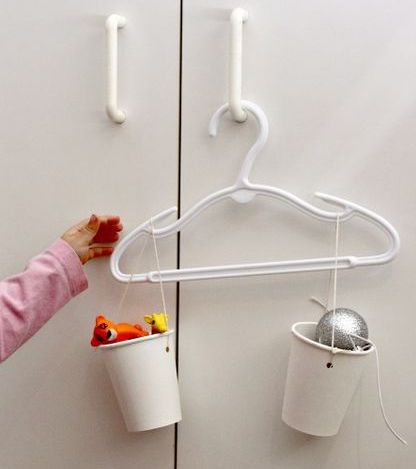
Nrich has a brilliant spring scale activity so you can explore how heavy different items are by making your own spring scale. The pdf is below and photos of Mrs Moran's spring scale. She used an elastic band, small cardboard box, paperclip, string and a hole punch and recorded by putting an arrow for where the box dropped to for each object.
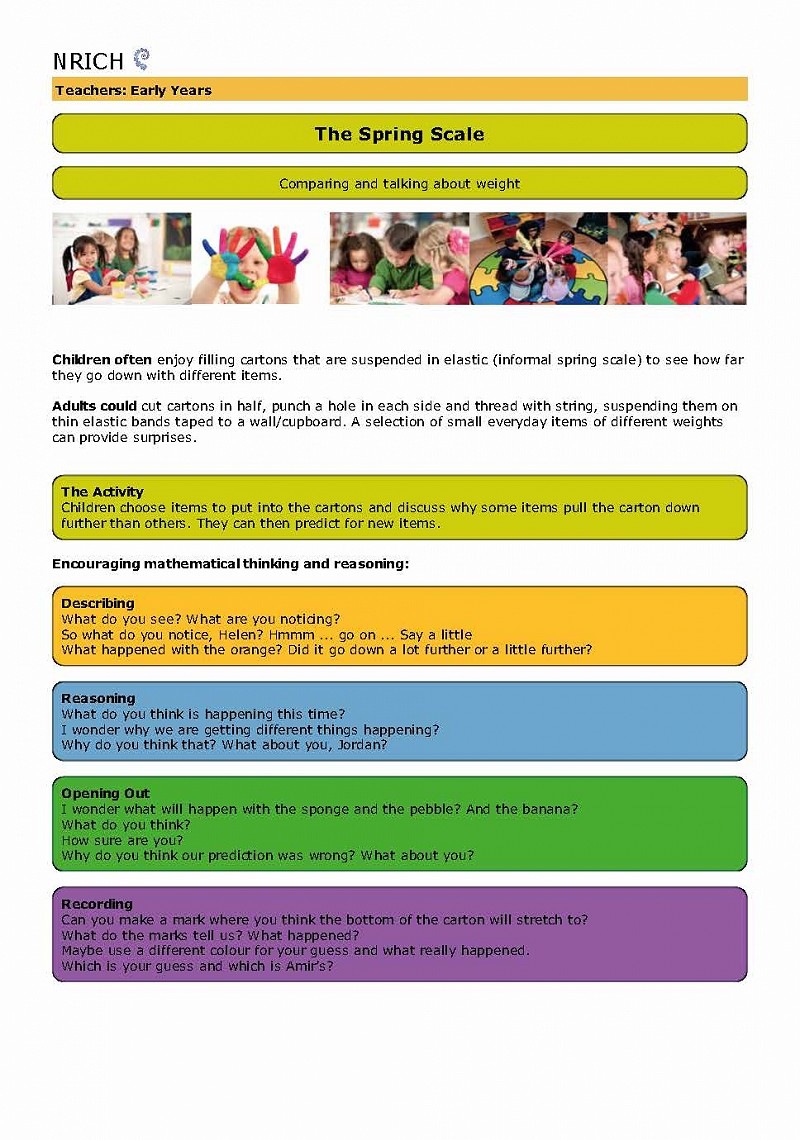
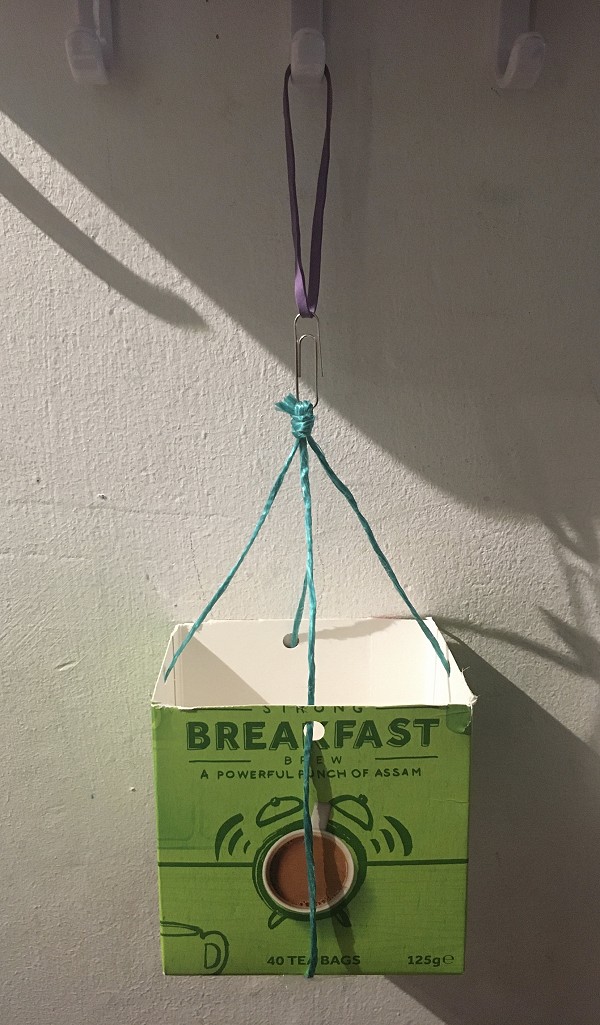
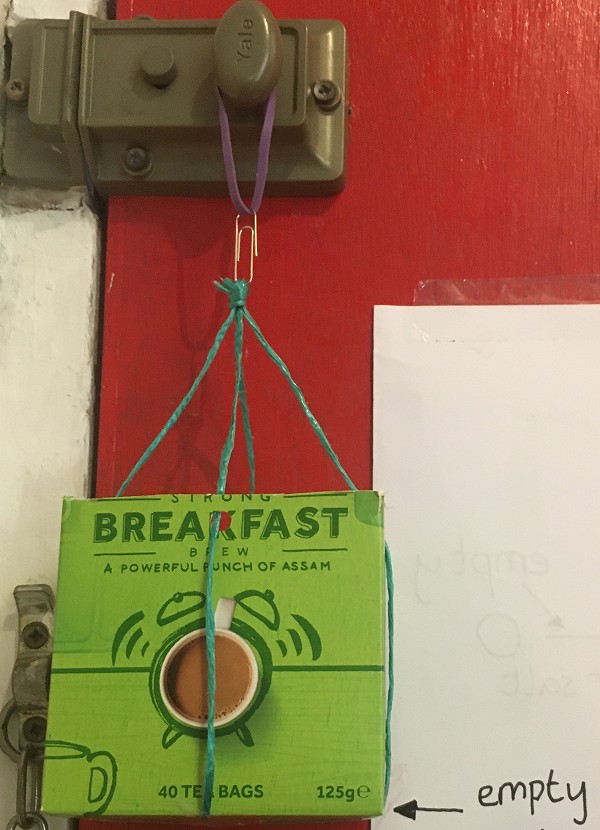
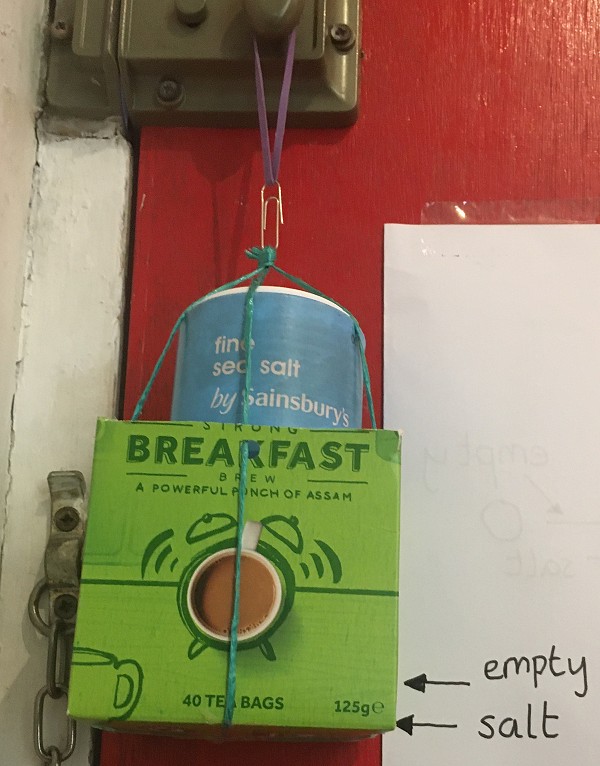
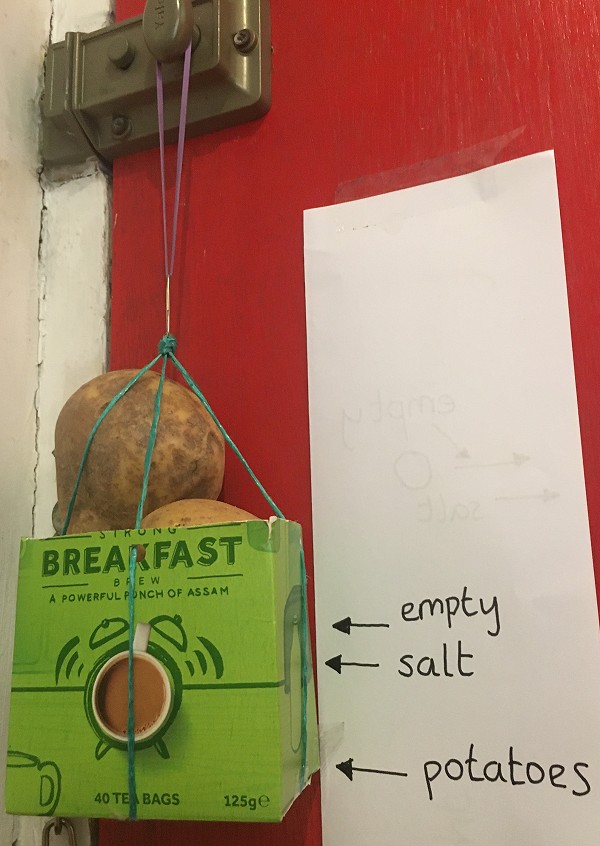
Do you have kitchen scales at home? If you do, we would like you to try weighing different items to see how heavy or light they are.
Can you record by writing down the name of the item and the numbers you can see on the scales? Do you know what the numbers say? Ask an adult to help you to read them. The bigger the number the heavier the object.
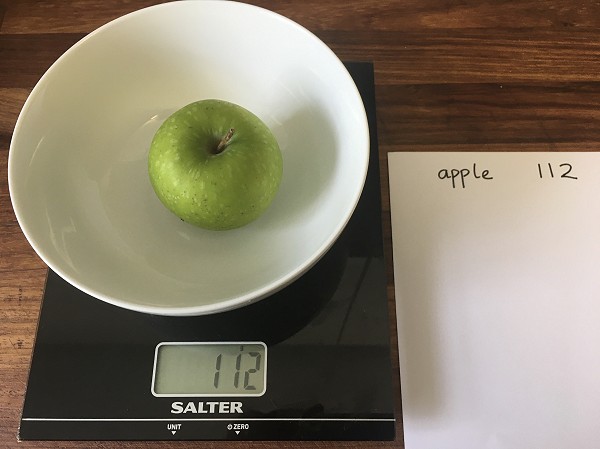
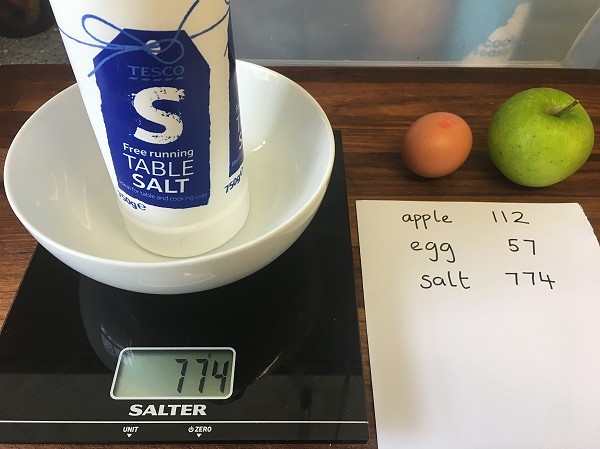
Once you know how much each one weighs, find out which is the heaviest and which is the lightest. Can you have a go at ordering your items from lightest to heaviest?
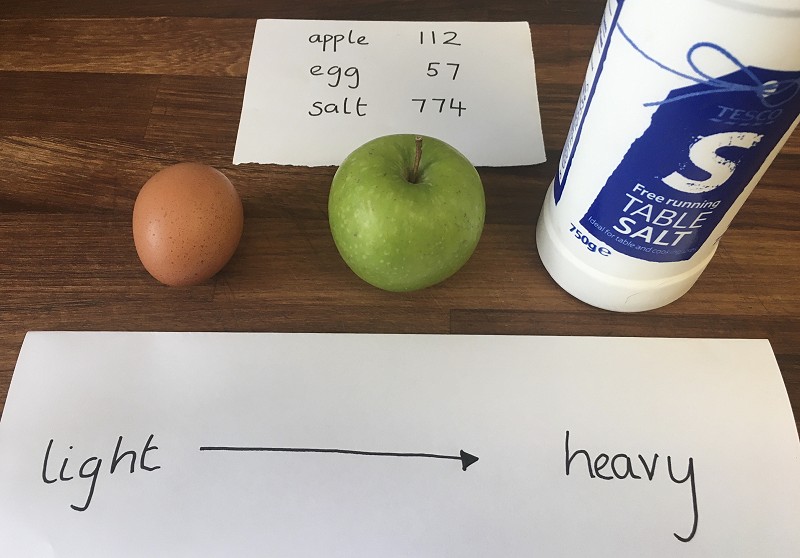
Little Red Hen Song
Watch and then sing along with the Campfire Crew's Little Red Hen Song. It's a bit different but has the same message. Always remember - a friend in need is a friend indeed!
Little Red Hen Cartoon
A long time ago, even before the Second World War, animators (people who make drawn pictures move) made this lovely story of The Little Red Hen. It's a bit blurry but we think you'll enjoy it!
Rosie the Hen
Here's another hen related story for you. Hope you like it! Oh no! Another pesky fox!
Bean Update
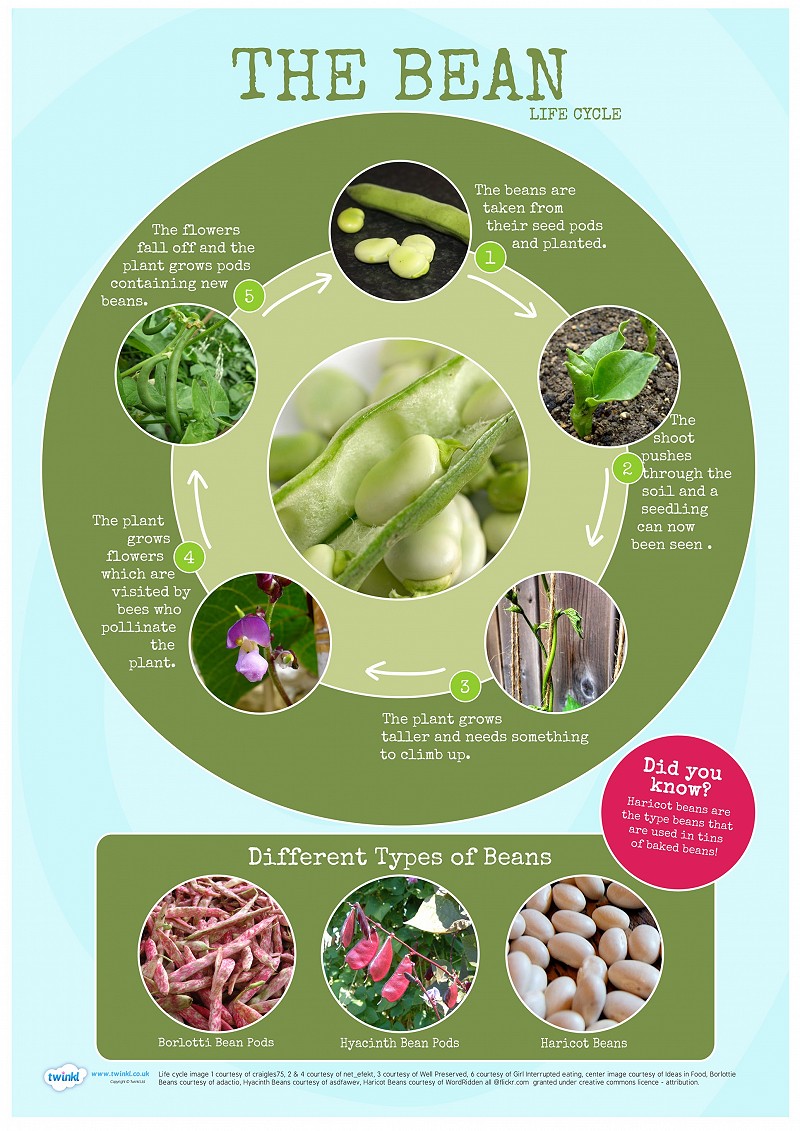
Monday 11th May: Giselle's bean plant is losing flowers but that's ok because it's part of the bean's life cycle (this means it happens again and again and again). Where the flowers have been pollinated (visited by bees and other insects) the flowers have changed to become pods which are now starting to get quite strong.
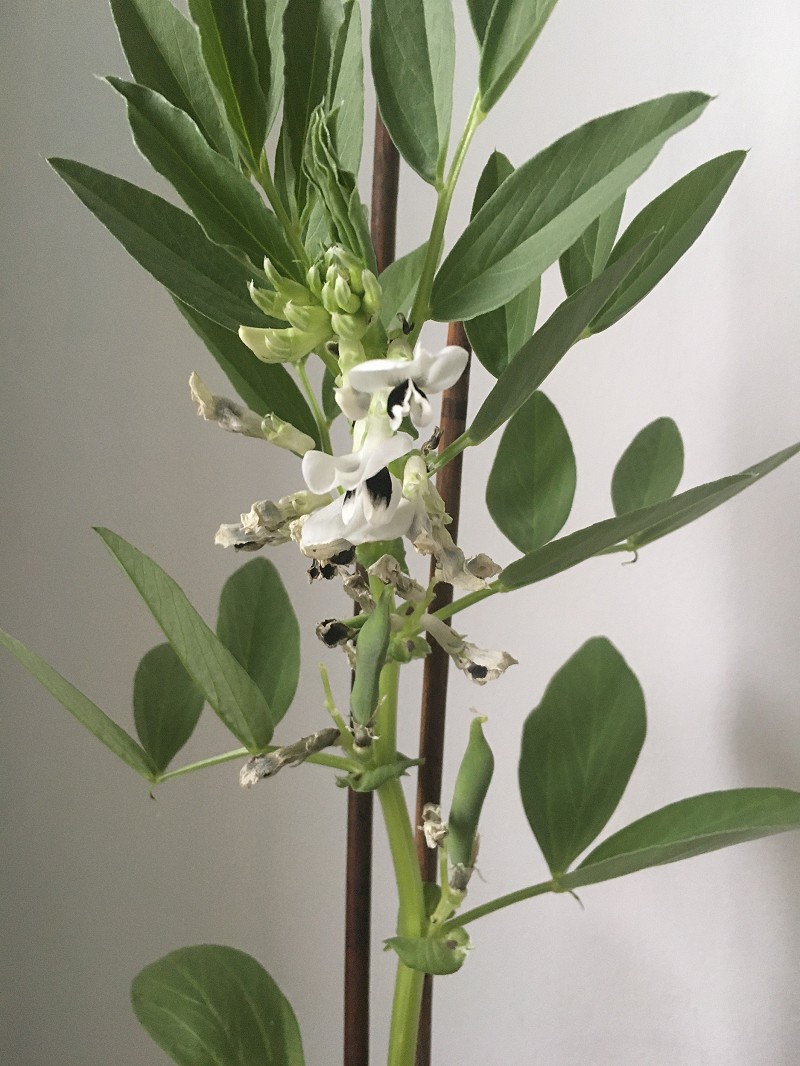
Look at Franz's beanstalk. It looks like it's growing up to the ceiling. Does it have any flowers yet Franz?
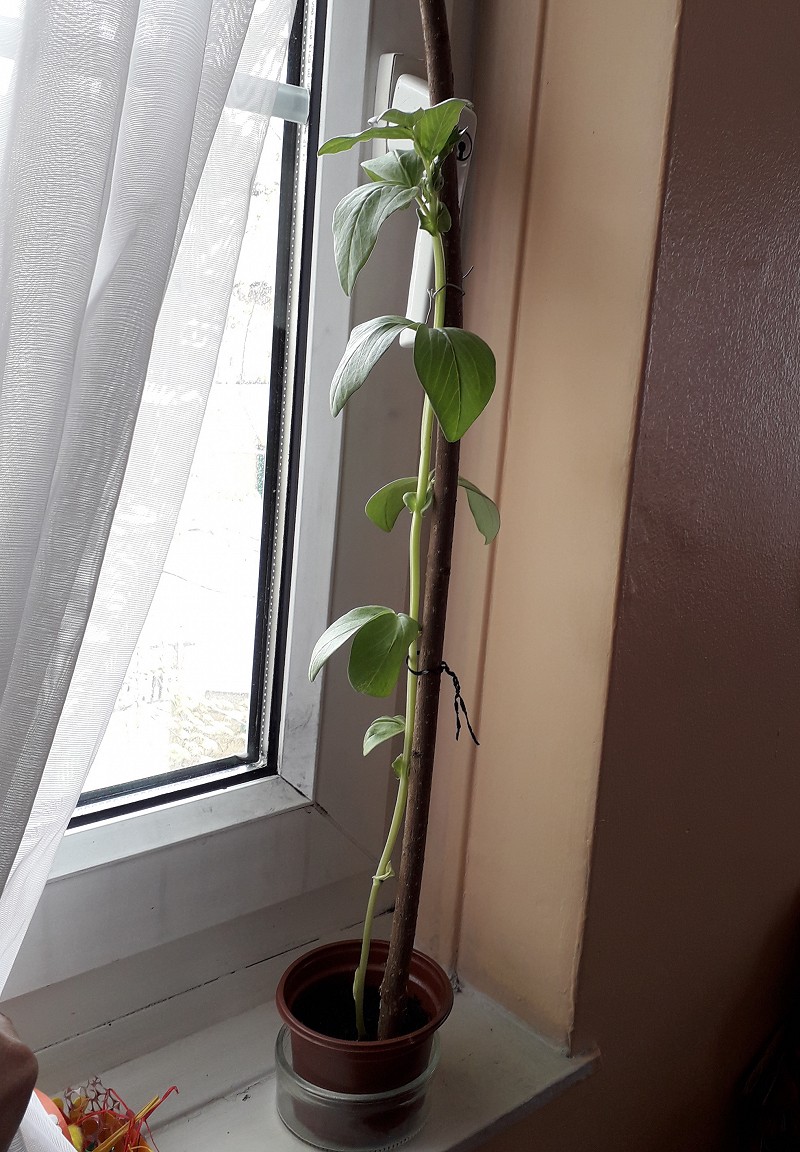
Tuesday 12th May: Wilf's bean plant now has three pods!
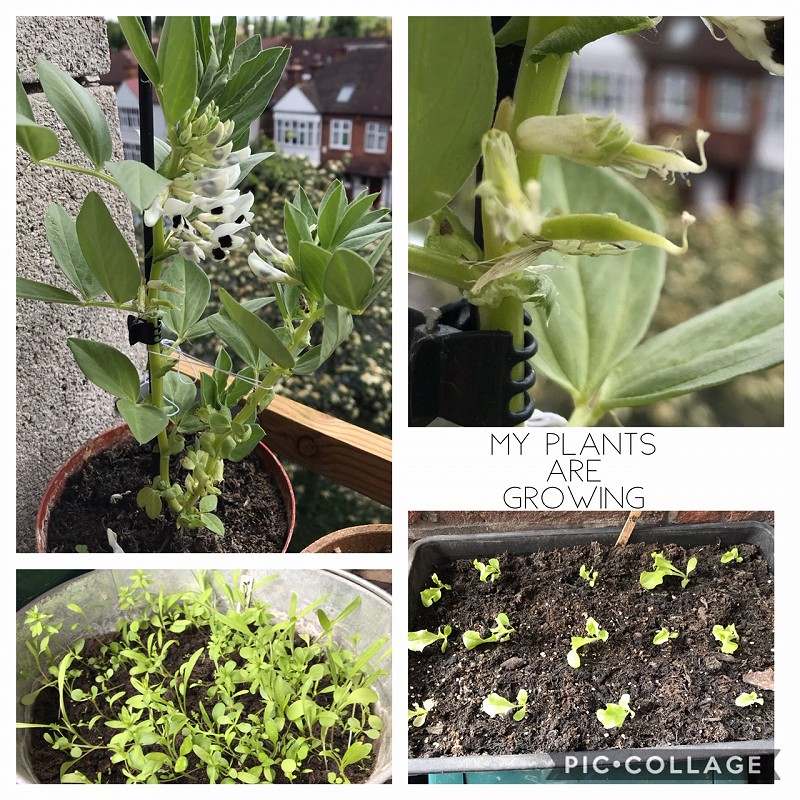
Week Commencing 4th May 2020
This Week's News
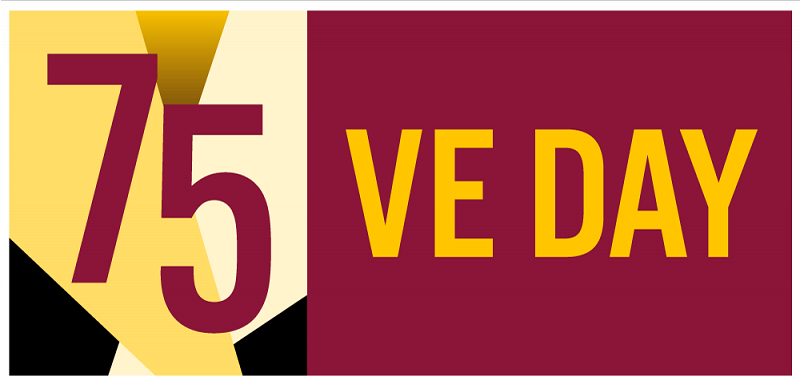
Tomorrow (Friday 8th of May) is a bank holiday because it is VE Day (VE means Victory in Europe). 75 years ago (even longer than Mrs Moran has been alive!) the Second World War (sometimes called WW2) finished in Europe. Families in this country celebrated by having big street parties with all their family, friends and neighbours. Here is a picture of one.
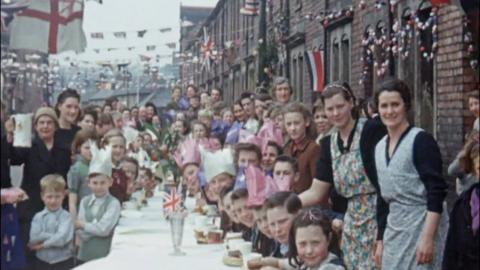
People were so happy on VE Day because it meant they would get to see their loved ones again who they had missed very much (just like lots of you are feeling now).
This is a picture of my grandfather who was away from his family for so long that his daughter (my mummy) didn't recognise him when she went to pick him up from the station. She was 4 years old - the same age as many of you. She said, 'Is that tall man really my daddy?'
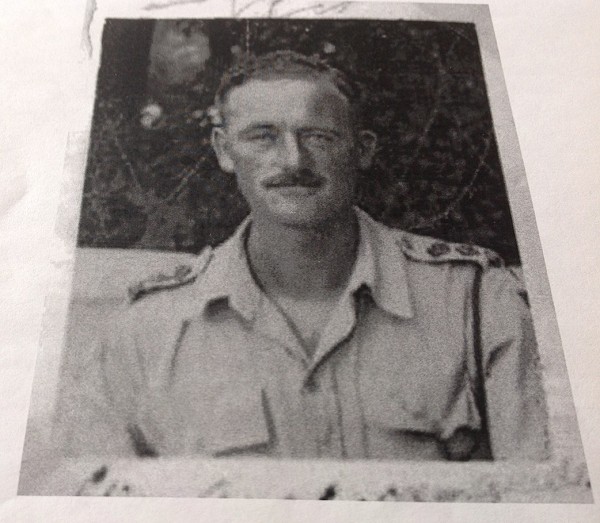
This picture was on the mantelpiece above the fire in my mummy's living room during the war and when she was a bit naughty she used to hide under the table so he couldn't see her!
My mummy tells me that on VE Day in 1945 there was a street party on her road. Everyone was hugging, singing and dancing and even crying a bit - but that's ok because they were tears of joy (sometimes people cry because they are relieved - when they are happy that things are now ok). She can remember waving flags just like these children.
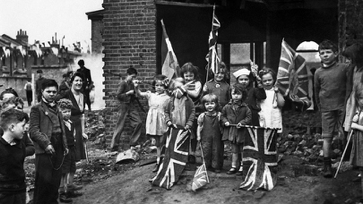
You might want to ask your mummy, daddy or whoever looks after you to have a go at making this street party inspired treat. It looks delicious!
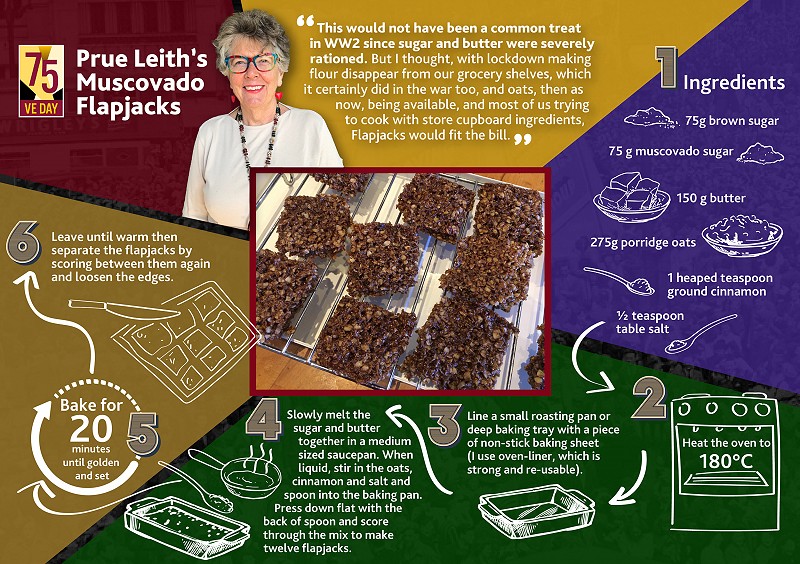
Please take some time on Friday to think about and thank all the people who helped keep our country (and others) going during the war and who helped it come to an end so everyone could be together again and safe.
Your mummies and daddies and people who look after you may be able to tell you some stories about people in your family - wherever they lived in the world - who did important jobs during the war.
People who did important jobs weren't only in the army - my other grandfather was a miner who made sure there was enough coal for the country and my granny was a teacher. She worked very hard to make sure all of the boys in her class were ok because it was quite scary where they lived. During the war a lot of planes used to fly over where they lived to reach the city nearby (Coventry) so they could drop bombs and this was quite frightening for the boys and their families. She used to give my mummy an extra big hug every time she came home from work. There's a picture of her with her class below.
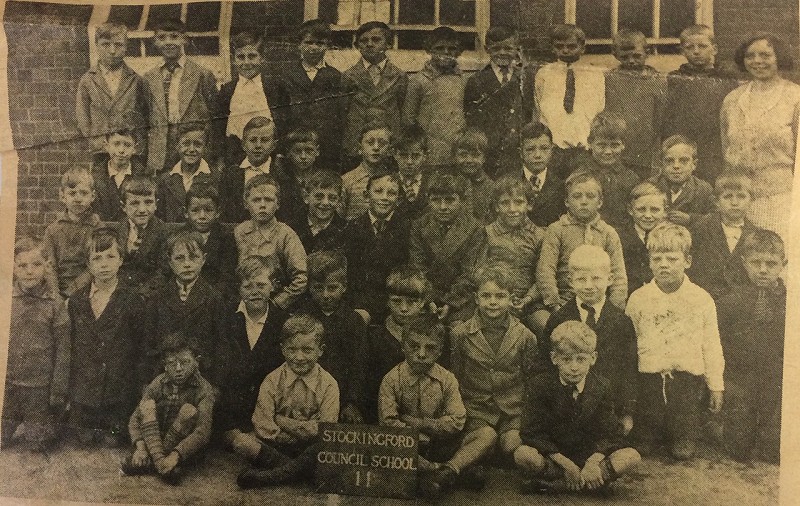
If you have any stories or photos you would like to share please email them to: info@scsj.rbkc.sch.uk
A New Month!
We are in a new week, and a new month! It's now May (April is finished!) but can you use our Season Spinner to find out what season we are in?
Barn Owls: Use your sounds to find the word that says 'M-ay' then check the season. When you find out what it is, see if you can write today's date and the season. I'd love to see your lovely writing: send a picture to info@scsj.rbkc.sch.uk
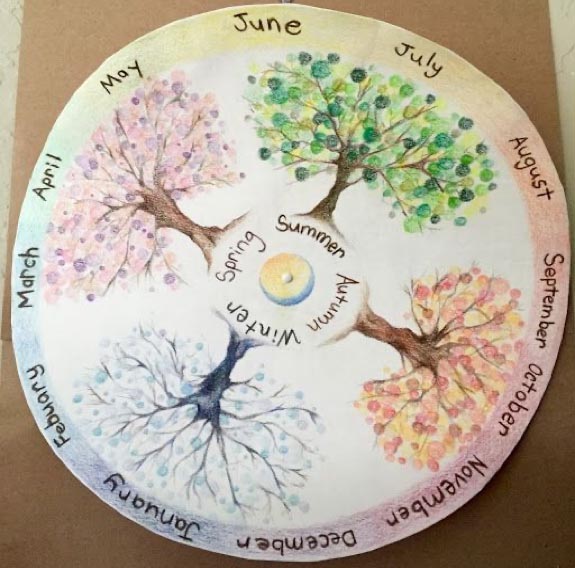
Lovely Learning
Luka has told his own version of The Enormous Turnip and it goes like this:
"Once upon a time, there lived an old lady and an old man and a cow, a cat, some chickens and some baby chickens. There was a big big big pumpkin that they wanted to eat! They chopped the top of the big pumpkin with a saw and they gave themselves a little bit out of the pumpkin and then they left the rest of the pumpkin for tomorrow. And when it was tomorrow they ate all of it and got fat! The end!"
And Wilfred has told his version, and drawn all of the characters in it:
"There was a enormous turnip, there was an old man pulled the gigantic turnip. Tug... The old lady helped the old man. Tug... The big brown cow pulled, the pot bellied pig helped. Tug... Three black cats pulled. Speckled hens pulled. The goose pulled, followed by a yellow bird. A little mouse pulled. They did a big, big tug and the turnip pounced out. That was hard work! The old man made turnip soup."
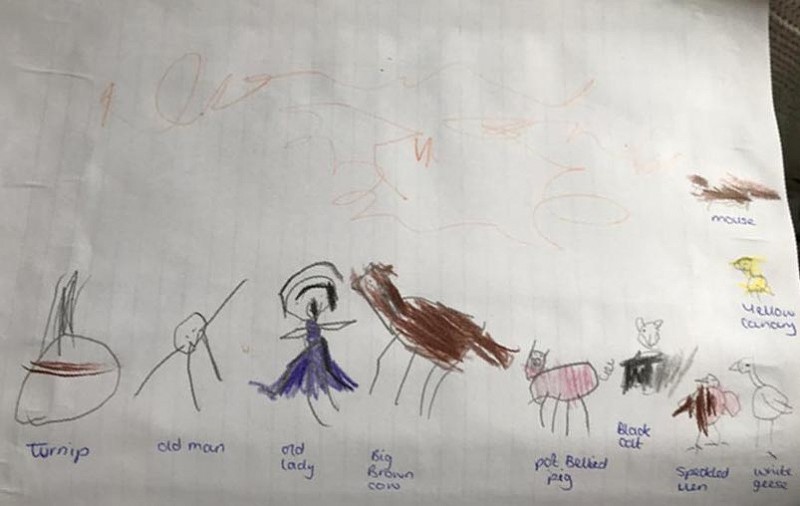
Ardit has drawn the animals in the story and then made a fantastic lego number run to represent them - he's even added some extra to his number run so it goes up to 10. Can you imagine what animals he might be representing? Maybe you could draw them?
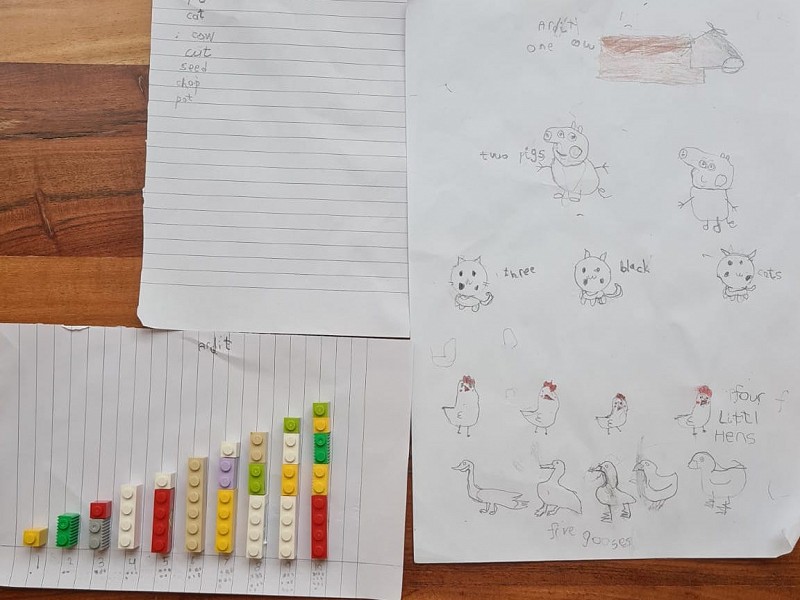
Jayden has been very busy making salt-dough vegetables. Great job Jayden, they look good enough to eat!
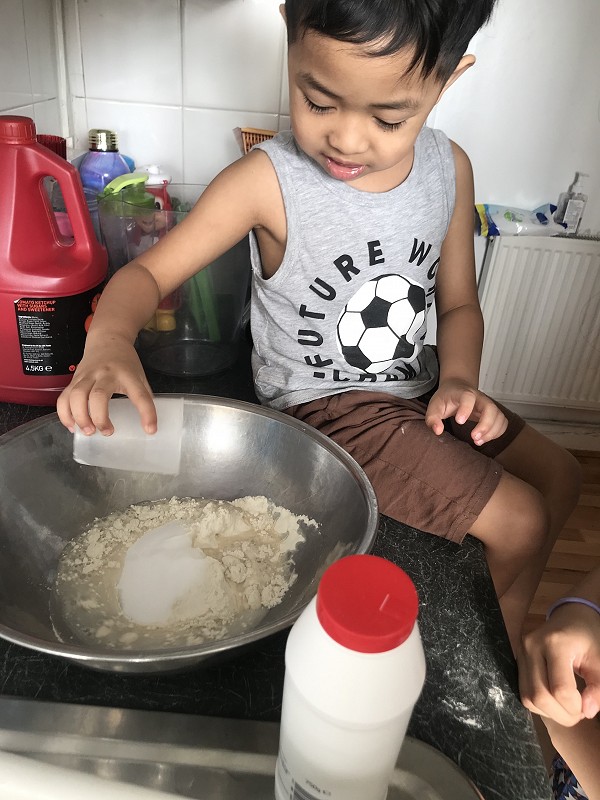
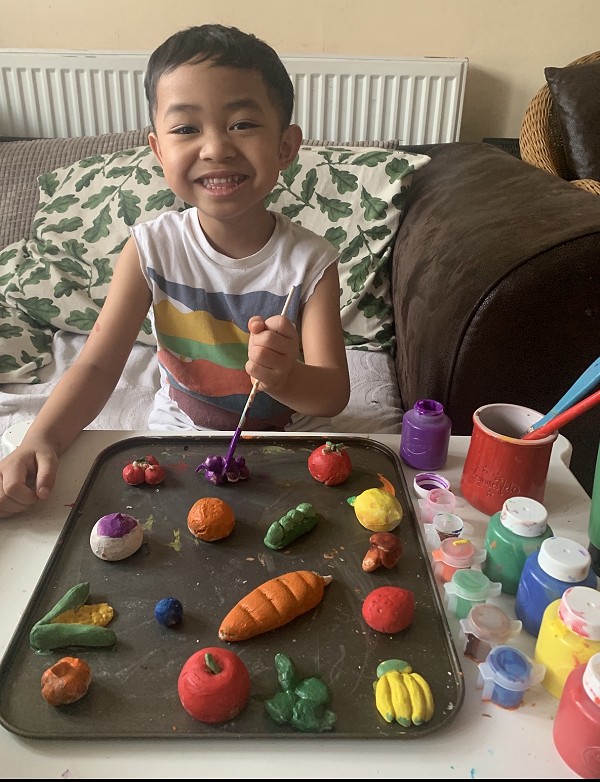
Jack has taken his toy kitchen outside and transformed it into a mud kitchen. Yum! Jack, that looks delicious - is it for mummy?
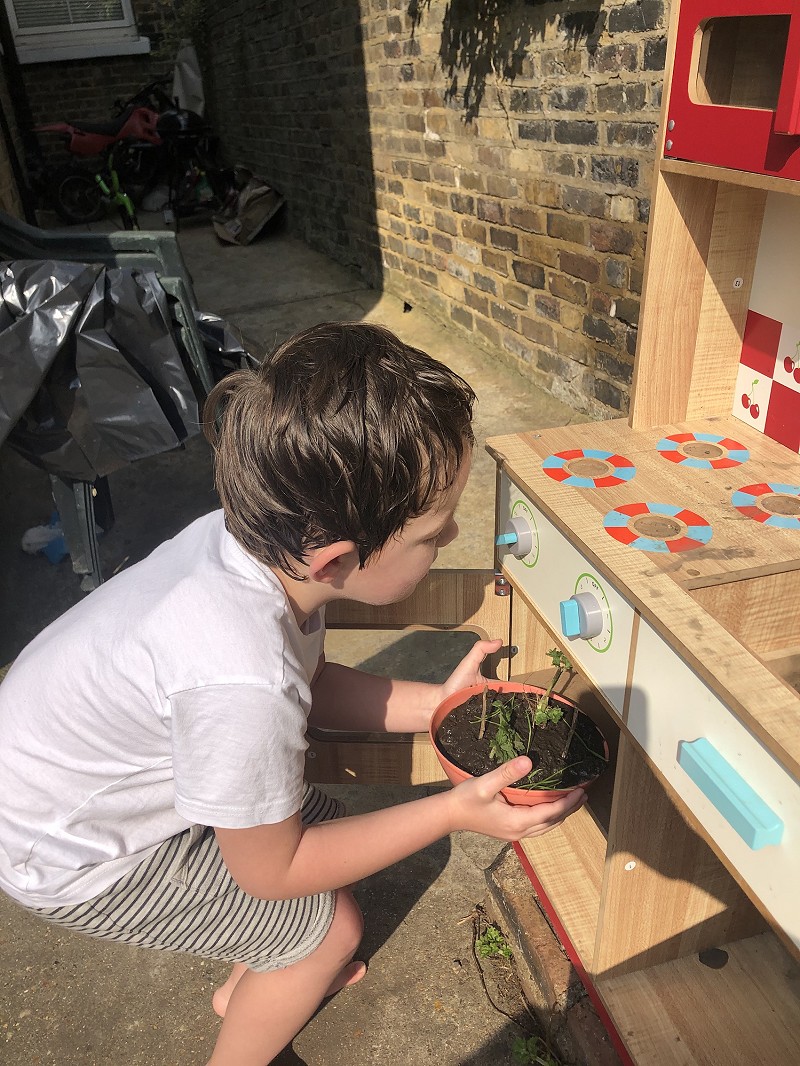
New online activities
The Natural History Museum has a great challenge for budding builders and scientists. Follow the link below to see each week's challenge.
The mission: The LEGO Group and the Natural History Museum are challenging you to predict what life could look like in other parts of the universe. Every Wednesday for four weeks we will be introducing a new environment, inspired by a real moon or exoplanet in our galaxy.
Build: Use your imagination to build your own LEGO® Life Form that could survive in that environment. You'll need to think carefully about what adaptations life might need to survive in those conditions. You can use LEGO bricks or any materials you have around the house.
Share: As all scientists do, make sure you share your ideas! Share your life forms and tell us how they are adapted. Use #NHMLEGO and tag @NHM_Learn@LEGO_Group

Core Text: The Tiny Seed by Eric Carle
Our core text this week is The Tiny Seed by Eric Carle.
Here is another teacher reading the book, with a wonderful story mat behind her. Please watch it then do some of the following activities:
- The seed in the story was really resilient (he kept on going and never gave up). Can you think about a time you kept trying and did your best? How did it make you feel? Can you draw a picture about it? Tell your adult about your picture and ask them to write down exactly what you tell them. Then send a photo of it into info@scsj.rbkc.sch.uk
Bertie has been thinking about one of these times. He has drawn a picture of it, and explains, “This is me and my friends at my swimming lesson. I was trying to swim though my body wasn’t letting me. I kept on trying and in the end my body let me swim. It made me feel fantastic.”
Well done for your resilience and persistence Bertie - you see Barn Owls and Little Owls - practice makes perfect!
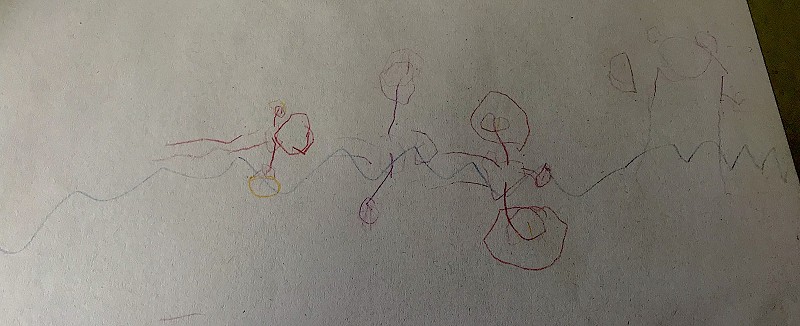
- Make your own story mat to re-tell the story. Remember to make it into a circle because the life cycle of a plant is like a repeating pattern - it happens again and again and again
- Make a garden of colourful flower prints perfect for spring. All you need is some paint, paper, scissors and empty toilet rolls. Be creative and cut the slits as big or small as you'd like (changing the shape of each slit if you want to) and choose whatever colours you'd like to make a really beautiful and cheerful picture.
- What you'll need:
- Empty toilet rolls
- White (or coloured) paper
- Paint
- Scissors
- Get your toilet roll and cut about 1-2 cm slits all the way around. You can vary the size of the slits to change how your flower looks.
- Fold the slits back so it now looks like flower petals.
- Dip into some paint and stamp away on your paper. Use a variety of colours. You can draw stems and the centre of your flower using felt tips or coloured pencils. You can even use some glitter!
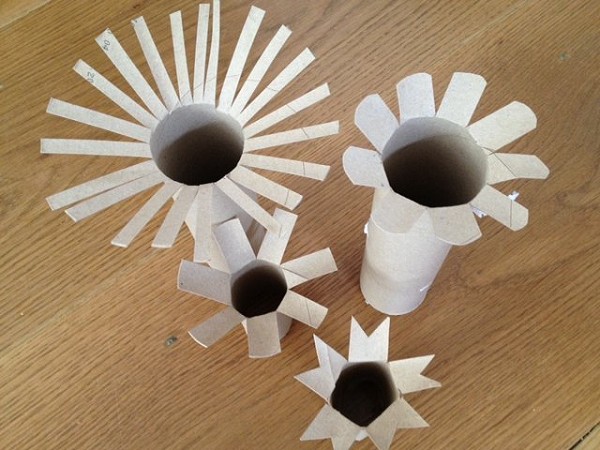
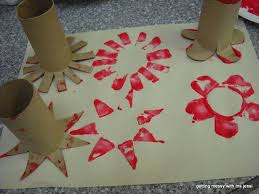
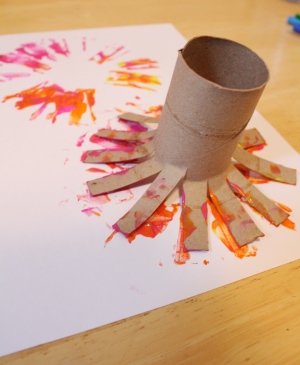
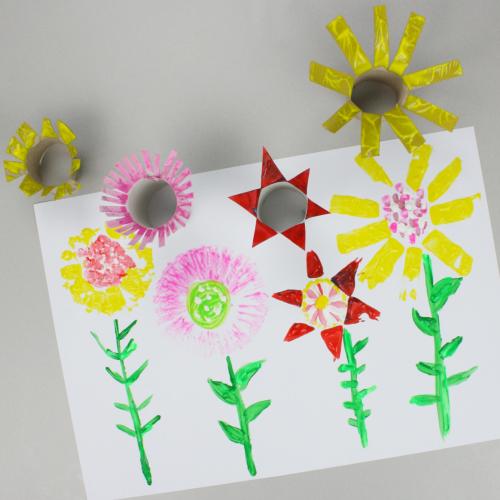
Here is Luka's flower print picture. We love that you've written the date on it as well Luka - fantastic learning!
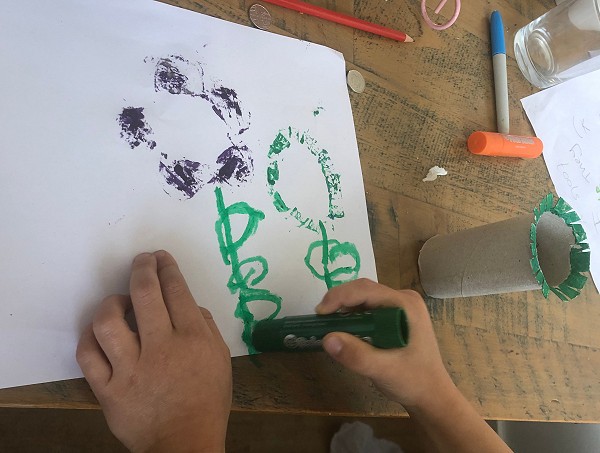
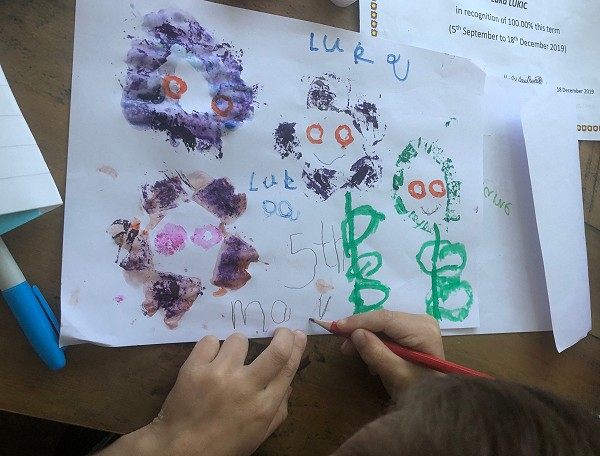
Parent/carers these ones are for you to try, you'll need black paper, white paint, elastic bands, cotton buds, empty toilet rolls, a small paintbrush and cotton wool:
Dandelion painting with toilet rolls
Dandelion painting with drinking straws
Plant the Tiny Seed by Christie Matheson
Watch this interactive story. Follow along with the actions to help the seed grow:
Story of Flowers
Watch this beautiful animation about the life cycle of flowers by AMKK. It carries a wonderful message about resilience (keeping on trying and never giving up):
Many different flowers are growing beautifully and strongly in this world. Taking their roots in the earth, sprouting, blooming, pollination by birds and insects, living on in spite of rain, wind and storms. They pass on the baton of life, rebirth and decay. Everything is so in a continuous, endless cycle.
The Life Cycle of a Plant
If you brought home a bean seed to grow at home, you will have germinated it at school with Mrs Moran (germinate means waking the seed up and helping it start to grow). As the bean grows in the pot it gets flowers, and if these are pollinated by a bee or another insect then the flower petals will drop and the bit that's left (the ovule) will grow into a bean pod. We will be carrying on looking at how our beans grow and hopefully we may see some bean pods later on.
This BBC Bitesize short film tells us all about plant life cycles and how they work. There's a quiz so you can test what you have learnt. Good luck!
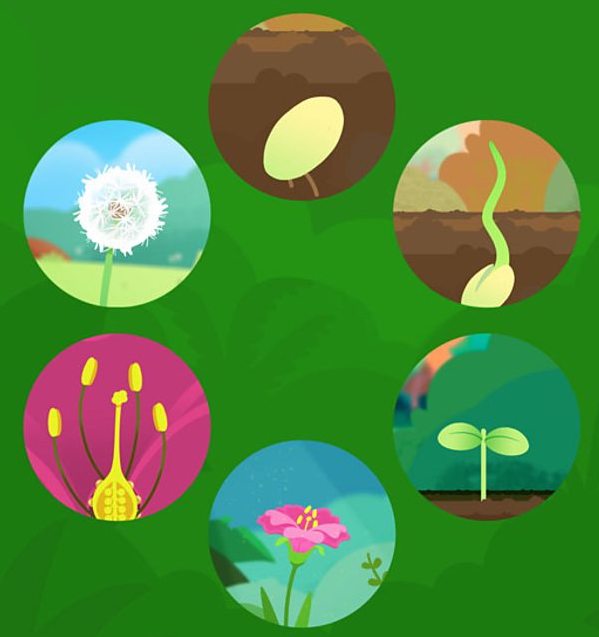
What do plants need to survive?
The tiny seed had a long and perilous (that means tricky) journey. But once a seed lands in the earth and begins to grow, what does it need to survive (keep growing)? Find out in this BBC Bitesize film:
Phonics for Reception
Use your sounds to write these words about the plant life cycle (remember to stretch the word, count the sounds you can hear and then write them - you can use the sound mats and letter formation mat to help you):
- root
- seed
- flower
- soil
- sun
- light
- stem
- bloom
These words are tricky (you can't sound them out easily) but can you have a go at writing them?
- petal
- water
- pollinate
- germinate
- leaves
Have a go at this activity to put together a flower. When you've done it, use your sounds to label your picture.
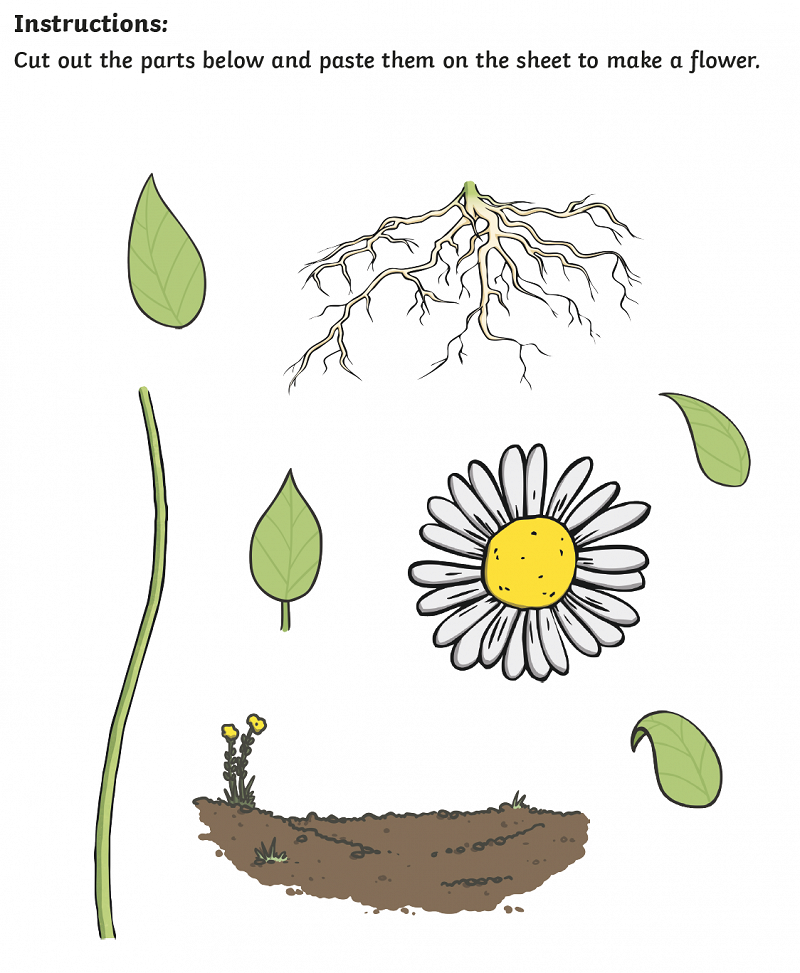
Ardit has already completed this activity - and written a description. Great job Ardit - can you label the different parts of the flower using some of the words we have been writing? I bet Anisa can help you!
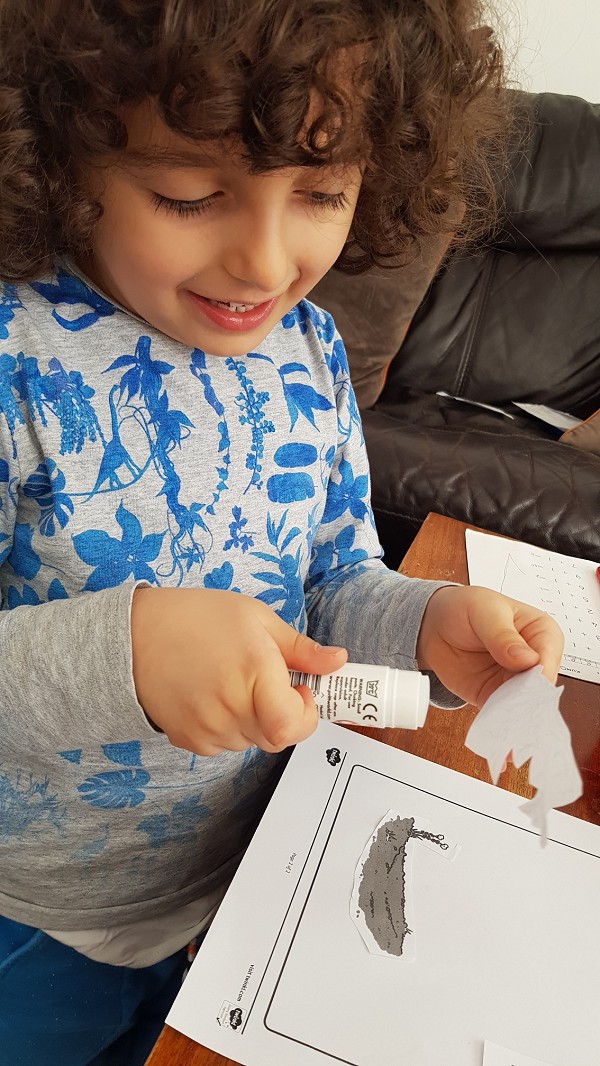
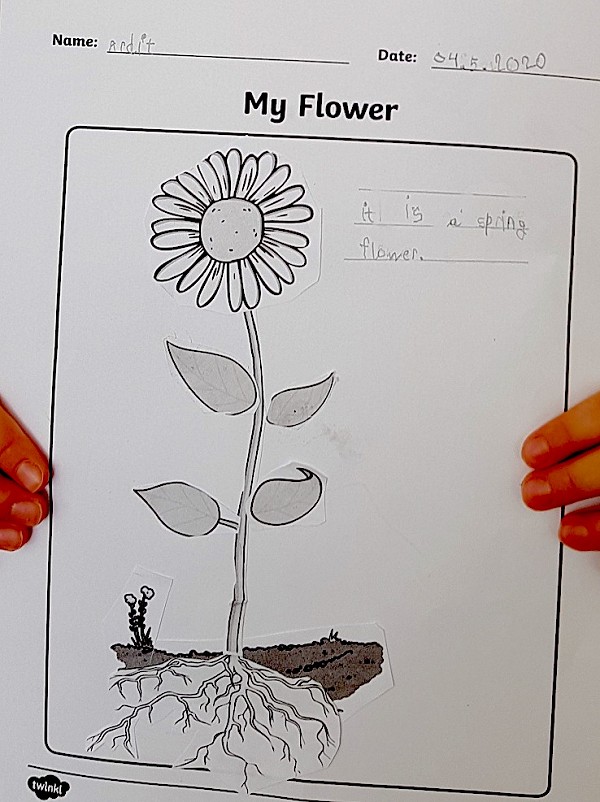
Giselle has been working with her big sister Michelle to use her sounds to label different parts of a flower. Great job Giselle!
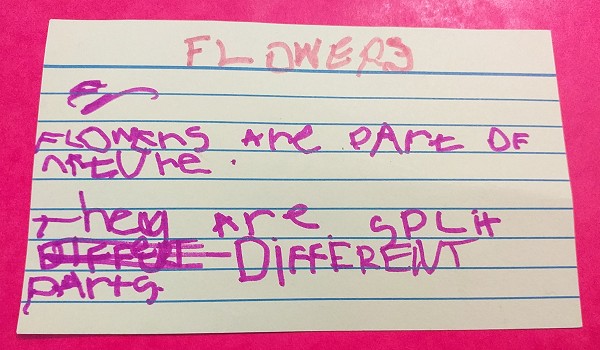
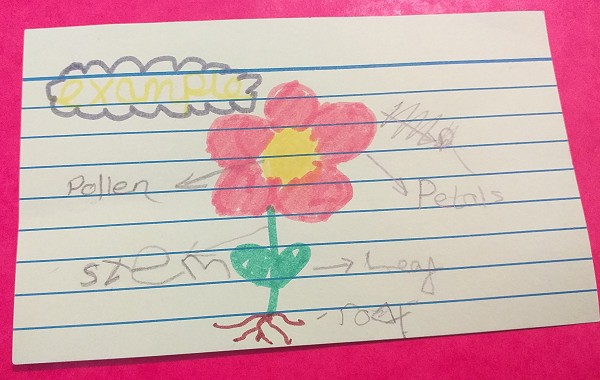
Now have a go at making a book to show all you know about flowers and the plant life cycle. Watch this video to show you how to make your book then draw some pictures and label them using the words you have practised writing.
Here's my book. Bet yours will be even better!
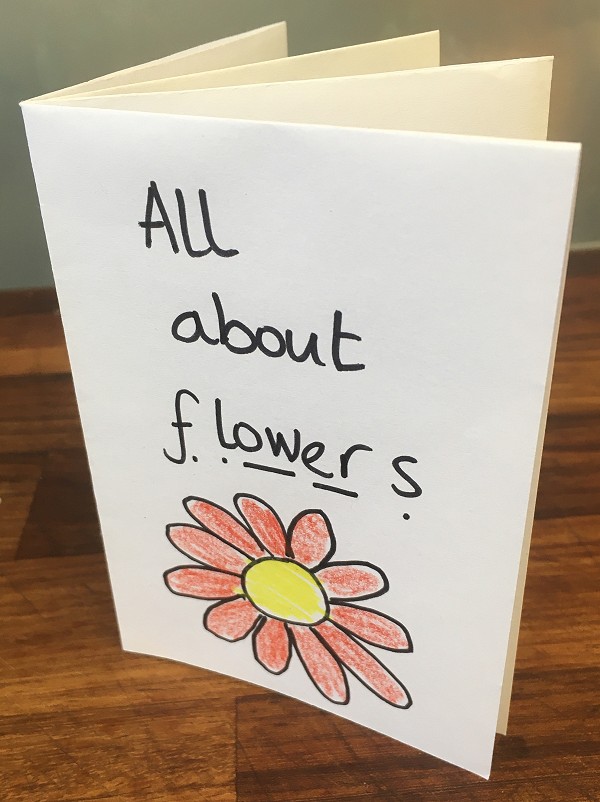
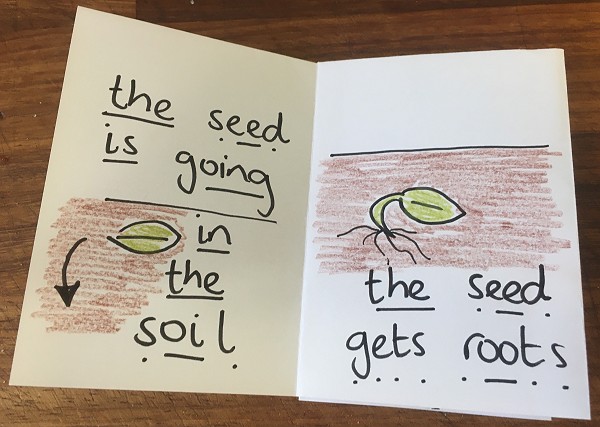
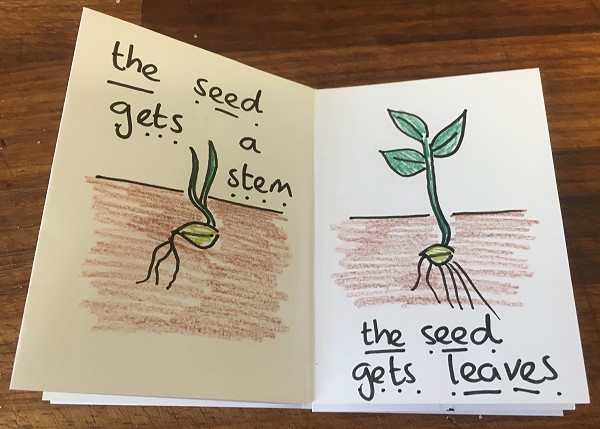
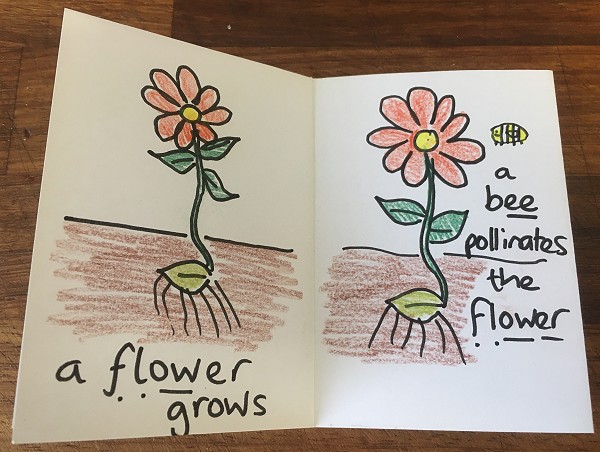
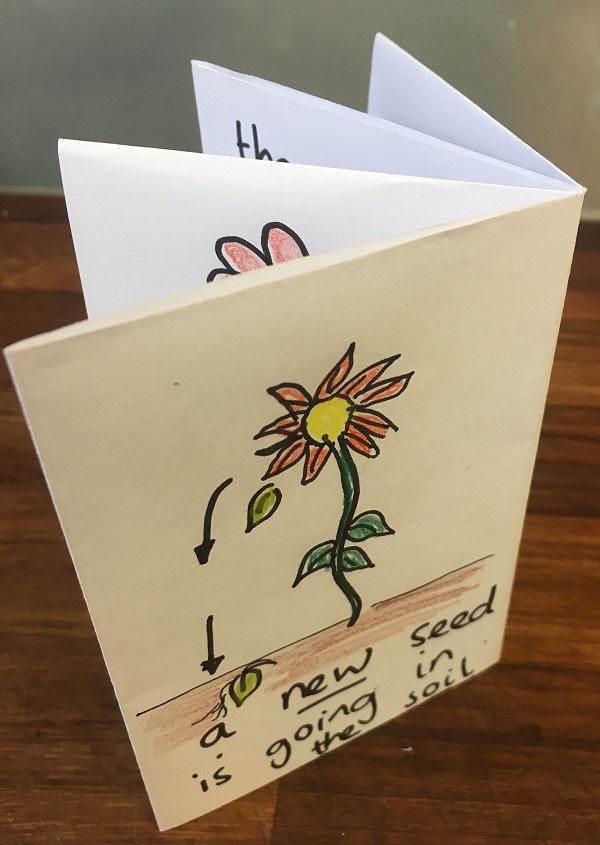
Bean Update

Tuesday 5th May: This is Giselle's bean plant today. Some of the flower petals are beginning to wither (die away) and some have fallen off, but that's ok because it's part of the life cycle of the bean plant. However, and this is VERY exciting, we think some of the flowers have been pollinated (visited by bees or other insects to help them change) because it looks like two tiny bean pods are beginning to grow on the plant.
Let us know how your bean plant is growing by emailing a photo to: info@scsj.rbkc.sch.uk
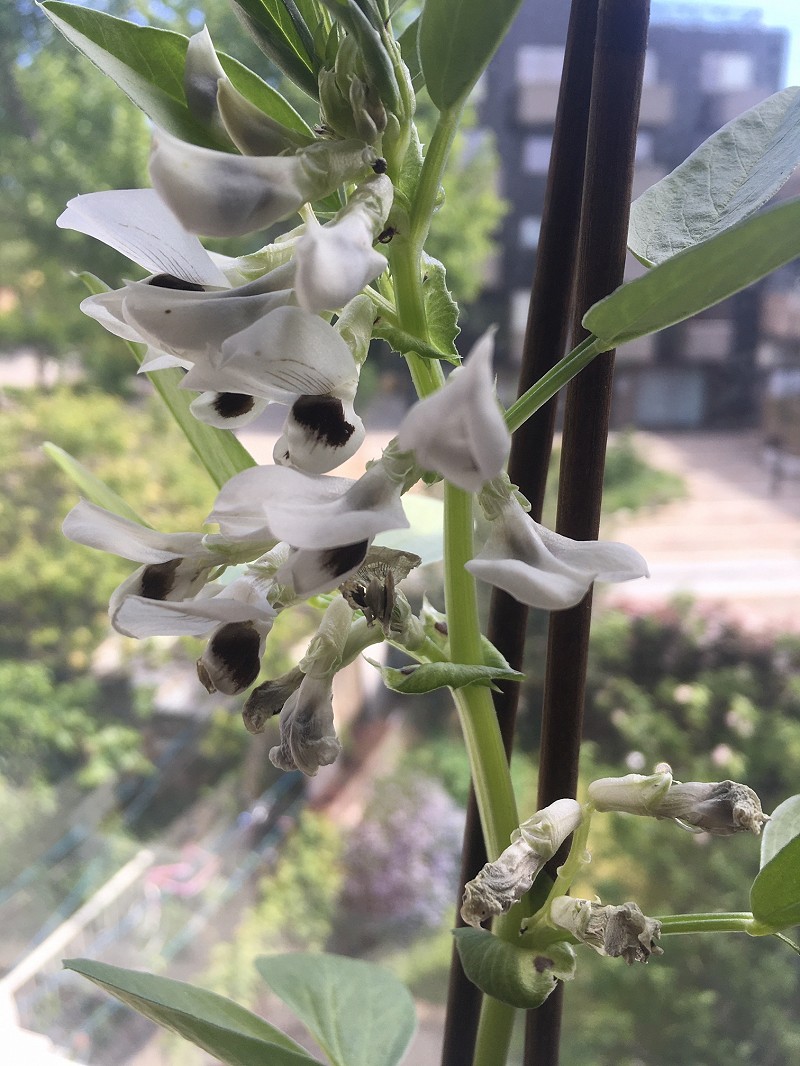
Check out Wilfred's amazing bean plant. It looks very happy and is getting lots of lovely sunlight to help it grow.
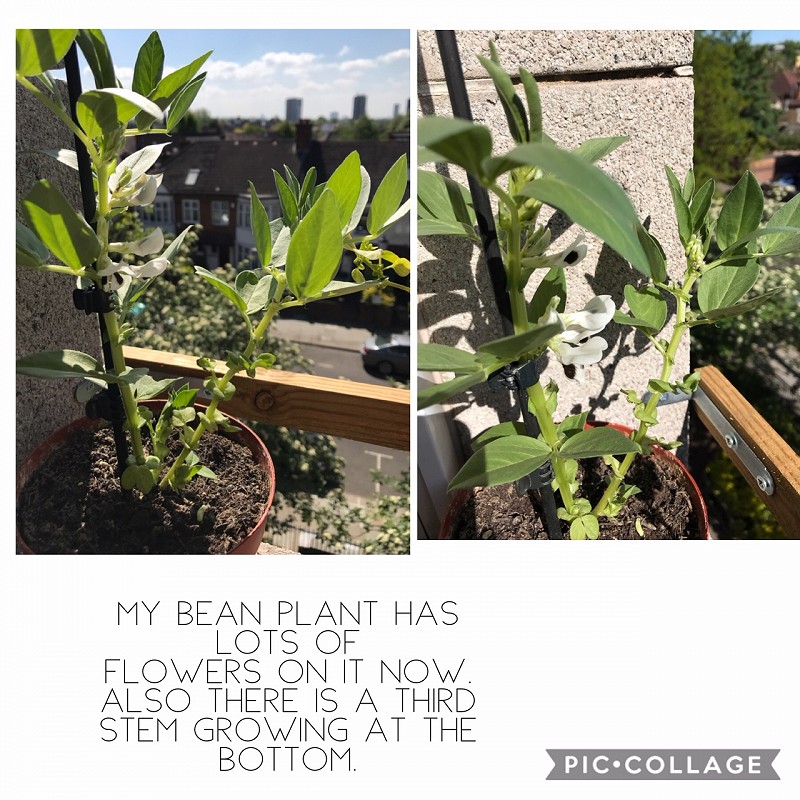
Week Commencing 27th April 2020
This week's news.
Aaron is now 5. His birthday was on Monday the 27th. Looks like you're fighting fit Aaron. Let's give Aaron 5 claps (1,2,3,4,5!) because he'll never be 4 again!
We hope you had a lovely birthday Aaron and send you all our love.x

CBeebies Bedtime Stories
CBeebies has a whole week of bedtime stories with a theme of being away from loved ones, missing hugs and using your imagination, all read by Tom Hardy in his garden. They're all available on iPlayer which you can access via the link below.
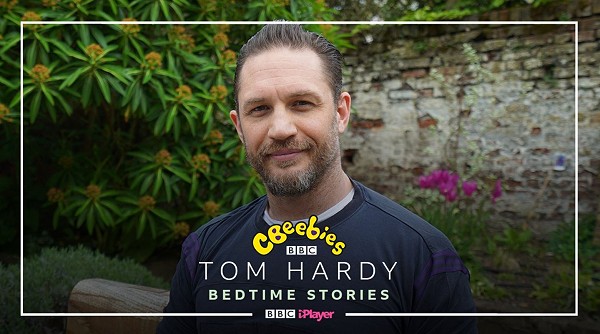
New online activities
The London Transport Museum has released some home learning activities suitable for Barn Owls and LIttle Owls. Click the logo below to go to their web-page and here is a pdf of travel-inspired activities for you to do.
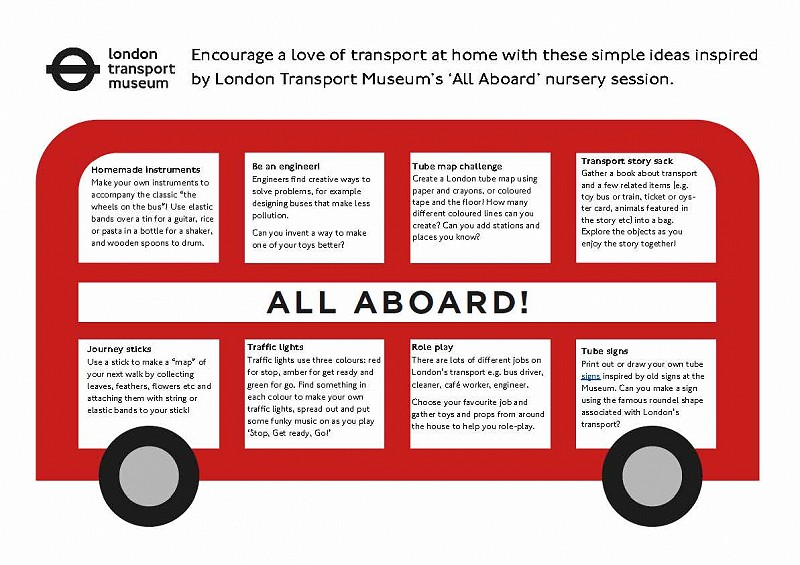
Lovely Learning
Luka has built the most fantastic bird-house with his daddy. What lucky birds! What colour are you going to paint it Luka?
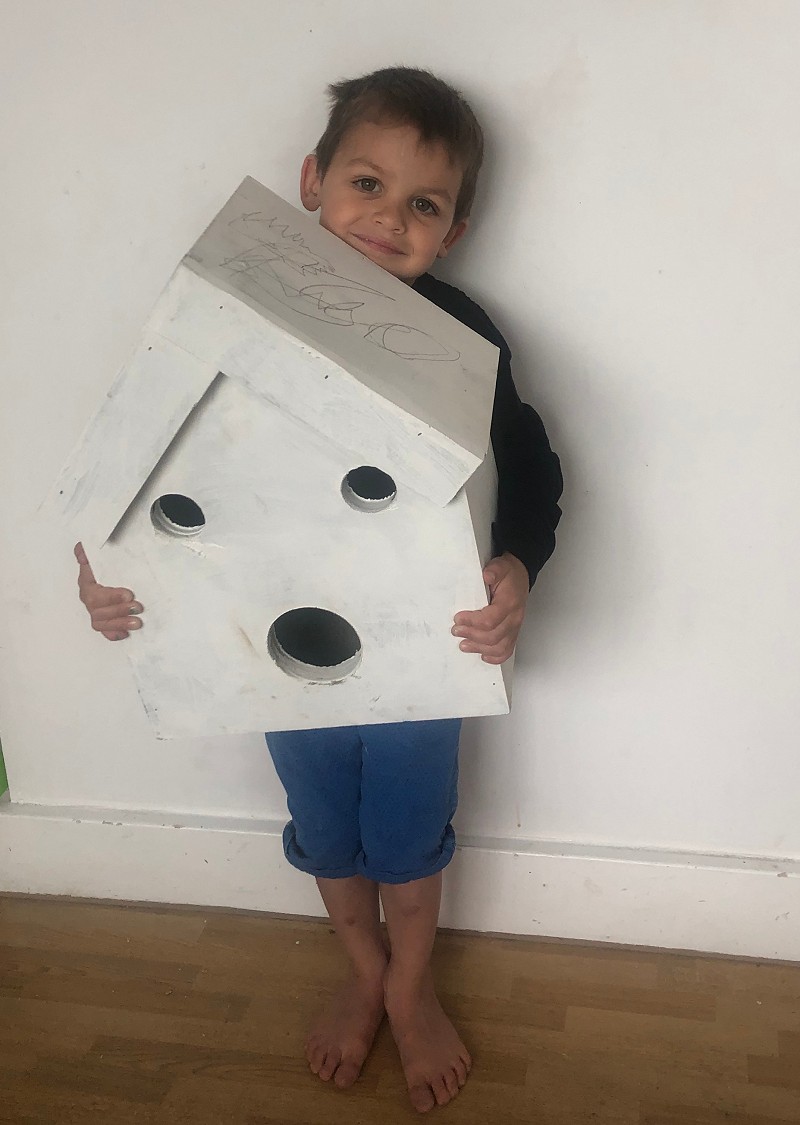
Jayden has been very busy at home painting St George and the Dragon. Great job Jayden!
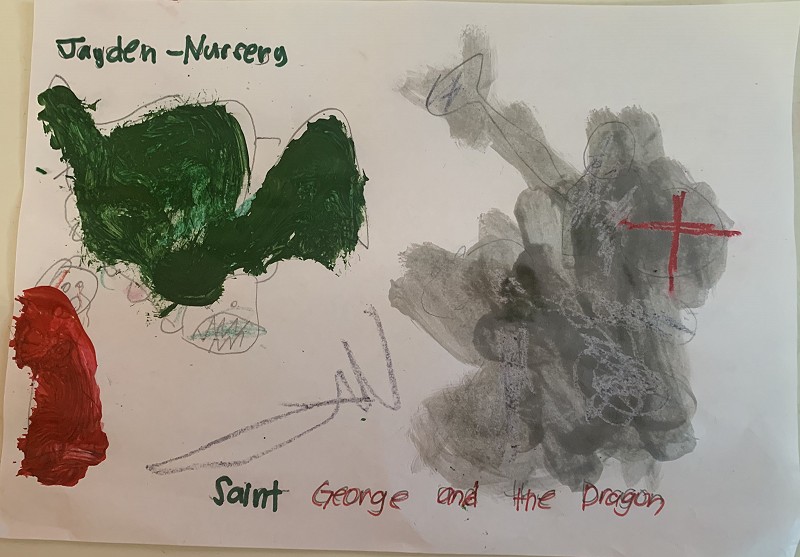
And Ardit has made a beautiful junk modelling dragon (we're all a bit scared Ardit, he looks very fierce!)
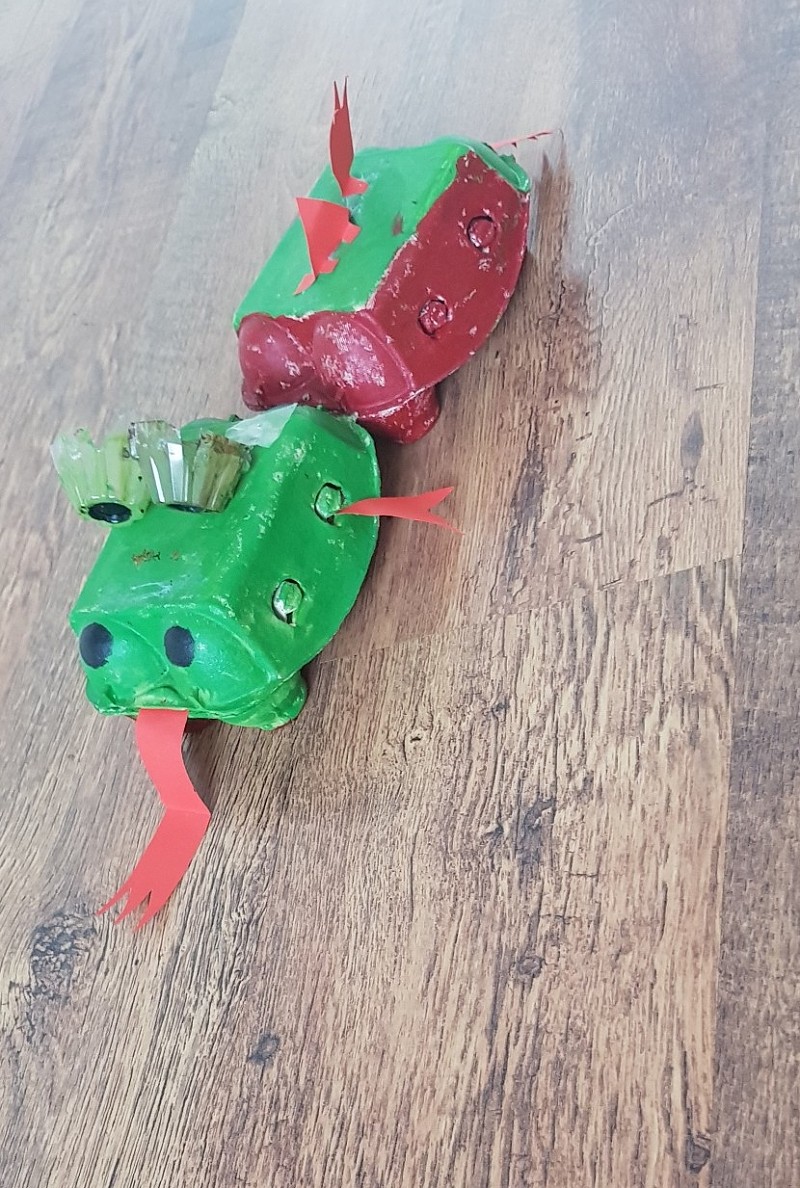
More junk modelling - Anass has made a water bottle robot. He looks like he'd be a very useful friend. Great job!
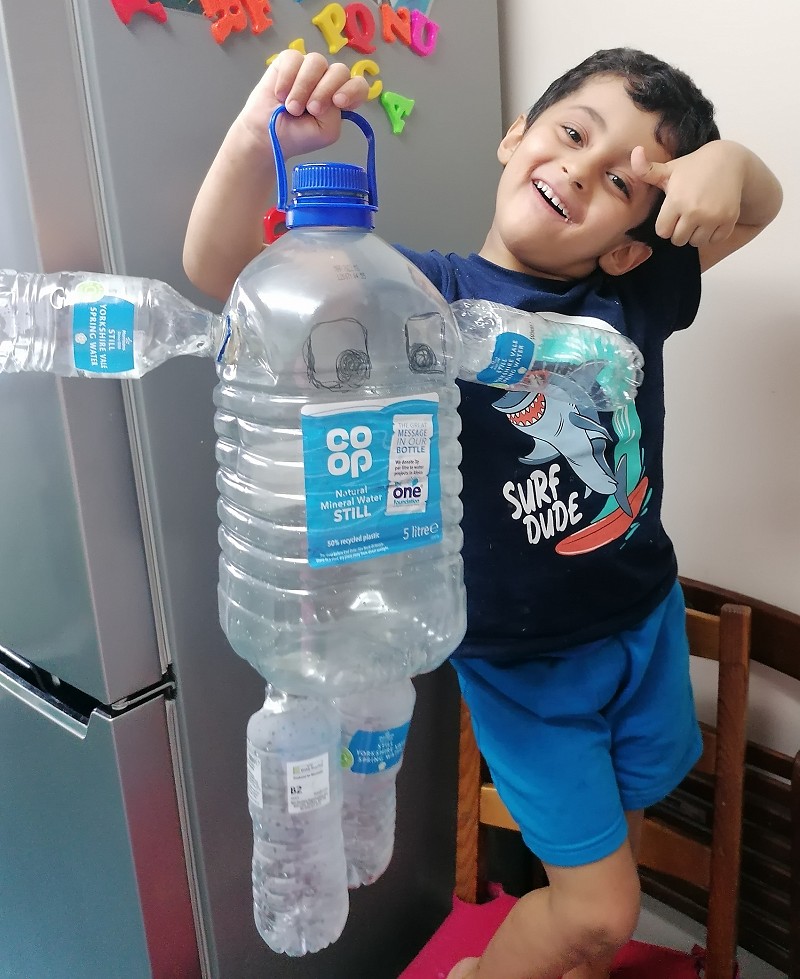
Core Text: The Enormous (or Gigantic) Turnip
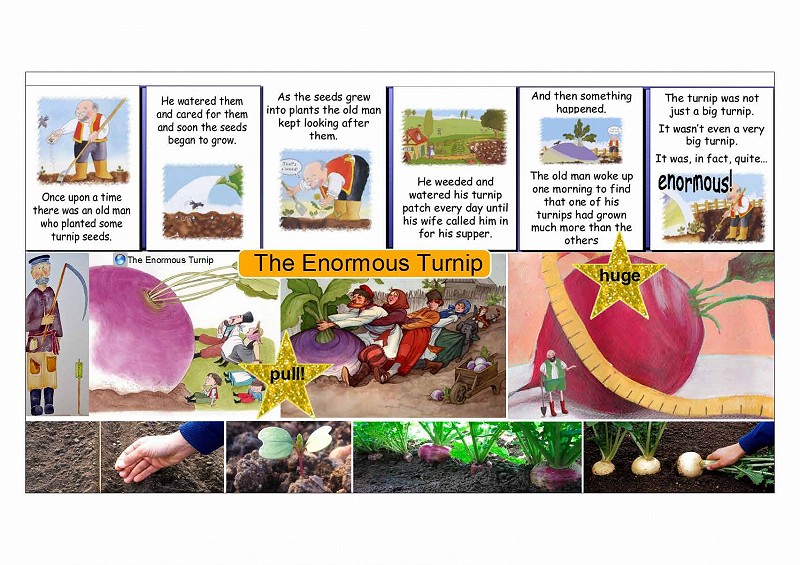
Our story this week is the Enormous (or Gigantic) Turnip. It's a traditional Russian folk tale. We've read one of these before: Baba Yaga and the Little Girl with the Kind Heart but this is a very different tale - there are no witches but there is an enormous vegetable - and a lot of teamwork. Watch the story below then do some of the following activities:
- Draw all of the different characters in the story then put them in order (sequence them) as they pull up the turnip
- Think of some other words for enormous or gigantic
- Tell your mummy or daddy or whoever looks after you your own version of the story. You can change the vegetable and the characters if you like. Ask them to write down exactly what you say and then send it in to us at info@scsj.rbkc.sch.uk
- Make a shopping list for some vegetables (use your sounds to help you)
- Help your mummy or daddy or whoever looks after you to make a vegetable soup. Carefully have a go at chopping the vegetables (with help) and say the following rhyme as you do so: Chop, chop, choppity chop | Chop off the bottom and chop off the top | What there is left, we will put in the pot | Chop, chop, choppity chop.
- Make a shop where you can sell vegetables
- Make salt-dough vegetables and use them in your pretend home (home corner) or shop (instructions are below)
Listen and Play: The Enormous Turnip
This BBC Radio programme has some wonderful listening, repeating and singing activities for our core text. There are parent/carer notes below.
Phonics for Reception
Have a go at sounding out and then writing the following words from our core text:
- dig
- hen
- pig
- cat
- cow
- cut
- seed
- chop
- pot
Now use all of your sounds to write about what you can see in this picture:
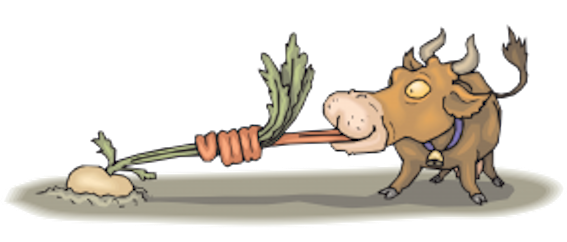
Reception Reading
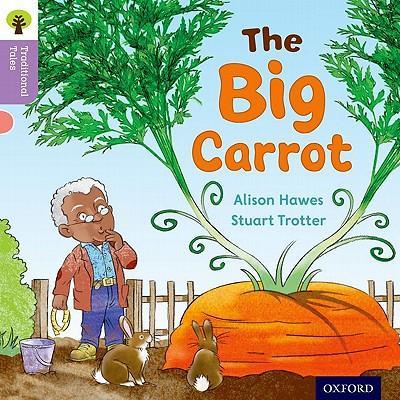
Wilf has been reading 'The Big Carrot' which is a version of our core text. You can access it on Oxford Owl using the link below. I have set up a class account for Barn Owls so you can access all the books on there easily.
Click on the My Class login icon which you can find on the top of the page:
class login: scsjbarnowls
password: letsread

Maths Learning for Reception
Have a think about the animals on the farm in the story. Here's a picture to help you.
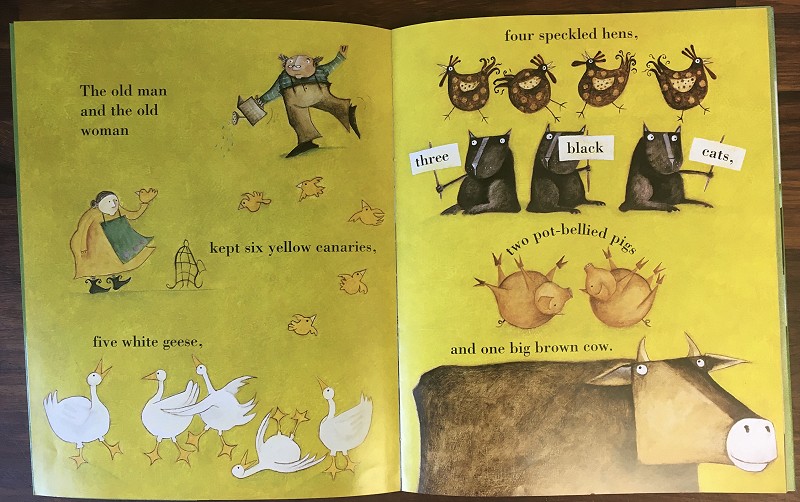
Can you draw them in groups and write numerals (numbers) to represent them?
Our numeral formation rhymes are:
- Go straight down and that is all to make the number one
- Swing it round and then go right to make the number two
- Swing it round and then once more to make the number three
- Down, slide, cut in half to make the number four
- Down, round and put on a hat to make the number five
- Come on down and make a curl to make the number six
Can you make a number run to represent the animals you have drawn? You can use anything you like to represent them - blocks, lego, buttons - you choose! Remember to start with 1 and add one more each time.

Challenge: Look at all of the people and the animals pulling up the turnip.

- Can you add them all together to find out how many there are in total?
- Tell your mummy daddy or person who looks after you your number sentence.
- Can you write an addition number sentence to record your total?
- Remember addition sentences have + (add) and = (is equal to).
Growing turnips from seed to harvest
How does it grow?
A turnip is a root vegetable. That means it grows IN the ground. Potatoes, parsnips and carrots are also root vegetables so grow in the same way as a turnip. Here Auntie Mabel and Pippin explore how carrots grow and how they are harvested at the farm (pulled from the earth, cleaned and sent to the shops for us to buy).
Understanding the World Science Experiment: Grow a Balloon 'Turnip'
Why not try this science experiment - it uses everyday ingredients you may well have around the house.
Questions to ask:
- What is happening to the balloon?
- Why is it getting bigger?
- Where is the gas coming from?
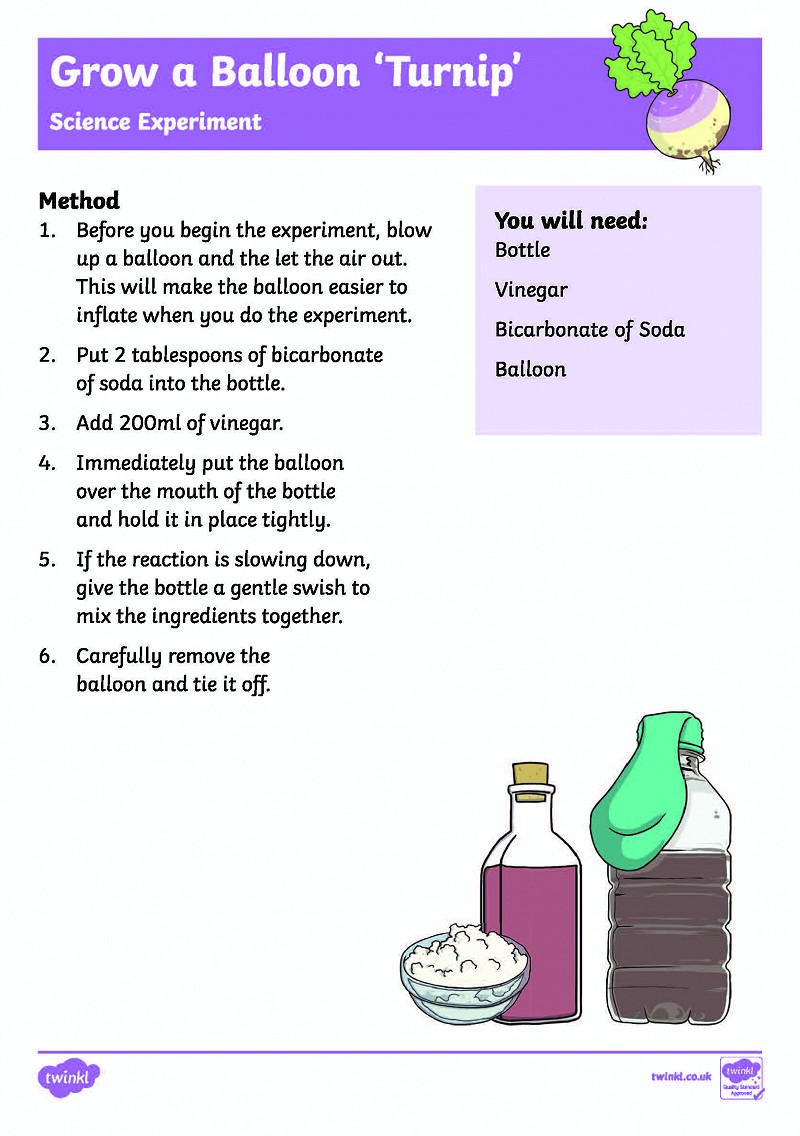
Bean Update
How beans grow (and make new beans) - this is called a life cycle

Giselle's bean is now a very impressive 35cm tall and is now beginning to grow flowers. Very exciting. How are your beanstalks growing? Send a photo to info@scsj.rbkc.sch.uk
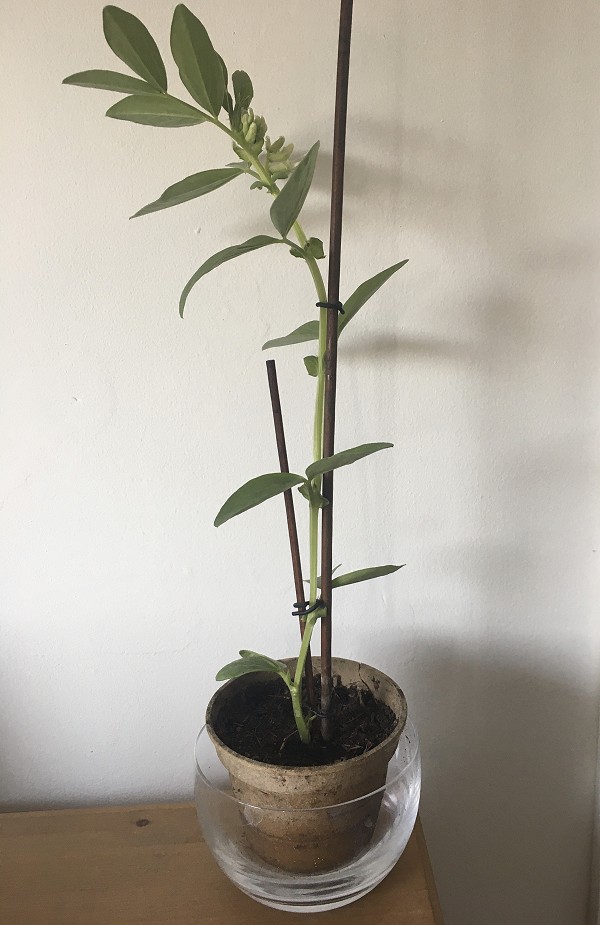
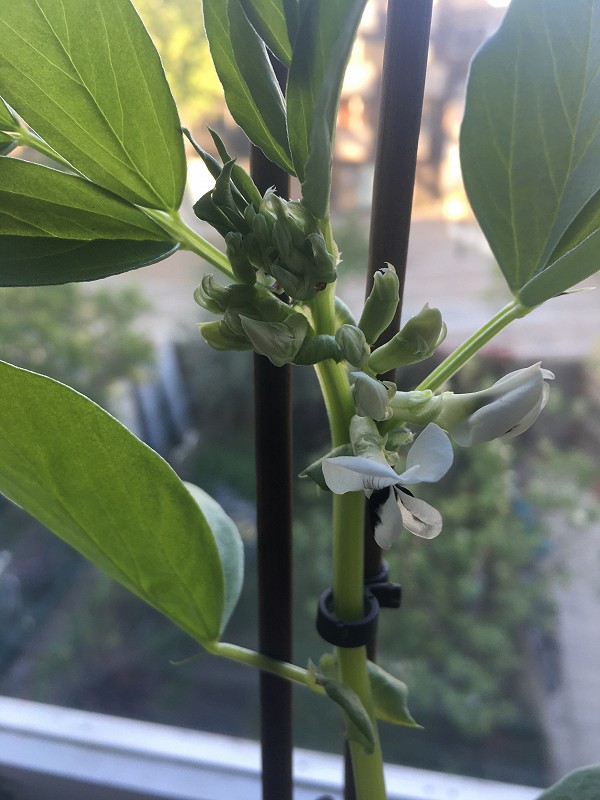
Wednesday 29th April: Giselle's bean has had a lovely morning in the garden. Hoping that some passing insects may see the flowers and pollinate them so we can grow real beans!
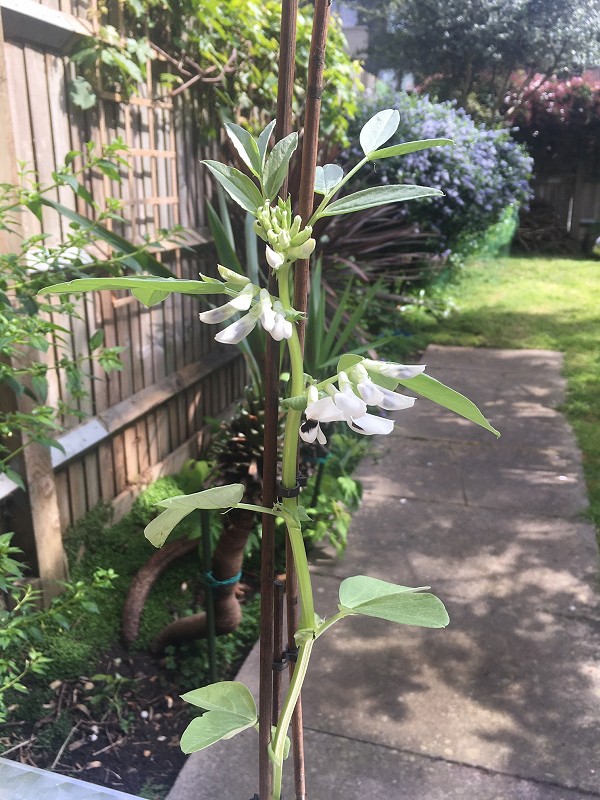
Friday 1st May: Look at how well Wilf's bean is growing. It has lots of leaves, is beginning to grow flowers and is 21cm tall. It also has 2 stems - very impressive!
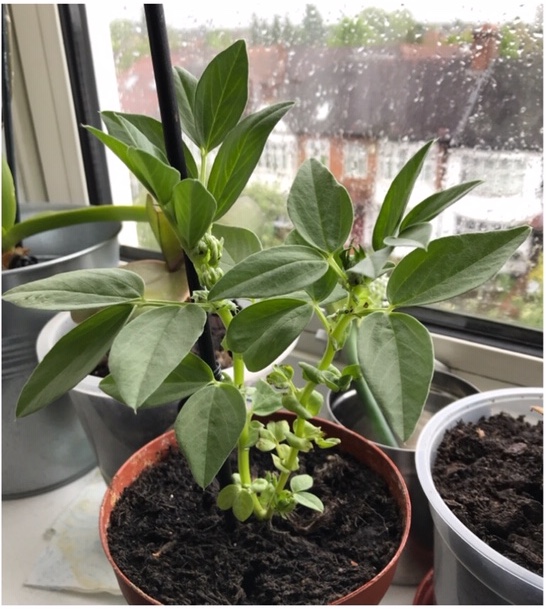
Parent/carers: if you want to give nature a helping hand and your child's plant has flowers then you can have a go at self-pollinating by following this video guide from the University of Sussex.
Week Commencing 20th April 2020
Luka is now 5! His birthday was on Wednesday the 22nd of April. Let's give him 5 claps because he'll never be 4 again (1,2,3,4,5!)
We hope you had a lovely birthday Luka and send you all our love.x
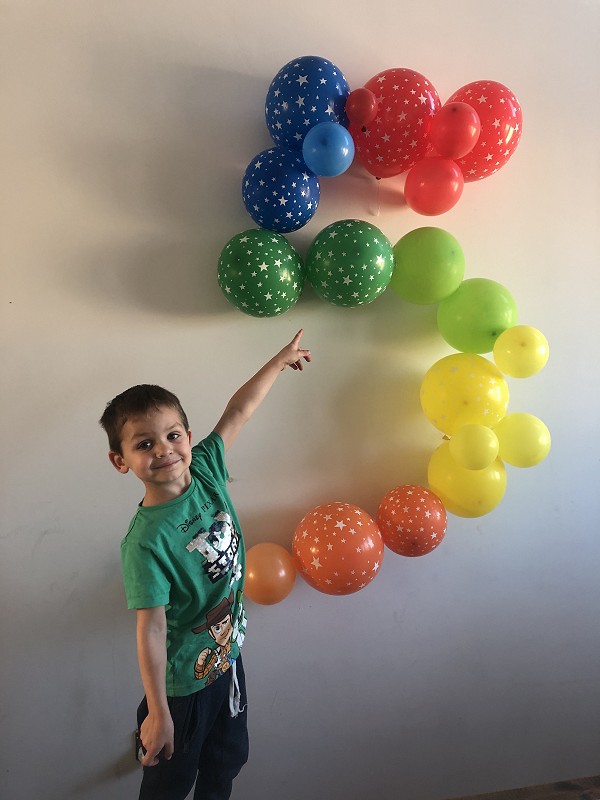
Lovely learning this week
Ari has painted a beautiful fish. Great job Ari!
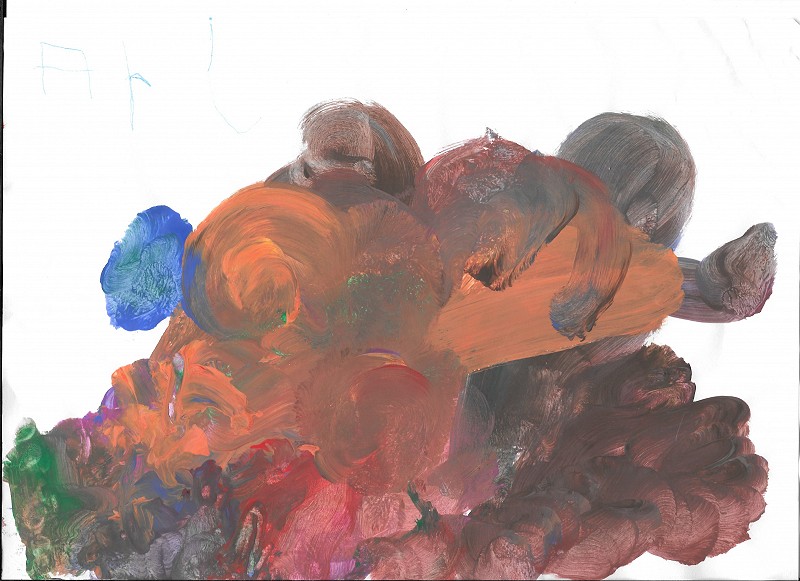
Wilfred and Ollie found some bluebells. Good job boys, Mr Cadman will be SO impressed! Can you remember our bluebell song? (Bluebell Cockleshell) Can you sing and dance to it?
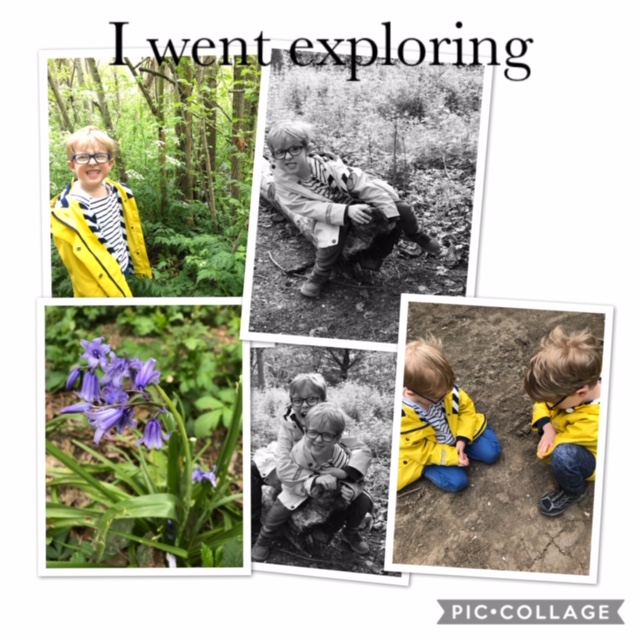
Anass has been very VERY busy. Love your construction Anass, fantastic work, keep it up!
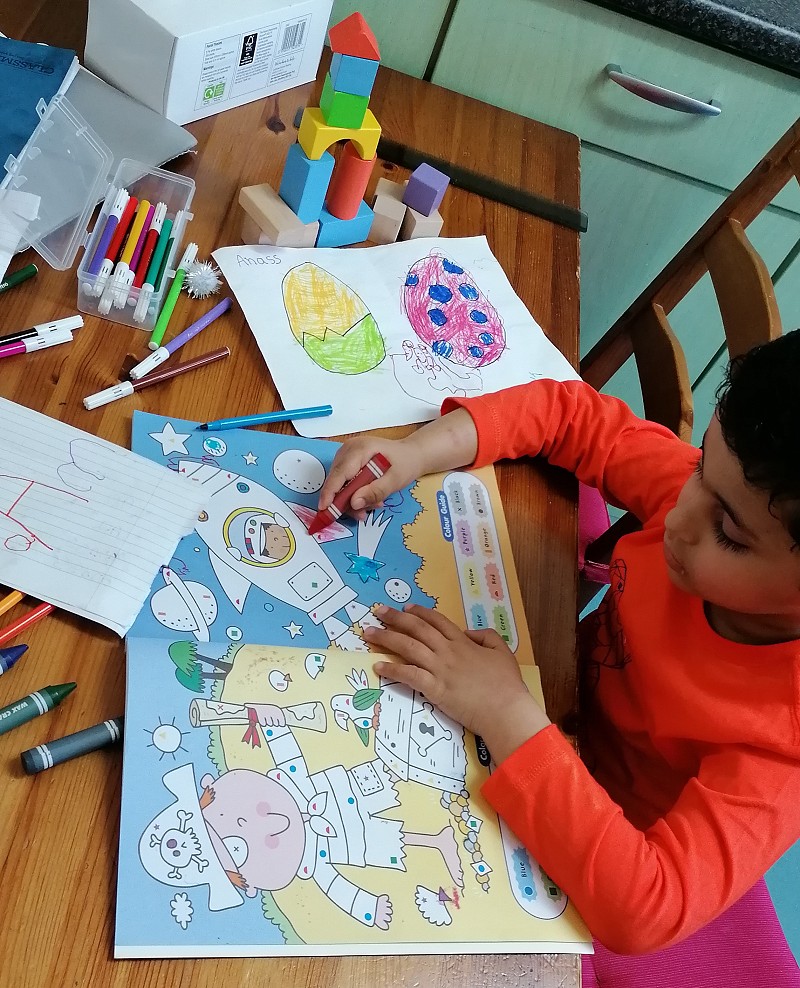
Luka and Lana have been making daisy chains in the beautiful sunshine.
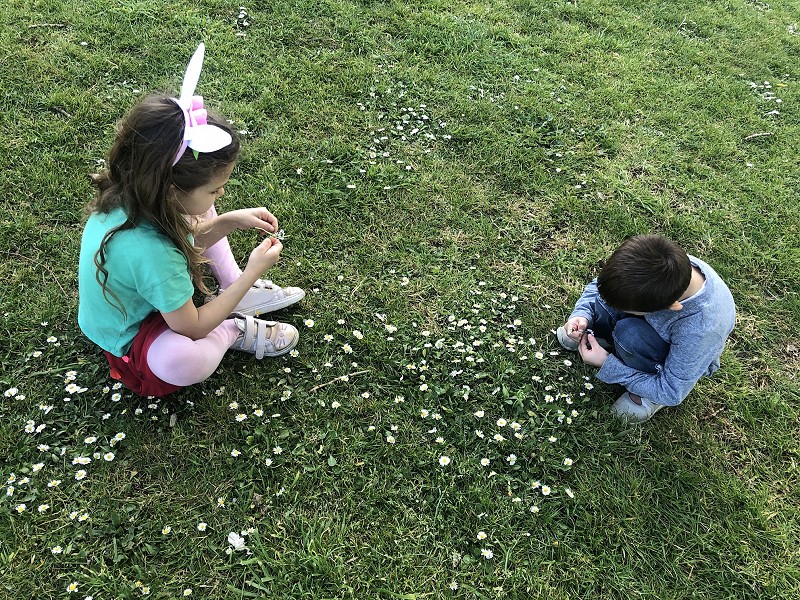
Happy Birthday to Her

Do you know who this lovely lady is? It was her birthday on Tuesday but she has two birthdays every year! One is on April the 21st and the other one is in June, isn't she lucky! If you had two birthdays what would you do on your extra one?
Do you remember when your birthday is? How old are you now? Can you find out how old she is?
Perhaps you would like to make your own crown at home with some tin foil, paper jewels and whatever you would like to add. Then you too can become a prince, princess, king or queen in your own home. Here are some ideas for how your crown might look.
We'd love to see a photo of your wonderful creation. You can email it to info@scsj.rbkc.sch.uk
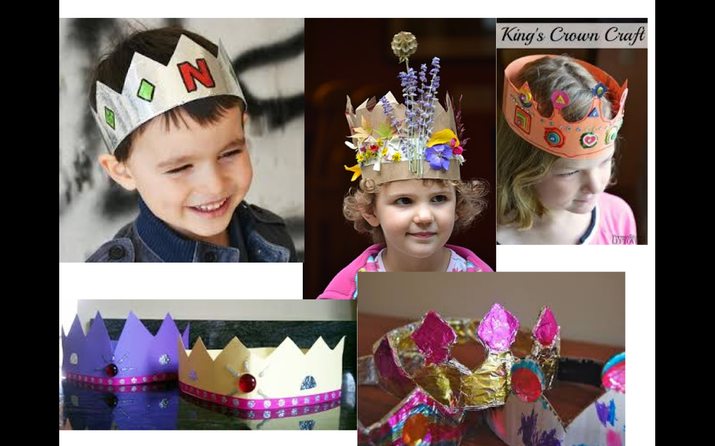
All about Ramadan
Ramadan begins today and is observed by Muslims around the world. The link below will take you to Newsround which explains some more about Ramadan, although this year is very different, with families asked to observe it within their own homes because of the coronavirus. Ramadan is an important spiritual time for Muslims where families pray together and think about and help those less fortunate than themselves. Ramadan lasts for around 30 days and finishes with Eid, which is a special celebration.
Now try this quiz about Ramadan from CBeebies:
Understanding the World: St George's Day
Thursday 23rd of April is St George's Day. St George is the Patron Saint of England. You can find out more about the story and this celebration in these Powerpoint shows.
Let's Celebrate on CBeebies shows us how Sam and Matthew prepare for and celebrate St George's Day. There's also a quiz for you to take and a wonderful poem for St George's Day.
Let's Celebrate St George's Day (CBeebies)
Can you colour and design your own dragon? Give him a name and decide what his special power is.
Saint George and the Dragon by Paolo Uccello
The artist Paolo Uccello painted a wonderful picture of Saint George and the Dragon around 550 years ago. (parent/carers there are some notes below about the picture to help you discuss it with your child)
You can see it on the National Gallery's website and you can even zoom in to look at it up close.
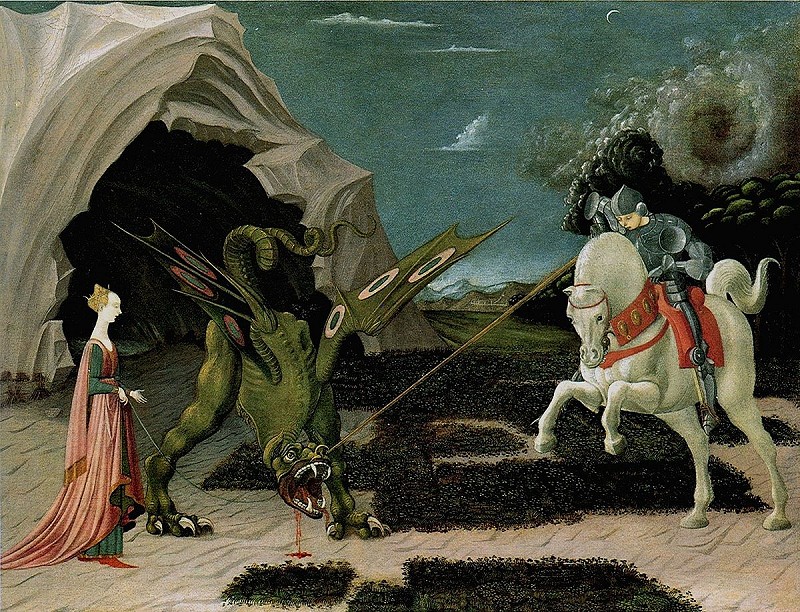
Saint George and the Dragon by Paolo Uccello
Have a really close look and then talk about what you can see with the person who looks after you.
- What do you notice?
- Does this dragon look a bit different to other dragons you have seen? Why?
- Do you think he is the same kind of dragon as the ones we learnt about for Chinese New Year?
- How does Saint George kill the dragon?
Now, can you draw the picture yourself? Remember to include everything you noticed about it.
Here is Luka's drawing of the painting. Luka has 'eagle eyes' and noticed that there is a funny cloud up in the sky. Fantastic observation skills Luka!
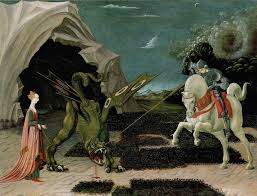
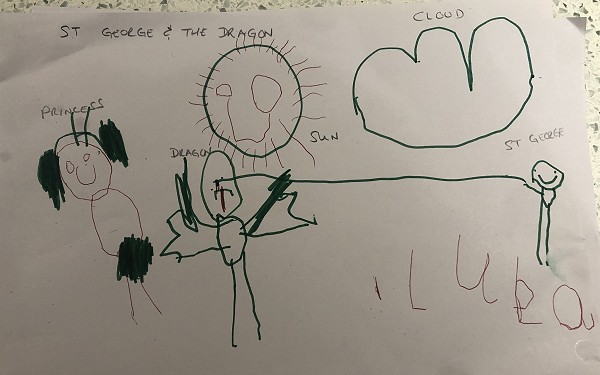
Here is what Wilfred thought about the picture:
Q: What can you see?
I can see a dragon with two legs on each side and the dragon had blood from the neck. George has a spear on a horse. The princess is beautiful and is tied to the dragon. I think she is going to die. But George is going to save her.
Q: Why is the dragon killing people?
It is wrong, he needs to be a kind dragon and be nice to people.
Q: How is it different to other dragons?
It is different, the Chinese dragon had lots of legs and it was red, lots of colours, like a rainbow colour. This dragon is dark green and looks bad.
Q: How does St George kill the dragon?
With a spear.
And here is his drawing:
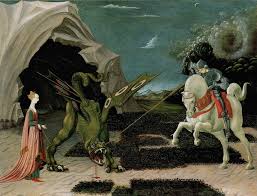
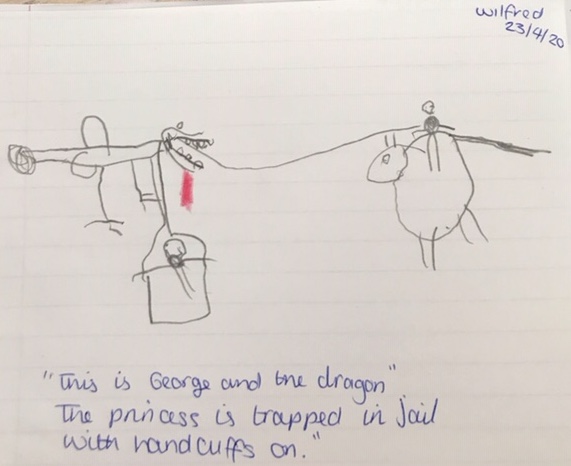
What a brilliantly detailed drawing Wilfred. Great observation skills!
Wilfred and his mum have also found an amazing statue of St George and the Dragon (and the Princess) for us to look at that was created in 1489 - that's around 530 years ago so it's almost as old as the painting we looked at. It's in Stockholm Cathedral in Sweden.
- What do you think?
- Do you like it?
- What do you think it is made of?
- How do you think the artist made it?

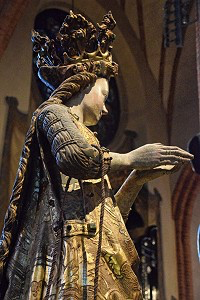
Challenges:
- Can you find Sweden on a map of the world or globe if you have one?
- Explore Google Maps with your mummy, daddy or the person who looks after you - can you find Stockholm Cathedral?
- Can you find a different painting or statue of St George and the Dragon? If you find one you think is really interesting, please send it in to us at info@scsj.rbkc.sch.uk
Core text: George and the Dragon by Chris Wormell
In celebration of St George's Day, our core text for this week is George and The Dragon by Chris Wormell.
Here is the author reading his wonderful story:
Now you have heard it, please do the following activities:
- Draw George and the Dragon
- Make a castle using junk modelling resources
- Imagine what the inside of the Dragon's cave looks like. Can you make a list of the things he might have inside it?
- Why do you think the Dragon likes to smash up castles? Why do you think he is scared of mice?
- Write a thank you letter from the princess to George
Bean Update!
Look what's happening to Giselle's bean! It's now 18cm tall and looks like it's beginning to develop flowers. If you are growing a beanstalk at home, please send us a photo to info@scsj.rbkc.sch.uk so we can share it on this page.
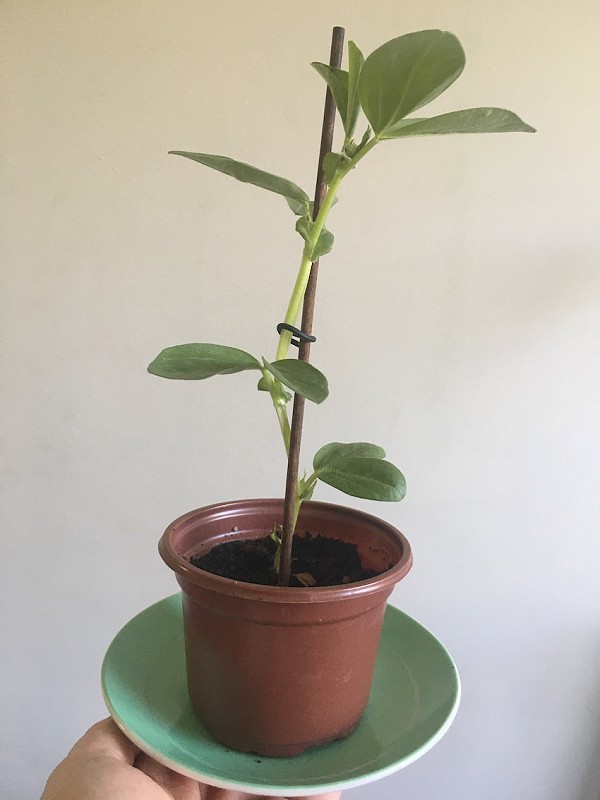
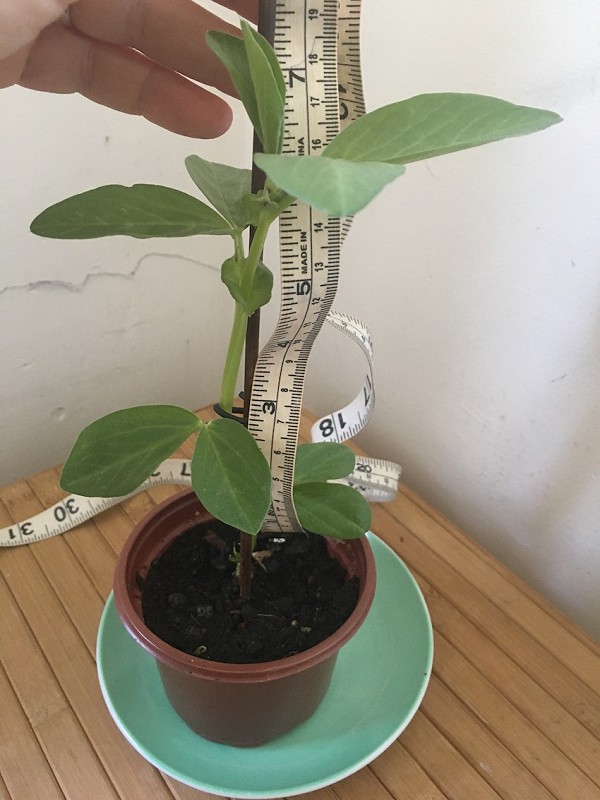
Wilf has shared some photos of his bean journey with us.
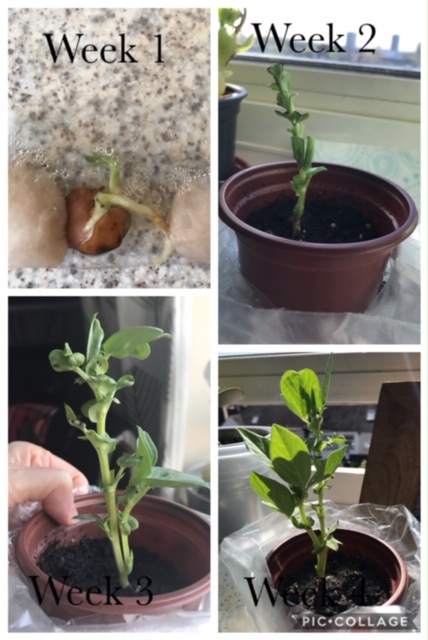
PSED: Coronavirus: A Book for Children
Please share and then discuss this book as a family. It has been carefully written to help explain Covid-19 to young children and is illustrated by Axel Scheffler.
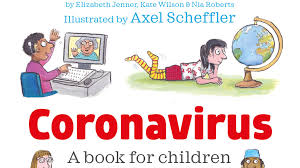
Coronavirus: A Book for Children
Literacy: Reading and Writing for Reception
Now you have read the Coronavirus book together, can you use your sounds and high frequency words to write a thank you letter to (and draw a picture of) someone who is helping to look after us all at this time?
It could be:
- someone who looks after you at home
- someone who works for the NHS or caring for people
- someone helping to keep food in the shops and in your cupboards
- someone delivering letters and parcels to your home
- or anyone else you want to thank
- you choose.
The sound mats, high frequency word mat and letter formation mat are all on the Daily Activities section of Early Years, under Phonics for Reception. Here is a template to help you to write your words on the lines and draw a picture in the box.
When you have finished your letter, please send a photo to info@scsj.rbkc.sch.uk so we can share your lovely learning on this page.
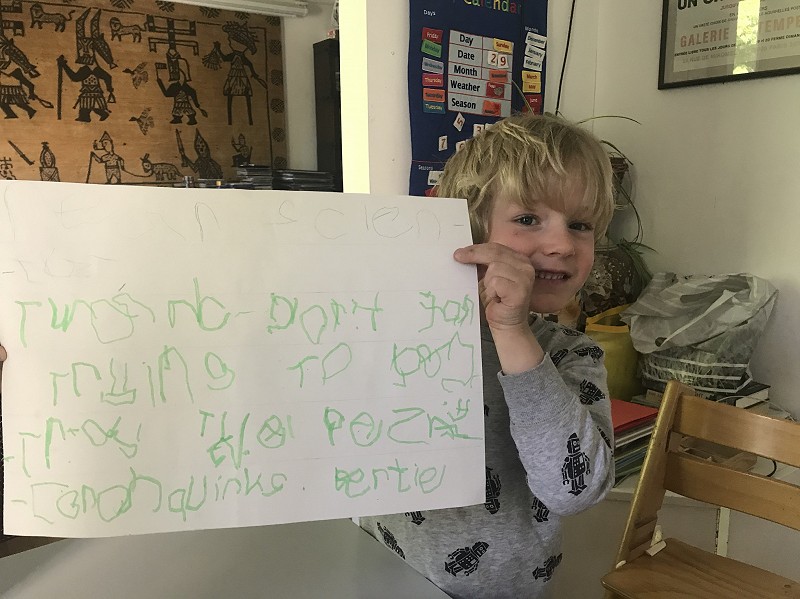
Bertie has written a letter to thank scientists for all the hard work they are doing to create new medicines and a vaccine to help keep us well and safe from the Coronavirus. It reads:
Dear Scientists,
Thank you for trying to destroy the pesky Coronavirus.
Bertie
Fantastic job Bertie, those scientists will be so happy you're grateful for all the experimenting they're doing!
Maths learning for Reception
Take it Away: This week we are looking at taking away (or subtracting). Before doing this task, practise counting on and back using your number line. You can start wherever you want to and count back as many (or as few) as you like.

Then, using objects from your home and your number line, can you make a line of objects then take some away? Count each object as you move it away. How many did you take away? How many are left? Count to check by saying one number name for each object. You can check you are right by making the same number of jumps back on your number line.
Challenge: Count back by putting the amount you had to start with in your head then putting the amount you are taking away on your fingers and count down as you touch them to your nose, remembering to start with the next number down from the number in your head. So if you have 6 cars and then 4 cars drive away you put 6 in your head and 4 on your fingers to find out how many are left. Touch your fingers to your nose one at a time as you count down '5,4,3,2'. There are 2 cars left.
Recording your answer: Write a maths subtraction number sentence to represent this. For example -
6 - 4 = 2
This means 6 cars take away 4 cars is equal to 2 cars.
If you find it easier, you can draw lines to represent the cars, like this:
IIIIII - IIII = II
For an extra challenge, use more objects and take away a greater number from your collection.
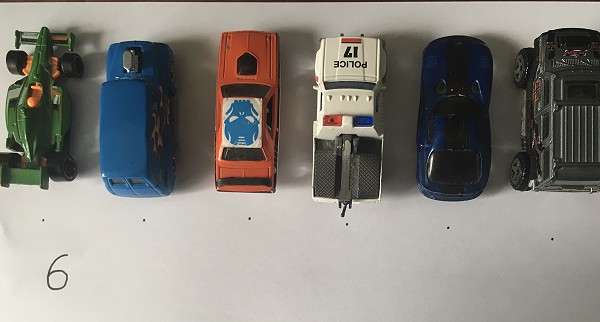
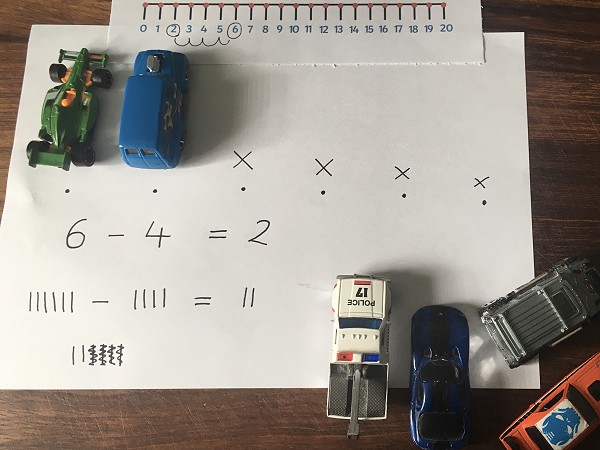
Expressive Arts and Design
Firstsite Art is developing activity packs with lots of amazing projects to do at home designed by contemporary artists. This is Activity Pack 2. We particularly love Chantal Joffe's 'Things to do with a Cardboard Box' activity.

You will be able to download a new pack regularly by using the link below. There are also activities for the whole family on their website.
Firstsite: Art is where the Home is
There are also Create at Home activities for the whole family on their website which are added to weekly:
Week Commencing 30th March 2020
Wishing you a restful Easter break Barn Owls and Little Owls. Please look after yourselves and each other.
With much love,
The Early Years Team.x
Home Learning Pack for Early Years
This home learning pack has lots of really good activities and is suitable for both Little Owls and Barn Owls.
Bean update!
If your sprouting bean is looking like this, it's time to plant!
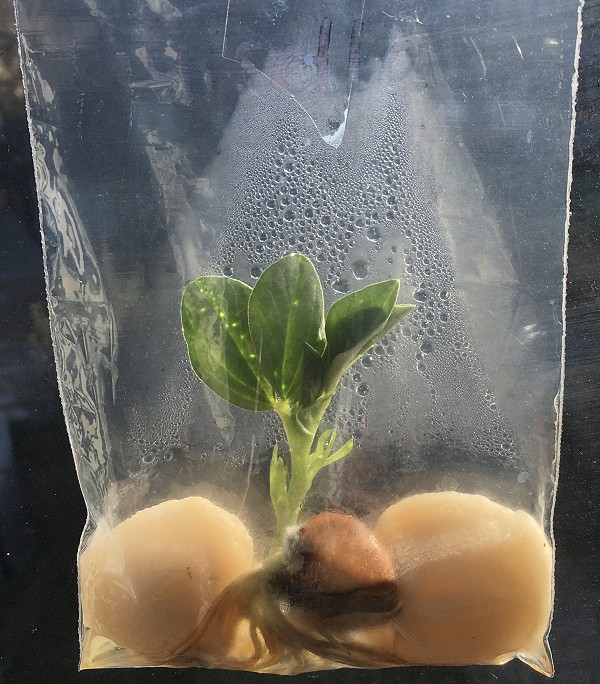
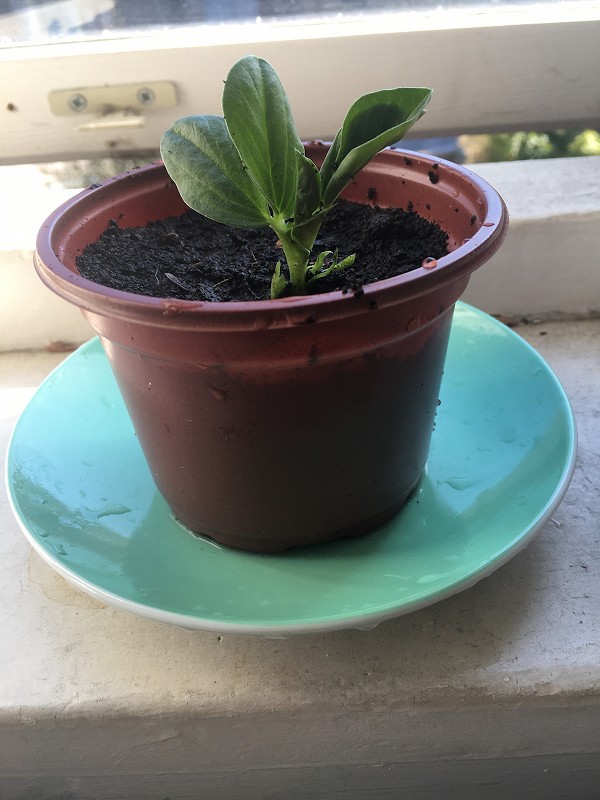
Staying happy, healthy and busy
Please remember everyone, if you can't get outside because you don't have a balcony or garden keep your windows open to let in some fresh air. You can go out for a walk once a day as well as long as you stay close to your family and away from other people. It's important to keep moving and busy. This week, we'd like you to continue using Cosmic Yoga on youtube but also GoNoodle. They have some fun songs and can help you to be calm and mindful:
We're updating this page weekly but keep checking in regularly as we may have time to do so more often.
Daily challenge sheet
Are you up for a challenge Barn Owls and Little Owls? Thanks to our friends at St Thomas' we have some jobs for you to keep you busy until we're all back at St Clement and St James again. Complete as many challenges as you can. Work your way through the list in any order and cross the box when you have finished it. You can always do it again if you enjoy it! Keep your list safe so you can bring it back to school when we are all back together again.
Parent/carers: remember your job is to encourage your child to be as independent as they can with each activity. You can support them through it and show them how to do it first, but remember we all need to give them the skills to be independent ready for September.
If you're in Reception and you usually wear shoes with laces to school then that challenge is especially important! We are hoping that this challenge sheet will help you all to spend some quality time together during this tricky period. Do let us know how you get on and any photos would be especially enjoyed by all the Early Years team! You can email them to: info@scsj.rbkc.sch.uk
Twinkl resources
The wonderful Twinkl has some great resources to keep you busy (away from screens!) There's a free month of access for parents due to school closures so do go and have a look.
Step 1: Go to www.twinkl.co.uk/offer
Step 2: enter this code CVDTWINKLHELPS
We really like these Spring Mindfulness colouring sheets:
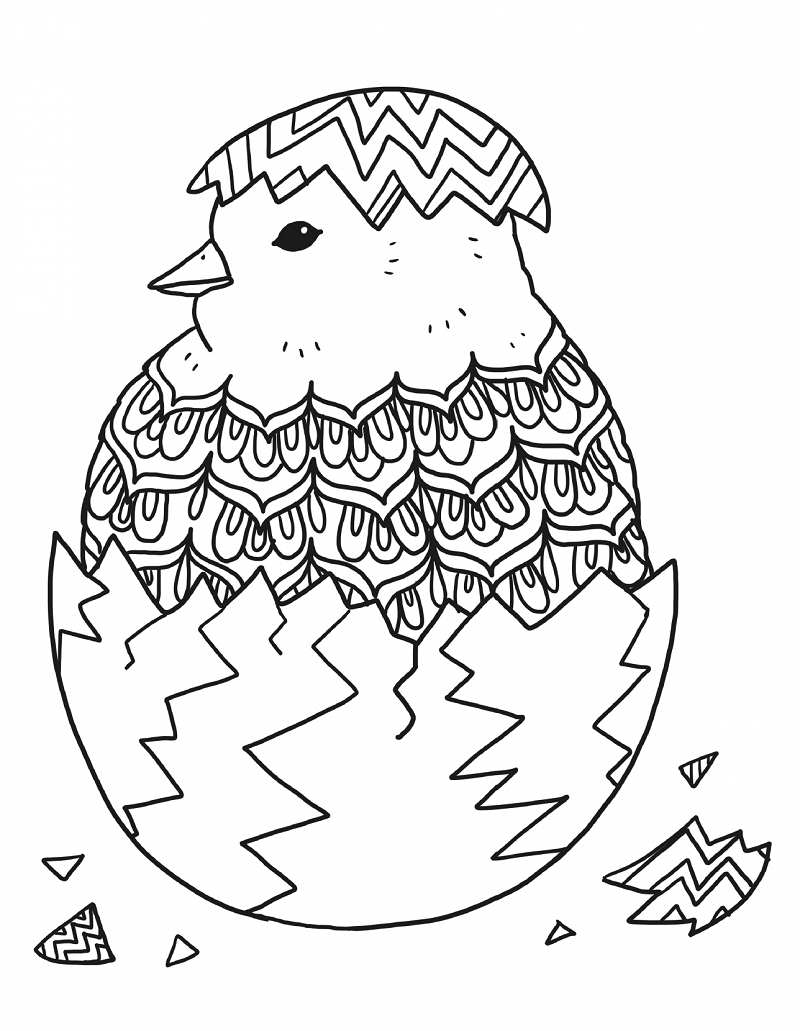
Understanding the World
For those of you who took home a germinating bean to continue growing at home, how are they getting on? Are they giant beanstalks yet? We're looking after Giselle's bean and it's beginning to sprout but not ready to plant in the pot yet. It seems to be enjoying all the lovely sunshine! There's a video below that shows how your bean will continue to grow (it's time lapse so your bean won't grow that quickly unfortunately!) If you don't have your own bean, don't worry, we're growing Giselle's for you too!
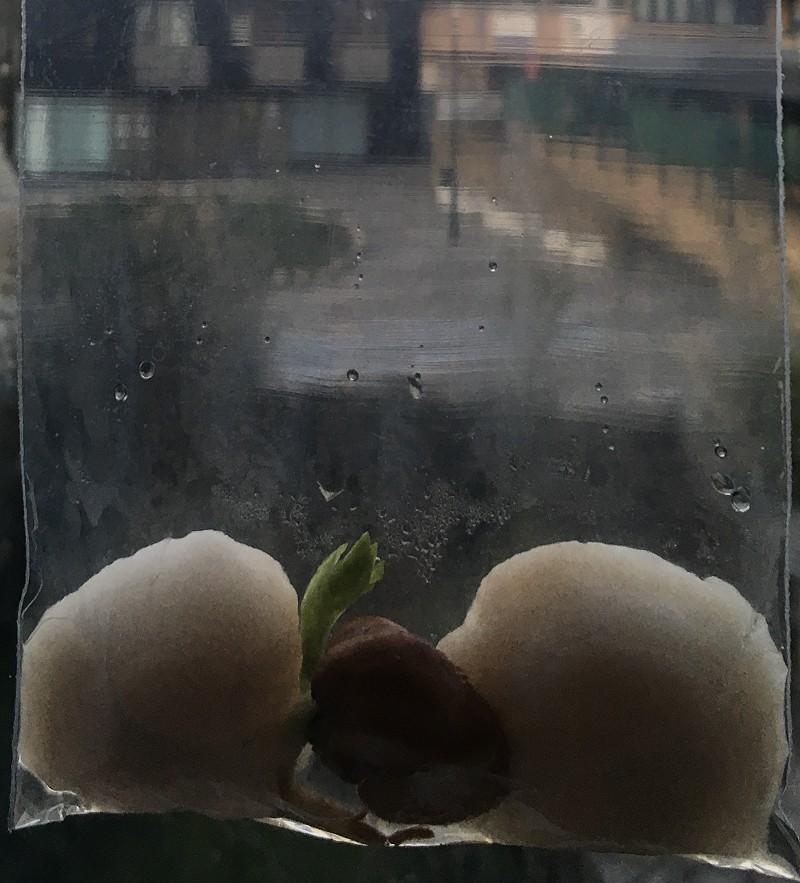
This is Giselle's bean today (Wednesday 1st April) and here is Wilf's amazing sprouting bean. If you would like to share how your bean is growing you can email a photo to: info@scsj.rbkc.sch.uk and we'll put it up on this page.
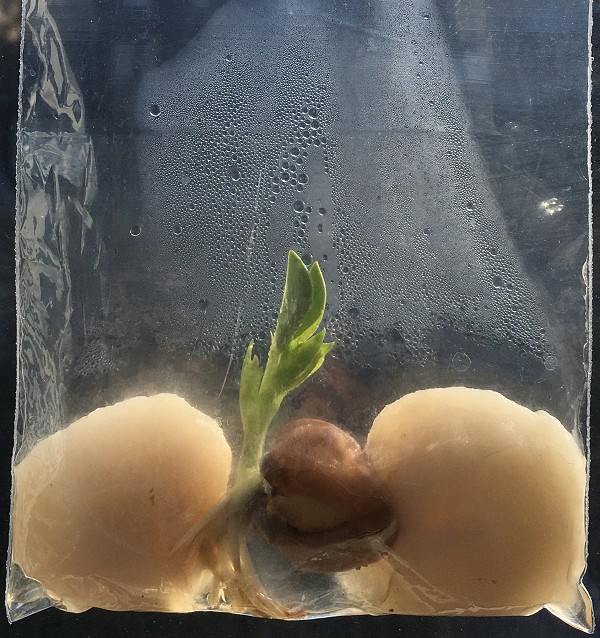
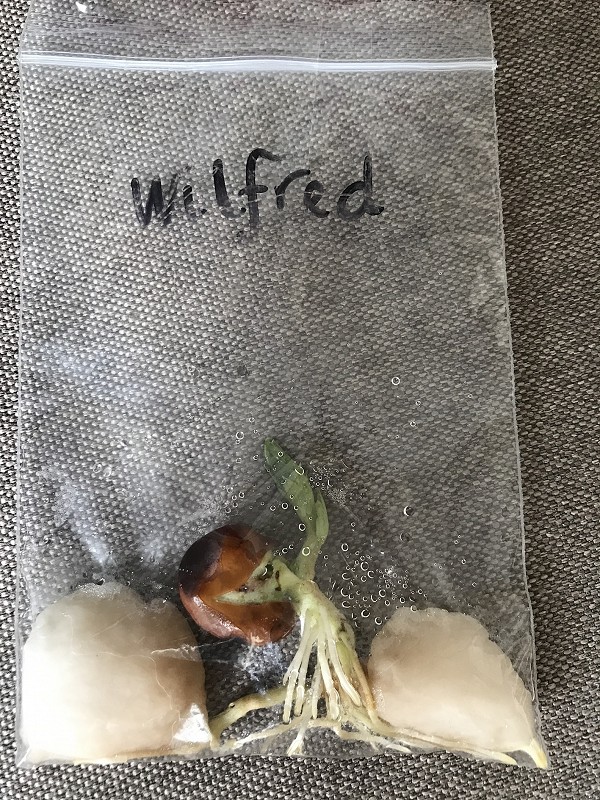
Still growing! (Friday 3rd April)
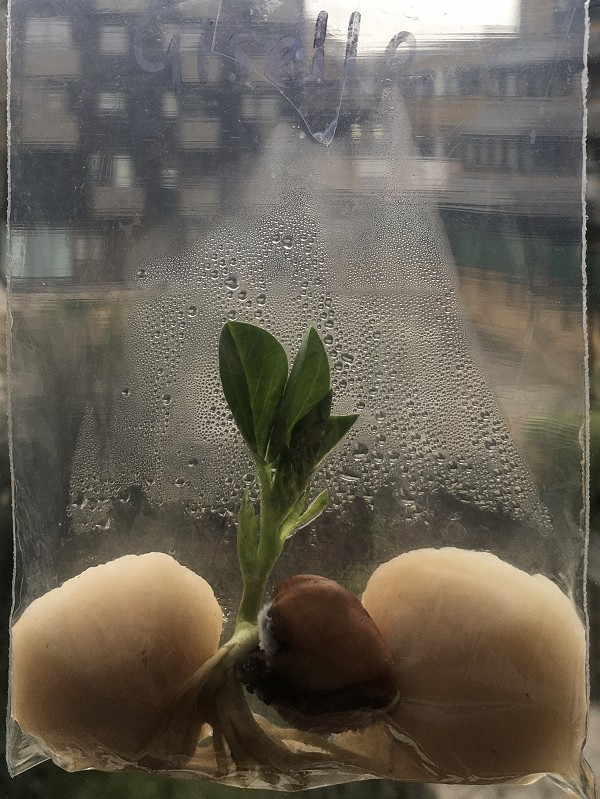
All About Easter
We're still in the period of Lent but Easter is getting closer. We can't explore all about Easter together, but Let's Celebrate will take you on Toby's journey as his family prepares for Easter.
Reading
Please continue to read together regularly, sharing and telling each other stories.
Oxford Owl has free e-books which link to our phonics learning. To use the site, you just need to make an account and all the books are free.

Phonics learning for Reception
Daily phonics practice. Please keep practising your sounds daily. A pdf of our sounds is below but remember you can sing to help you to remember.
You can sing along with our phonics songs here:
https://www.bing.com/videos/se...
If you're not sure how to pronounce each sound, the Lady with the Lips is a fantastic guide:
Here is a powerpoint of all of our sounds. Please go through all of the sounds, making sure you say the sounds clearly and use your actions.
It's also important to keep practising our high frequency (or tricky) words. Here is a pdf of all the words you need to know in reception:
When you're ready to write, you can find our sound mats and high frequency words in Week Commencing 23 March 2020.
For extra phonics practise, we recommend Teach Your Monster to Read as it's an app approved by the Department for Education. You can play on a desktop or laptop or download a free app for your tablet.
Please continue to practise your blending on ictgames.com
Forest Phonics, Help a Hedgehog and Poop Deck Pirates

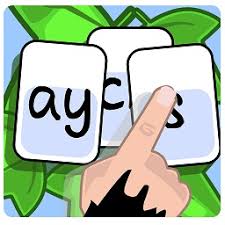
Our nursery rhyme of the week
Our nursery rhyme this week is:
Humpty Dumpty
Humpty Dumpty sat on a wall,
Humpty Dumpty had a great fall;
All the king's horses and all the king's men
Couldn't put Humpty together again.
Maths learning for Reception
This week, we are thinking about adding two groups together and counting on to find the total.
You can choose any real objects in your home, for example some apples and some bananas. Remember to put one group in your head and put the other group on your fingers. Touch your fingers one at a time to your nose to find the total, counting on from the number in your head. Can you write a maths addition sentence to record your answer? Remember it looks like this: 1 + 2 = 3
You can use a number line to help you:

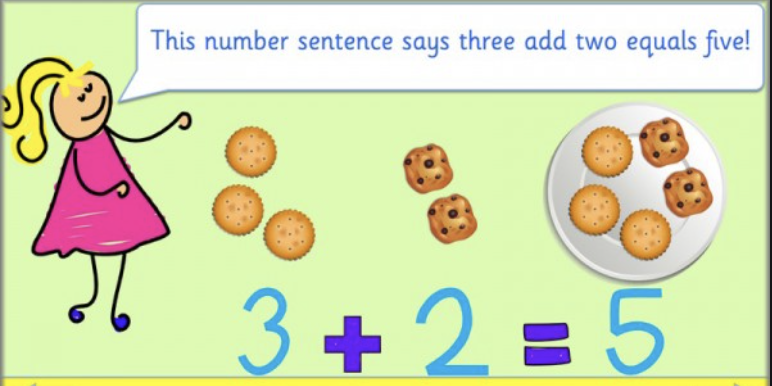
NRich has a lovely activity for addition and subtraction where children have to keep track of objects in a box
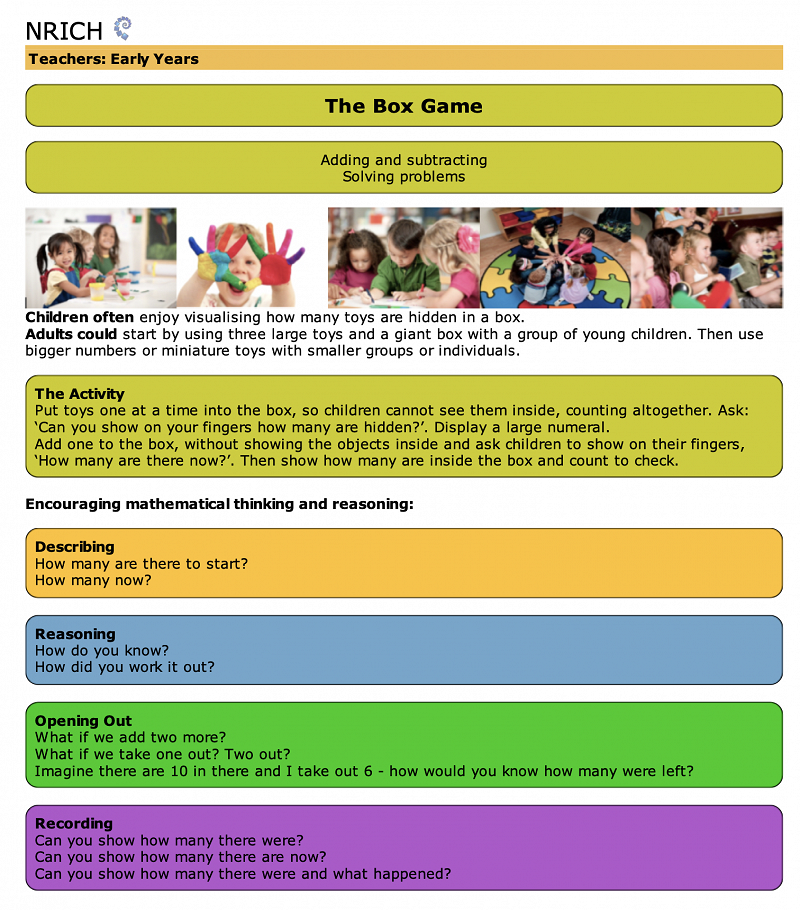
Brain Breaks
Please take some time each day for a brain break to help you calm and relax ready for learning. Ideally this should be first thing in the morning, after lunch and at about 3 o'clock just like we do in school. You can practise along with Ms Afzal (Uz) by using this link:
Our school prayers
Before lunch, can you sing our lunchtime prayer?
Lunchtime Prayer
Thank you for the world so sweet,
Thank you for the food we eat,
Thank you for the birds that sing,
Thank you God for everything.
Amen.
And at the end of the day, please keep saying our School Prayer:
Our School Prayer
Lord of the loving heart,
May ours be loving too.
Lord of the gentle hands,
May ours be gentle too.
Lord of the willing feet,
May ours be willing too.
So may we grow more like you,
in all we say and do.
Amen
We're looking forward to when we can all be together again at school. Love to you all.x
Week Commencing 23rd March 2020
Hello lovely Barn Owls and Little Owls. We hope you are all well. If you can't get outside because you don't have a balcony or garden please have your windows open to let in some fresh air. It's important to keep moving too. We highly recommend Cosmic Kids Yoga on youtube:
https://www.youtube.com/user/C...

We're updating this page weekly but keep checking in regularly as we may have time to do so more often.
The wonderful Twinkl has some great resources to keep you busy (away from screens!) There's a free month of access for parents due to school closures so do go and have a look.
Step 1: Go to www.twinkl.co.uk/offer
Step 2: enter this code CVDTWINKLHELPS
We really like this one:
Reading
There are some lovely stories on CBeebies:
https://www.bbc.co.uk/iplayer/episodes/b00jdlm2/cbeebies-bedtime-stories
Amazon is also offering free audio books for children:
https://stories.audible.com/di...
We highly recommend anything Winnie the Pooh (and Eeyore!)
Drawing
Please do lots of drawing. The more you draw the better you get! Can you do a drawing based on one of our traditional stories or nursery rhymes?
This week's core text
This week we are reading Julia Donaldson's The Troll. If you don't have a copy then never fear, here it is!
Core text ideas:
1. Draw a treasure map for Hank Chief and his pirates to follow. You can make it as imaginative as you like!
2. Write a menu for a meal that WON'T make the crew sick!
3. Build a junk modelling pirate ship. Use whichever resources you can find.
4. What do you think the troll REALLY wants to eat? Can you draw some lovely meals for him?
5. Write a thank you letter from the crew to the troll for his brilliant cooking. Use your sounds and high frequency words to help you.
Phonics learning
Please keep practising your sounds every day and remember to keep learning your high frequency words.
You can sing along with our phonics songs here:
https://www.bing.com/videos/se...
This is our phase 2 sound mat:
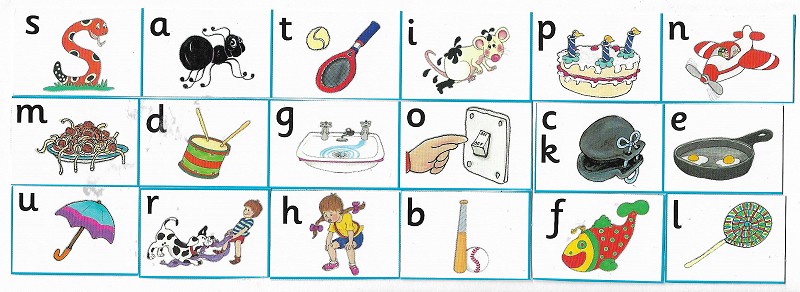
And this is our phase 3 sound mat

These are all the high frequency words you need to do some fabulous writing
When you are writing your sounds, these are the letter formation rhymes to remember and use
and here is a great Read and Race game so you can practise your consonant digraphs: qu, ch, sh, th, ng
Practise your blending on ictgames.com
Forest Phonics, Help a Hedgehog and Poop Deck Pirates
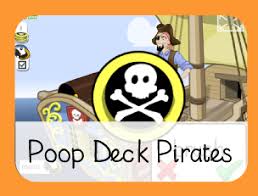
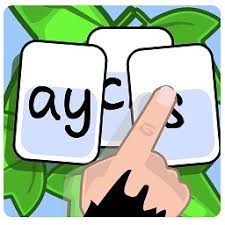
Our nursery rhyme of the week
Our nursery rhyme this week is Hey Diddle Diddle:
Hey diddle diddle
The cat and the fiddle
The cow jumped over the moon
The little dog laughed to see such fun
And the dish ran away with the spoon.
https://www.youtube.com/watch?v=uRCTpupaJK4
please sing along

Maths learning
We are still thinking about doubles. Can you find some pairs of things in your house? Clue: It's Double one!
Can you double your toys just like we doubled our friends? You can also do this with lego or blocks and make some doubling towers.
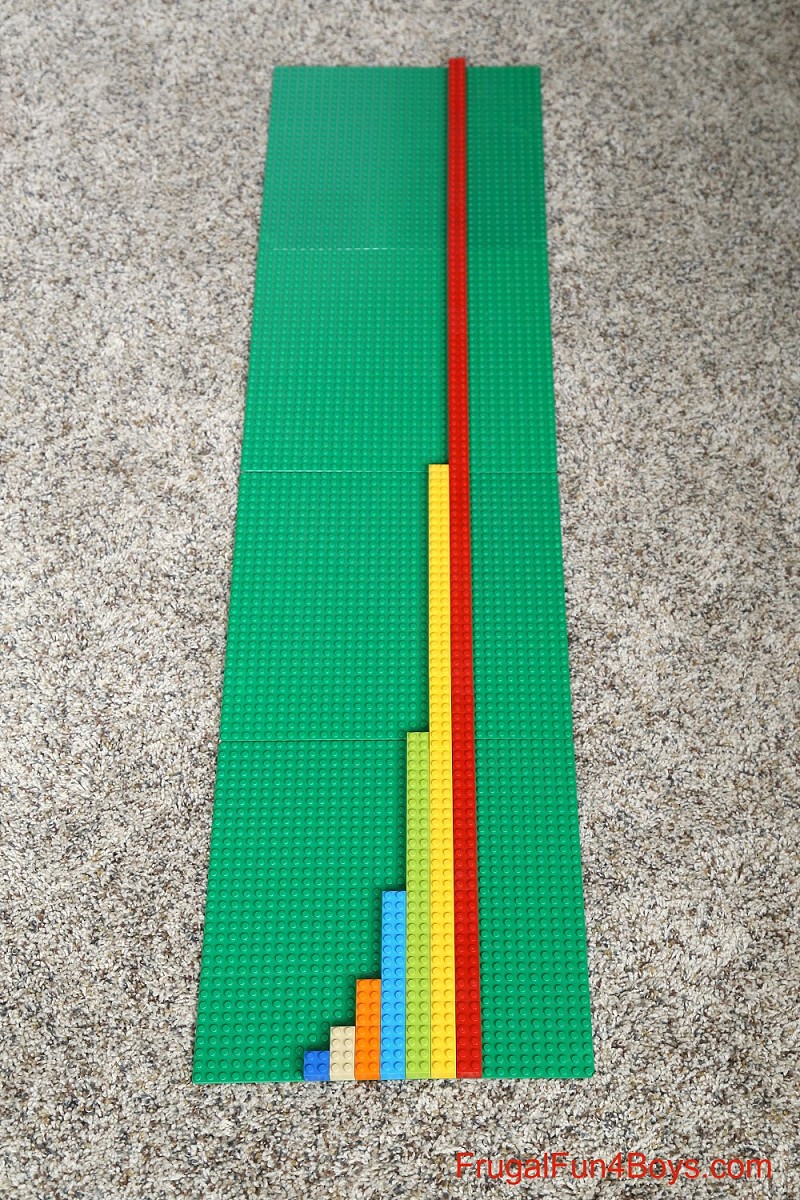
We love NRich, it has some great practical maths activities for Early Years:
This is a great doubling activity
Brain Break
Please take some time each day for a brain break to help you calm and relax ready for learning. Ideally this should be first thing in the morning, after lunch and at about 3 o'clock just like we do in school. You can practise along with Ms Afzal (Uz) by using this link:
https://mindup.org.uk/mindup-activities/
School prayer
We would love you to keep saying our school prayer every day.
Our School Prayer
Lord of the loving heart,
May ours be loving too.
Lord of the gentle hands,
May ours be gentle too.
Lord of the willing feet,
May ours be willing too.
So may we grow more like you,
in all we say and do.
Amen
Please remember, even though we can't be together we are still a team. Love to you all.x





